Microsoft RM-12 GSM900/1800/1900 Cellular Phone w/BT User Manual ReMX UG
Microsoft Mobile Oy GSM900/1800/1900 Cellular Phone w/BT ReMX UG
Manual
Nokia 7710 User Guide
9312134
FCC DRAFT

FCC DRAFT
DECLARATION OF CONFORMITY
We, NOKIA CORPORATION declare under our sole responsibility that the product
RAL-2 is in conformity with the provisions of the following Council Directive:
1999/5/EC. A copy of the Declaration of Conformity can be found at
http://www.nokia.com/phones/declaration_of_conformity/
Copyright © 2004 Nokia. All rights reserved.
Reproduction, transfer, distribution or storage of part or all of the contents in this document in any form without the prior written permission of Nokia is prohibited.
Nokia, Nokia Connecting People, Pop-Port, and Visual Radio are trademarks or registered trademarks of Nokia Corporation. Other product and company names mentioned
herein may be trademarks or tradenames of their respective owners.
Nokia tune is a sound mark of Nokia Corporation.
Java™ and all Java-based marks are trademarks or registered trademarks of Sun Microsystems, Inc.
Bluetooth is a registered trademark of Bluetooth SIG, Inc.
RealPlayer, and the RealPlayer logo are trademarks or registered trademarks of RealNetworks, Inc.
This product includes software licensed from Symbian Software Ltd ©
1998-2004. Symbian and Symbian OS are trademarks of Symbian Ltd.
USE OF THIS PRODUCT IN ANY MANNER THAT COMPLIES WITH THE MPEG-4 VISUAL STANDARD IS PROHIBITED, EXCEPT FOR USE DIRECTLY RELATED TO (A) DATA OR
INFORMATION (i) GENERATED BY AND OBTAINED WITHOUT CHARGE FROM A CONSUMER NOT THEREBY ENGAGED IN A BUSINESS ENTERPRISE, AND (ii) FOR PERSONAL
USE ONLY; AND (B) OTHER USES SPECIFICALLY AND SEPARATELY LICENSED BY MPEG LA, L.L.C.
Nokia operates a policy of continuous development. Nokia reserves the right to make changes and improvements to any of the products described in this document without
prior notice.
Under no circumstances shall Nokia be responsible for any loss of data or income or any special, incidental, consequential or indirect damages howsoever caused.
The contents of this document are provided ‘as is’. Except as required by applicable law, no warranties of any kind, either express or implied, including, but not limited to,
the implied warranties of merchantability and fitness for a particular purpose, are made in relation to the accuracy, reliability or contents of this document. Nokia reserves
the right to revise this document or withdraw it at any time without prior notice
The availability of particular products may vary by region. Please check with the Nokia dealer nearest to you.
EXPORT CONTROLS
This device may contain commodities, technology or software subject to export laws and regulations from the US and other countries. Diversion contrary to law is
prohibited.
FCC/INDUSTRY CANADA NOTICE
Your device may cause TV or radio interference (for example, when using a telephone in closeproximity to receiving equipment). The FCC or Industry Canada can require
you to stop usingyour telephone if such interference cannot be eliminated. If you require assistance, contact your local service facility. This device complies with part 15
of the FCC rules. Operation is subject to
the condition that this device does not cause harmful interference.

3
FCC

4
FCC

FCC DRAFT
Table of Contents
For your safety.......................................... 9
Getting started........................................12
Parts of the device..............................................................12
Front and top side.......................................................12
Base and right side......................................................13
Back.................................................................................13
Installing the SIM card and battery...............................13
Removing and installing the memory card..................15
Charging the battery..........................................................16
Switching on the device....................................................16
First start-up.........................................................................17
Copying from a SIM card to the media device
memory...........................................................................18
Display elements..................................................................18
Navigating and selecting items.......................................19
Basic use of your device....................................................20
Common actions in applications.............................21
Status indicators..................................................................22
Battery level..................................................................22
Signal strength.............................................................22
Data connection indicators.......................................23
General information ...............................24
Stickers in the sales package...........................................24
Access codes.........................................................................24
Memory management........................................................24
Freeing memory...........................................................25
Touch screen and keypad lock.........................................25
Volume control ....................................................................25
Loudspeaker..................................................................26
Headset...........................................................................26
Installing applications and software.............................26
Installing software......................................................27
Installing JavaTM applications................................27
Data transmission...............................................................28
Data connections................................................................29
GSM data calls.............................................................29
High-speed data calls (High Speed Circuit
Switched Data, HSCSD).............................................29
Packet data (General Packet Radio Service, GPRS).
29
Access points................................................................30
Desk..........................................................31
Managing groups................................................................32
Writing text.............................................33
Handwriting recognition...................................................33
On-screen keyboard............................................................34

FCC DRAFT
Pen input settings...............................................................35
Telephone.................................................36
Calling....................................................................................36
Answering......................................................................37
Voice dialling................................................................38
Telephone settings..............................................................38
Call diverting (network service)..............................38
Diverting data & fax calls (network service).......39
Call barring (network service)..................................39
Voice mailbox settings...............................................40
Other settings...............................................................40
Sending DTMF tones...................................................41
Tips for efficient use of Telephone.........................42
Profiles......................................................43
Editing profiles.....................................................................44
Messaging.................................................45
Inbox.......................................................................................45
Outbox statuses...................................................................46
Folders....................................................................................46
E-mail messages..................................................................47
Setting up a remote mailbox...................................47
Advanced e-mail settings.........................................47
Retrieving e-mail from the mailbox......................49
Reading and replying to e-mail..............................49
Sending e-mail.............................................................50
Style of e-mail.............................................................51
Scheduling.....................................................................51
E-mail attachments....................................................51
Signatures......................................................................52
Text messages......................................................................52
Sending text messages..............................................52
Receiving text messages...........................................53
Text message settings................................................54
About text message services....................................54
Multimedia messages........................................................55
Creating multimedia messages...............................55
Receiving multimedia messages.............................57
Multimedia message settings..................................57
Smart messages...................................................................58
Service messages.................................................................59
Contacts ...................................................60
Viewing and searching for contacts..............................60
Creating and editing contacts.........................................60
Contact card fields......................................................61
Transferring contacts.........................................................62
Voice tags..............................................................................62
Contact groups....................................................................62
Calendar ...................................................64
Day view................................................................................64
Managing entries................................................................64
Week view.............................................................................65

FCC DRAFT
Icons........................................................................................66
To-do........................................................67
Grouping to-do notes.........................................................67
Icons........................................................................................67
Web..........................................................68
Plug and play mobile services..........................................68
Using the web browser......................................................68
Navigating.....................................................................69
Bookmarks......................................................................70
Viewing page, cache, plug-in, history, and
download details..........................................................70
Web browser settings.................................................71
Camera ....................................................73
Camera mode........................................................................73
Taking pictures.............................................................73
Camcorder mode..................................................................74
Camera settings...................................................................74
General page.................................................................74
Image page....................................................................74
Video page.....................................................................75
Tips on taking good photographs...................................75
Picture quality..............................................................75
Background....................................................................75
Depth...............................................................................75
Lighting conditions......................................................75
Images......................................................77
Viewing images....................................................................77
Managing images and folders.........................................77
Image settings......................................................................79
Special features of some image formats......................79
Editing images......................................................................79
Drawing tools...............................................................80
Transformations...........................................................80
RealPlayer................................................81
Playing videos.......................................................................81
Managing videos.................................................................82
Music player............................................84
Music player controls.........................................................84
Playing tracks.......................................................................84
Managing tracks..................................................................85
Track lists...............................................................................86
Visual Radio.............................................87
Listening to radio................................................................87
Viewing content...........................................................88
Preset channels....................................................................88
Visual Radio settings..........................................................89
Voice recorder.........................................90
Recording and playing.......................................................90
Managing sound clips........................................................90

FCC DRAFT
Voice recorder settings......................................................91
Documents................................................92
Working with documents.................................................92
Editing paragraph styles...................................................93
Sheet.........................................................94
Workbooks............................................................................94
Working with worksheets.................................................94
Formatting worksheets......................................................95
Chartsheets...........................................................................95
Presentations............................................97
Clock.........................................................98
Alarms....................................................................................98
Cities and countries............................................................99
Calculator.............................................. 100
Using calculator memory................................................100
Constant function.............................................................101
Control panel ........................................102
Application manager........................................................102
Bluetooth.............................................................................103
Certificate manager.........................................................103
Checking the authenticity of a certificate.........105
Data call barring................................................................105
Date and time....................................................................105
Display..................................................................................106
Enhancements....................................................................106
Internet setup.....................................................................107
Setting up an Internet access point.....................107
Advanced Internet settings....................................108
Internet connection settings..................................110
Memory................................................................................111
Pen input settings.............................................................111
Positioning settings..........................................................111
Priority..........................................................................111
Details...........................................................................111
Privacy settings..................................................................111
General page...............................................................112
Individual page...........................................................112
RealPlayer settings...........................................................112
Network........................................................................112
Proxy.............................................................................113
Regional settings...............................................................113
Time...............................................................................113
Date...............................................................................113
Numbers.......................................................................113
Currency.......................................................................113
Security................................................................................114
Device lock..................................................................114
PIN codes.....................................................................114
Call barring..................................................................115
Screen calibration.............................................................115
Themes.................................................................................115

FCC DRAFT
Device language................................................................115
Service commands............................................................115
File manager..........................................116
Managing files...................................................................116
Managing folders..............................................................116
Managing memory cards................................................117
Log..........................................................118
Recent calls........................................................................118
Call duration and GPRS data counter.........................119
Cell broadcast........................................120
Reading and managing messages................................120
Managing topics...............................................................120
Cell broadcast settings....................................................121
Connectivity...........................................122
Bluetooth connection......................................................122
Activating Bluetooth application for the first time
122
Sending data via Bluetooth...................................123
Receiving data via Bluetooth................................123
Paired devices............................................................123
Connecting your media device to a compatible
computer .............................................................................124
Using the CDROM......................................................125
Using your media device as a modem.................125
Nokia PC Suite 6........................................................125
Copying data from compatible devices...............125
Remote configuration (network service)....................125
Creating a new configuration server profile......126
Data transfer......................................................................127
Synchronisation.................................................................127
Creating a new synchronisation profile..............127
Troubleshooting.....................................129
Troubleshooting.................................................................129
Battery information..............................132
Charging and Discharging..............................................132
CARE AND MAINTENANCE..................133
ADDITIONAL SAFETY INFORMATION..134
Index.......................................................138

FCC DRAFT
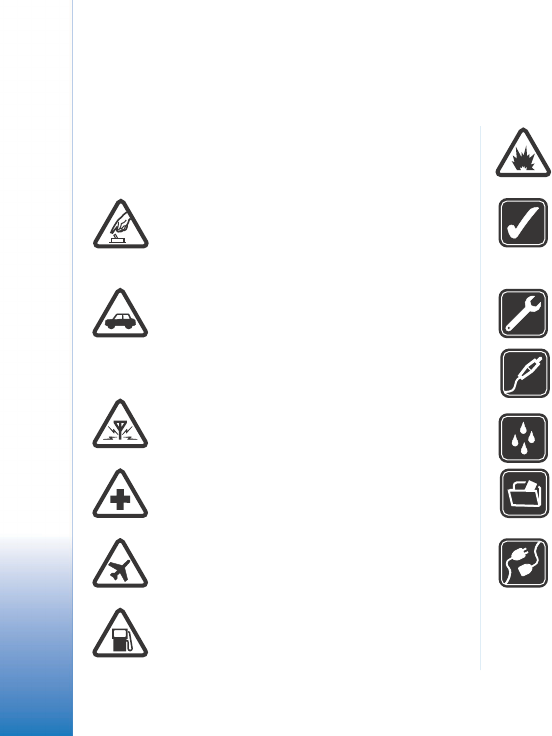
9
FCC DRAFT
For your safety
Read these simple guidelines. Not following them may be
dangerous or illegal. Read the complete user guide for
further information.
SWITCH ON SAFELY Do not switch the
device on when wireless phone use is
prohibited or when it may cause interference
or danger.
ROAD SAFETY COMES FIRST Obey all local
laws. Always keep your hands free to operate
the vehicle while driving. Your first
consideration while driving should be road
safety.
INTERFERENCE All wireless devices may be
susceptible to interference, which could
affect performance.
SWITCH OFF IN HOSPITALS Follow any
restrictions. Switch the device off near
medical equipment.
SWITCH OFF IN AIRCRAFT Follow any
restrictions. Wireless devices can cause
interference in aircraft.
SWITCH OFF WHEN REFUELLING Do not
use the device at a refuelling point. Do not
use near fuel or chemicals.
SWITCH OFF NEAR BLASTING Follow any
restrictions. Do not use the device where
blasting is in progress.
USE SENSIBLY Use only in the normal
position as explained in the product
documentation. Do not touch the antenna
unnecessarily.
QUALIFIED SERVICE Only qualified personnel
may install or repair this product.
ENHANCEMENTS AND BATTERIES Use only
approved enhancements and batteries. Do not
connect incompatible products.
WATER-RESISTANCE Your device is not
water-resistant. Keep it dry.
BACK-UP COPIES Remember to make back-
up copies or keep a written record of all
important information.
CONNECTING TO OTHER DEVICES When
connecting to any other device, read its user
guide for detailed safety instructions. Do not
connect incompatible products.
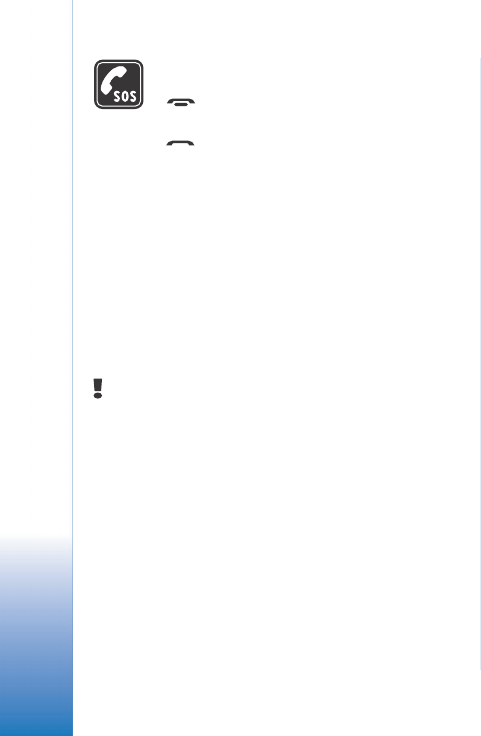
10
FCC
EMERGENCY CALLS Ensure the device is
switched on and in service. Press and hold
to show the phone keypad on the screen.
Key in the emergency number, then press
. Give your location. Do not end the call
until given permission to do so.
About your device
The wireless device described in this guide is approved for
use on the EGSM 900, GSM 1800, and GSM 1900
networks. Contact your service provider for more
information about these networks.
When using the features in this device, obey all laws and
respect privacy and legitimate rights of others.
WARNING: To use any features in this device, other
than active alarms, the device must be switched on. Do
not switch the device on when wireless phone use may
cause interference or danger.
Network services
To use the phone you must have service from a wireless
service provider. Many of the features in this device
depend on features in the wireless network to function.
These network services may not be available on all
networks or you may have to make specific arrangements
with your service provider before you can utilise network
services. Your service provider may need to give you
additional instructions for their use and explain what
charges will apply. Some networks may have limitations
that affect how you can use network services. For
instance, some networks may not support all language-
dependent characters and services.
Your service provider may have requested that certain
features be disabled or not activated in your device. If so,
they will not appear on your device menu. Contact your
service provider for more information.
This device supports WAP 2.0 protocols (HTTP and SSL)
that run on TCP/IP protocols. Some features of this device,
such as those used with MMS and Web browser require
network support for these technologies.
Shared memory
The following features in this device may share memory:
contacts, text messages, multimedia messages, images,
ringing tones, audio files, video clips, calendar and to-do
notes, and downloaded applications. Use of one or more of
these features may reduce the memory available for the
remaining features sharing memory. For example, saving
many images may use all of the available memory. Your
device may display a message that the memory is full
when you try to use a shared memory feature. In this case,
delete some of the information or entries stored in the
shared memory features before continuing.

11
FCC
Enhancements, batteries, and
chargers
Check the model number of any charger before using it
with this device. This device is intended for use when
supplied with power from ACP-12 and AC-1.
WARNING: Use only batteries, chargers, and
enhancements approved by Nokia for use with this
particular model. The use of any other types may
invalidate any approval or warranty, and may be
dangerous.
Always switch the device off and disconnect the charger
before removing the battery.
For availability of approved enhancements, please check
with your dealer. When you disconnect the power cord of
any enhancement, grasp and pull the plug, not the cord.
Your device and its enhancements contains small parts.
Keep them out of reach of small children.
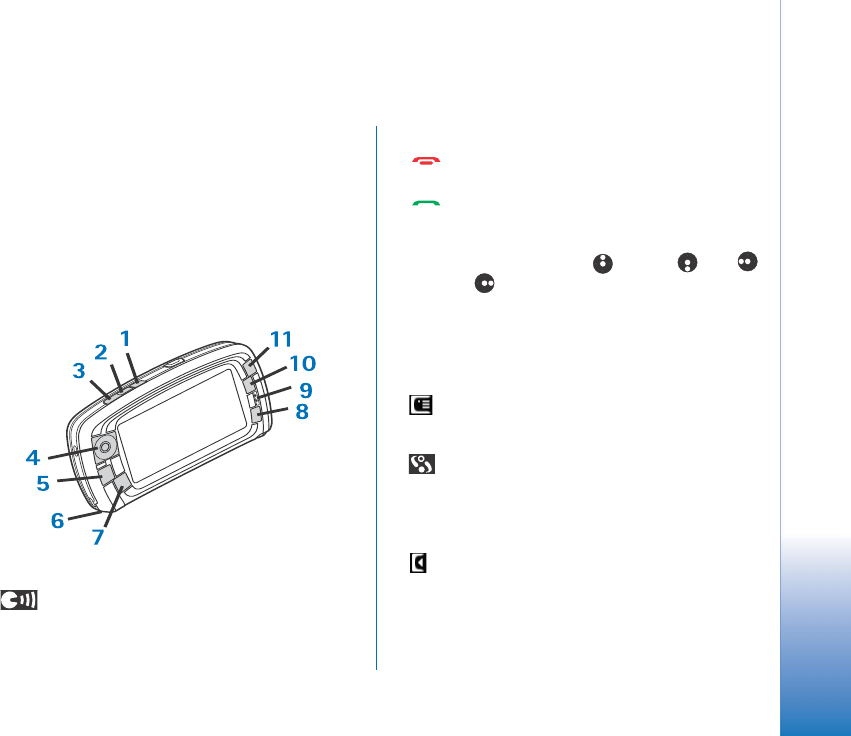
Getting started
12
FCC DRAFT
Getting started
The Nokia 7710 media device provides a variety of media
applications, such as a camcorder, a music player, Visual
RadioTM, RealPlayer, and a Web browser. Additionally, the
device contains various useful functions , such as a word
processor, a clock, a calculator, and a calendar.
Parts of the device
Front and top side
Fig. 1 Front and top side
1 Voice key. Press to swap between the
loudspeaker and earpiece during a voice call. Press to
start or end voice recording. Press and hold to activate
voice dialling.
2 Press to end or reject a call. Press to open the
Dialler view of the Telephone application.
3 Press to answer a call. In the Telephone
application’s Dialler view and in Desk, press to view the
most recently called numbers.
4Scroll key. Press on the top , bottom , left ,
and right to move the cursor on the screen, and to
select items. Press in the middle to activate or select.
Press to call a dialled number, a selected speed dial
number, or a selected contact. Press on the right and
left to adjust the volume of the earpiece, headset, and
loudspeaker.
5 Menu key. Press to open the menu. Press
repeatedly to move between dialog pages.
6Microphone
7 Desk key. Press to open the Desk application,
which is the main view for the device. For more
information, see “Desk” on page 31. A long press opens
a list of recently used applications that you can switch
to.
8 Esc key. Closes dialogs or returns to previous view.
It also cancels actions in dialogs where Cancel button
is available.
9Earpiece
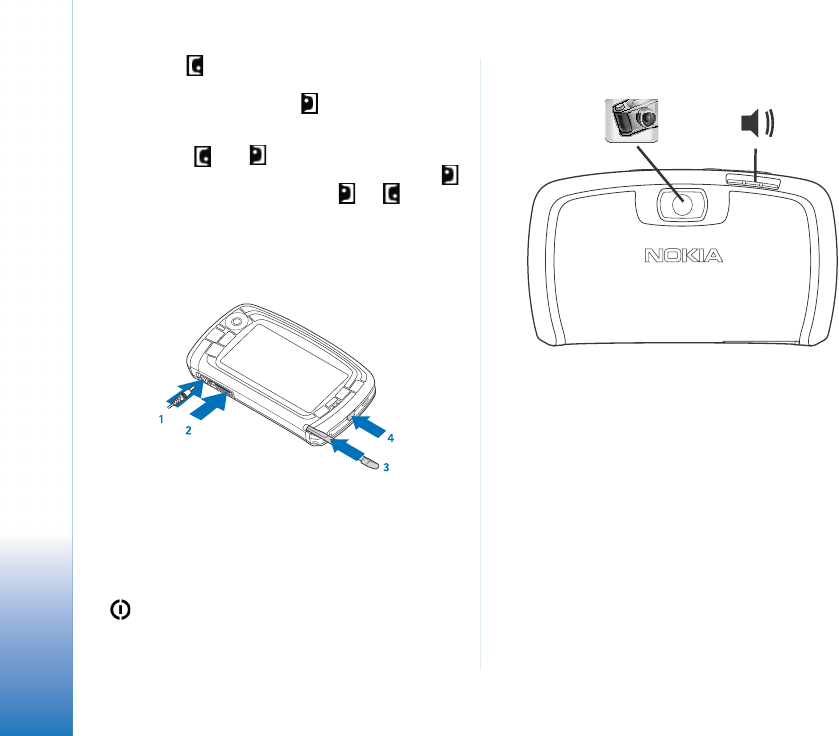
Getting started
13
FCC
10Switch key enables switching between different
views in an application.
11Zoom key. When applicable, makes the zoom
option available,
The function of and keys depends on the
application and the current view. During a call, press
to open the audio settings and press or to
decrease or increase the volume level, respectively. These
two buttons are also used for playing games.
Base and right side
Fig. 2 Base and right side
1Charger connector
2Pop-Port connector for headsets, connectivity cable,
and loopset.
3Stylus holder.
4 Power key. Press and hold to switch the device on
or off. Press briefly to change a profile.
Back
Fig. 3 Camera lens and loudspeaker
Installing the SIM card and
battery
• Keep all SIM cards out of the reach of small children.
For availability and information on using SIM card
services, contact your SIM card vendor. This may be the
service provider, network operator, or another vendor.
• The SIM card and its contacts can be easily damaged
by scratching or bending, so be careful when handling,
inserting, or removing the card.
• Before removing the back cover, always switch off the
power, and disconnect the charger and any other
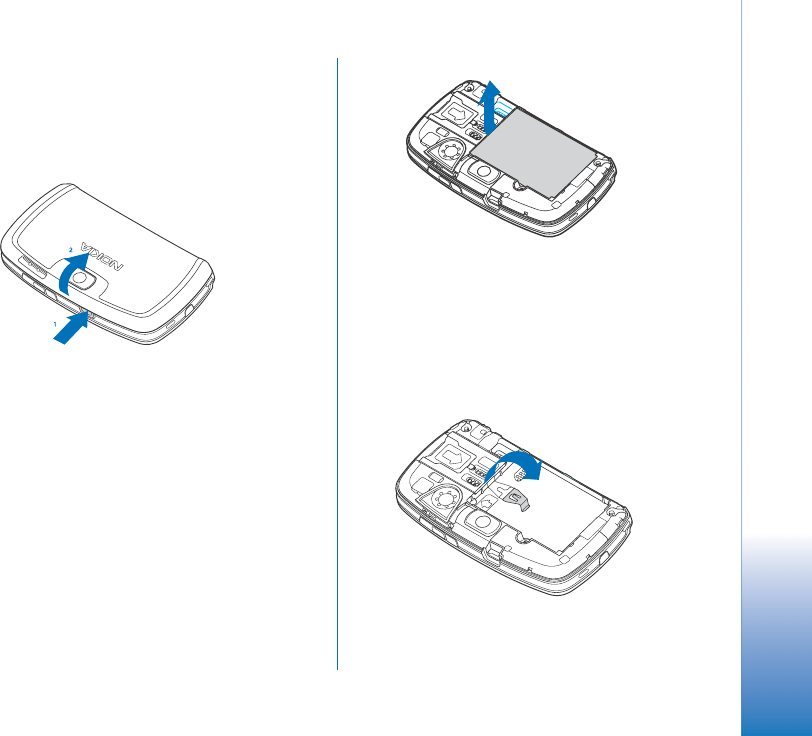
Getting started
14
FCC
enhancements from the device. Always store and use
the device with the back cover attached.
1To remove the back cover, with the back of the device
facing you, press the back cover release button and lift
off the back cover (See fig. 4).
Fig. 4 Removing the back cover
2If the battery is installed in the device, lift the battery
out of the device. (See fig 5).
Always switch the device off, and disconnect the
charger before removing the battery.
Fig. 5 Removing the battery
3Open the SIM card slot latch (See fig. 6) and slide the
SIM card sideways into the SIM card slot (See fig. 7).
Make sure that the bevelled corner of the SIM card is
pointing inwards into the slot and that the golden
contact area on the card is facing downwards.
Fig. 6 Opening the SIM card slot latch
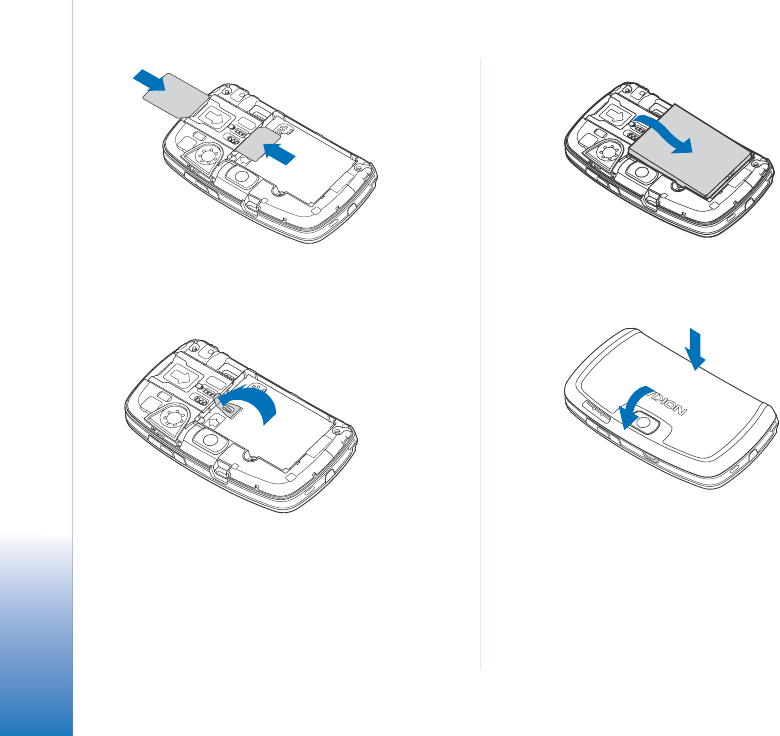
Getting started
15
FCC
Fig. 7 Inserting the SIM card and the memory card
4Close the SIM card slot latch (See fig. 8).
Fig. 8 Closing the SIM slot latch
5To insert the battery, align the golden contacts of the
battery with the corresponding connectors on the
battery compartment. Press down on the opposite end
of the battery until it snaps into place (See fig. 9).
Fig. 9 Inserting the battery
6Press the cover into place. (See fig. 10)
Fig. 10 Replacing the back cover
Removing and installing the
memory card
Your media device comes with a ready-to-use memory
card (MMC). The card may contain some pre-installed files

Getting started
16
FCC
and applications. You can use this memory card to manage
your files, applications, back-ups, and so on, in the same
way as corresponding items on the media device.
Important: Do not remove the card in the middle of an
operation. Removing the card in the middle of an
operation may damage the memory card as well as the
device, and data stored on the card may be corrupted.
Keep all memory cards out of the reach of small children.
To remove the memory card, remove the back cover
with the back of the device facing you, by pressing the
back cover release button and lifting off the back cover
(See fig. 4). Remove the memory card by gently pulling
it out of the slot. Be careful not to scratch the golden
contacts of the card.
To install the memory card, remove the back cover
with the back of the device facing you, by pressing the
back cover release button and lifting off the back cover
(See fig. 4). Gently push the memory card into place
(See fig. 7). Make sure that the gold contacts of the
card are facing down.
Note: Use only compatible MultiMedia Cards (MMC)
with this device. Other memory cards, such as Secure
Digital (SD) cards, do not fit in the MMC card slot and
are not compatible with this device. Using an
incompatible memory card may damage the memory
card as well as the device, and data stored on the
incompatible card may be corrupted.
Charging the battery
While charging, do not use features such as Web browser
or RealOne player, which consume a lot of power. Too
many power-consuming activities may prevent the
battery from charging properly.
1Connect the charger connector to the base of the
media device (See fig.2 on page 13).
2Connect the charger to a wall outlet. The battery
indicator bar starts scrolling in the status indicator
area. The media device can be used while charging. If
the battery is completely discharged, it may take up to
a few minutes before the charging indicator is shown.
3When the battery is fully charged, the bar stops
scrolling. Disconnect the charger from the media
device, then from the outlet.
See also “Battery information” on page 132 and
“Enhancements, batteries, and chargers” on page 11.
Switching on the device
WARNING: To use any features in this device, other
than active alarms, the device must be switched on. Do
not switch the device on when wireless phone use may
cause interference or danger.
To switch the device on or off, press and hold the
power key . This device can be used without the
phone functions when the Flight profile is selected. For
more information, see “Profiles” on page 43.

Getting started
17
FCC
If the device requests a PIN code, enter the code
(displayed as ****), and tap OK. The PIN code protects
your SIM card against unauthorised use and is usually
supplied with the SIM card. After three consecutive
incorrect PIN code entries, the PIN code is blocked, and
you must unblock it with a PUK code before you can
use the SIM card again. If the codes are not supplied
with the SIM card, contact the operator whose SIM
card is in your media device.
If the device requests a lock code, enter the code
(displayed as *****) and tap OK. The lock code protects
your device against unauthorised use. The factory
setting for the lock code is 12345. Change the code,
and keep the new code secret and in a safe place
separate from your device. The lock code can be from
5 to 10 digits.
Note: Your device has an
internal antenna. As with any other
radio transmitting device, do not
touch the antenna unnecessarily
when the device is switched on.
Contact with the antenna affects
call quality and may cause the
device to operate at a higher power
level than otherwise needed.
Avoiding contact with the antenna
area when operating the device
optimises the antenna performance
and the battery life.
The picture shows how you should
hold your device when talking on the
phone. The antenna area is shown in
grey.
First start-up
When you start up your media device for the first time, you
are asked to calibrate the touch screen and define certain
settings.
All the settings can later be modified in the Control Panel
application or in relevant applications.
1Upon start-up the media device performs a self-test.
After the self-test is complete, you are asked to
calibrate the touch screen. Follow the instructions on
the screen.
2If the device requests a PIN code, enter the code
(displayed as ****), and tap OK. A welcome screen
appears.
3 To have the time and date set automatically, select the
Auto-update: check box. Tap Finish. If you select the
Auto-update option and the service is available, the
device needs to be restarted. If auto-update is selected
by default and the service is available, Settings (see
step 6 below) dialog is displayed. Note that some
network operators may not support the Auto-update
feature.

Getting started
18
FCC
4If Auto-update is not active or available, specify a
home city for the device.
5If Auto-update is not active set the time and date. If
you do not want to continue with the setup, tap Finish.
6You can edit a variety of optional settings, such as e-
mail account settings or your personal details. Select
from the list the setting you want to edit, and tap
Open. If you do not want to edit the settings now, tap
Finish to complete the setup.
Copying from a SIM card to the media
device memory
If you have stored names and phone numbers on a SIM
card, you can copy them to the media device memory.
To transfer all the contacts, open the Contacts
application, press , and select Tools > Copy SIM
directory to Contacts.... Tap Copy. To transfer individual
contacts, open the Contacts application, press ,
and select Tools > SIM directory.... Select the contact and
tap Copy to Contacts.
Display elements
Fig. 11 Desk
1Title area. Displays the application name and group
name or other details about the status of the
application. Tap to access the menus or press .
2Status indicator area. For status icons, see “Status
indicators” on page 22.
3Toolbar. Contains either shortcuts to often used
applications or, in an application, a shortcut to useful
tools. To hide the toolbar, press , and select
Display. Clear the Toolbar.
4Scroll bar. Tap or drag to scroll the screen.
Your device has a screen saver. If there are no actions for
a specified time period, the screen saver becomes visible.
To deactivate the screen saver, tap the screen or press any
key. Note that you cannot change the look of the screen
saver. For more information, see “Display” on page 106.
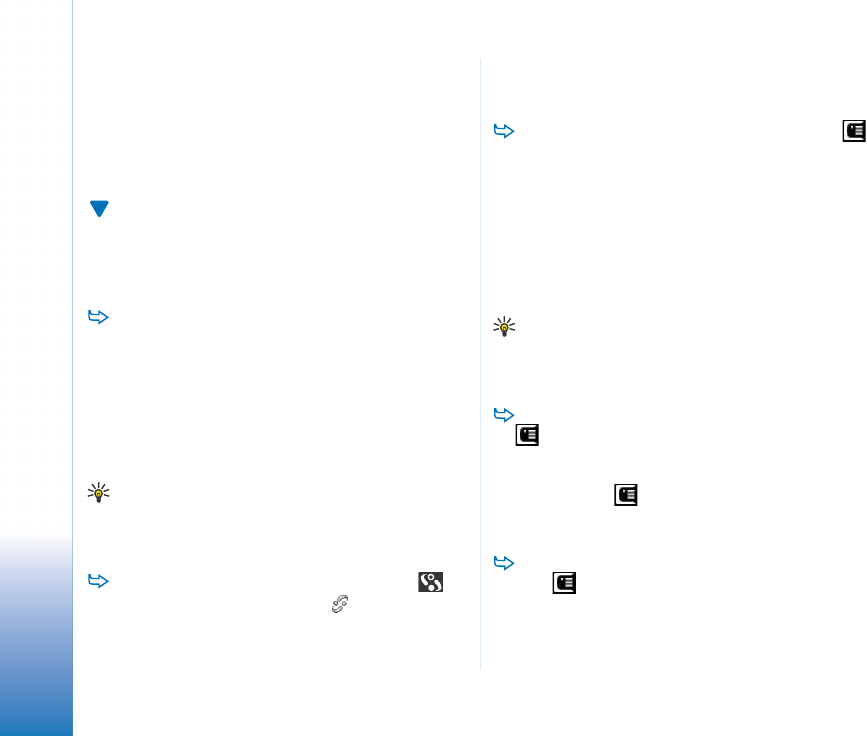
Getting started
19
FCC
Navigating and selecting items
In most cases there are two ways to control the device: by
pressing the scroll key and other buttons on the device or
by tapping the screen with the included stylus. You can
mix these two methods to find the way that best suits
you. To locate the stylus, see Fig.“2” on page 13.
Important: Use only a stylus approved by Nokia for
use with this device. Using any other stylus may invalidate
any warranty applying to the device and may damage the
screen. Avoid scratching the screen. Never use an actual
pen or pencil or other sharp object to write on the screen.
To open applications, double-tap on an application
icon in Desk, or scroll to the application, and press the
centre of the scroll key. To open folders, files, or
attachments, double-tap the item, or scroll to it, and
press the centre of the scroll key.
The expression ‘double-tap’ is used here to describe the
process of first tapping with the stylus on an item to
select it and then tapping on the item again to open it.
Tip: If the touch screen is not responding correctly,
you may need to calibrate it. Use the scroll key to open
the Control Panel application, select Screen calibration,
and follow the instructions.
To exit applications and return to Desk, press on
the left side of the screen, or tap on the status
indicator area. To view its exact location on the screen,
see fig. “11” on page 18. Desk is your workspace where
you can access all applications and create shortcuts to
different items such as documents, images, or contact
cards. For more information, see “Desk” on page 31.
To select menu commands in applications, press ,
scroll to the command and press the centre of the scroll
key to select the command. Alternatively, tap the title
area (see “Display elements” on page 18) of the
window to open the menu, tap the menu, and tap the
command.
In most of the applications, some of the most useful
menu commands are also available on the command
buttons on the right side of the screen.
Tip: The menu commands and command buttons
change according to what is selected on the screen.
Scroll to an item or tap it ; then select the appropriate
menu command or command button.
To select individual list items or files, tap it, press
, and select Edit > Mark/Unmark > Mark. Now you
can tap to mark the rest of the items. A check mark is
placed next to the selected items. To select all items
in a list, press and select Edit > Mark/Unmark >
Mark all. To select consecutive items, drag the stylus
over the files.
To show or hide the command buttons or toolbar,
press , and select Display > Command bar or Toolbar.
When a command button is dimmed, it cannot be used.
The command buttons on the right side, the toolbar at
the bottom, and the status indicators on the top right
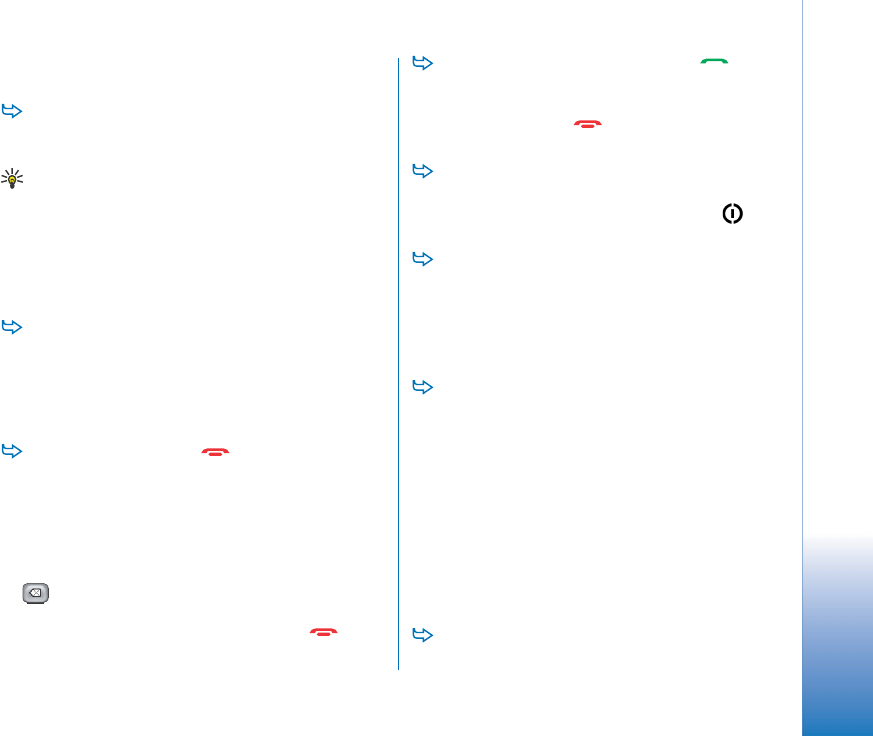
Getting started
20
FCC
corner of the display change according to the
application and current situation.
To activate parts of a dialog, tap them. Try tapping
dialog fields like text boxes, window frames, and other
parts of the display.
Tip: If you write a phone number, e-mail address, or
web address in a text box or document, you can use it
as a hyperlink. Tap on the number or address, or move
the cursor inside it with the scroll key; it becomes a link
with a small icon. Tap the icon to call the phone
number, to open the e-mail editor, or to access the web
site if you have an active Internet connection.
To drag an item, tap it and keep the stylus in contact
with the screen for about a second and move the item
to its new location. Try this with the Desk applications.
Basic use of your device
To make a call, press the key on the top side of
the device to open the Dialler view. You can also open
the Dialler by double-tapping the Telephone
application in Desk, or tapping the telephone icon on
the toolbar, if available. Enter the telephone number
using the screen keypad of the Dialler view, and tap
Call. If you make a mistake when entering numbers, tap
to clear numbers. The microphone and earpiece
are on the front side of the device (See fig “1” on
page 12). To end a call, tap End, or press .
To answer a call, tap Answer, or press on the
top side of the device. To locate the microphone and
the earpiece see fig.“1” on page 12. To reject a call,
tap Reject, or press . For more information, see
“Telephone” on page 36.
To turn off the sounds of the device, select the
Silent profile. To select the profile, either open the
Profiles application, or press the power key and
select Silent from the list.
To write text, tap the text field or box where you want
to enter text. The on-screen keyboard or handwriting
recognition window opens. Start typing by tapping the
characters in the keyboard or writing letters in the text
input field. For more information, see “Writing text” on
page 33.
To take a picture or record video, open the Camera
application. The camera lens is at the back of the
camera above the back cover (see fig. “2” on page 13).
To switch between camera and camcorder mode,
tap a corresponding picture on the left side of the
screen. Aim at the target using the display as a
viewfinder; press the centre of the scroll key, or tap
Capture to take the picture. To record video, press
Record. The image or video is saved to a folder shown
in the title bar area. If you do not want to keep the
picture, tap Delete. For more information, see
“Images” on page 77.
To listen to the radio, connect a compatible headset
to the device. The lead of the headset functions as the
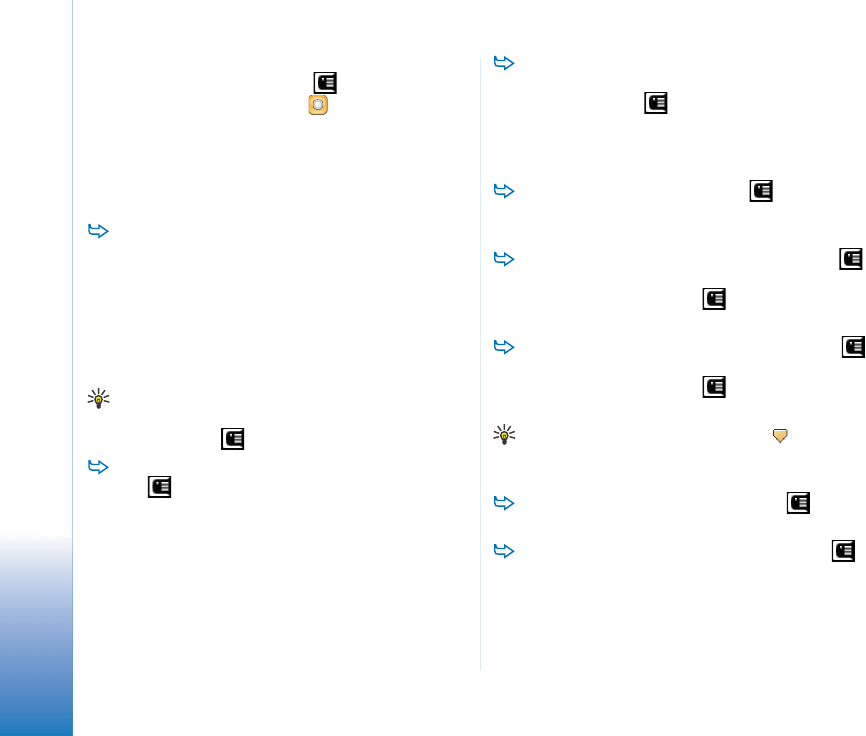
Getting started
21
FCC
antenna of the radio, so let it hang freely. Open the
Visual Radio application, press , and select Tools >
Speaker in use > Headset. Press to start listening to
the radio. You can use Visual Radio both for listening
to ordinary FM radio broadcasts and special
broadcasts with simultaneous visual content, if
available. For more information, see “Visual Radio” on
page 87.
To search through all the applications and files in
the device for specific text strings or file types, open
the Find application, and tap Find. Write the text in
the search field, and tap Find. To make the search
more accurate, tap Advanced search, write the text
in the search field, specify the location and the date
range of the search, and tap OK. Tap the found item to
open it.
Tip: You can also search for text strings within
applications, if this function is available as a menu
command. Press ,and select Edit > Find....
To create folders, open the File manager application.
Press and select File > New folder.... Give the new
folder a name, and select a location. In some of the
applications you can create a new folder if you first
select the Change folder menu command in the menu.
Common actions in applications
You can find the following actions in several applications:
To add a shortcut to an item, select an item in the File
manager application or another application that
handles files, press , and selectAdd to Desk... menu
command, if available. In Images, for example, select
Tools > Add to Desk.... Select the Desk group to which
you want to add the shortcut, and tap OK.
To send items, select an item, press , and select File
>Send command, if available. Select the appropriate
method of sending.
To cut and paste an item, select an item, press ,
and select Edit > Cut. Select the location where you
want to add the item, press , and select Edit >
Paste.
To copy and paste an item, select an item, press ,
and select Edit > Copy. Select the location where you
want to add the item, press , and select Edit >
Paste.
Tip: Some dialogs have an arrow icon in the top
left corner. Tap the icon to cut or copy the selected
text, or to paste text into the selected field.
To delete an item, select an item, press , and
select File > Delete.
To zoom in or zoom out on the display, press ,
and select Display > Zoom in or Zoom out.
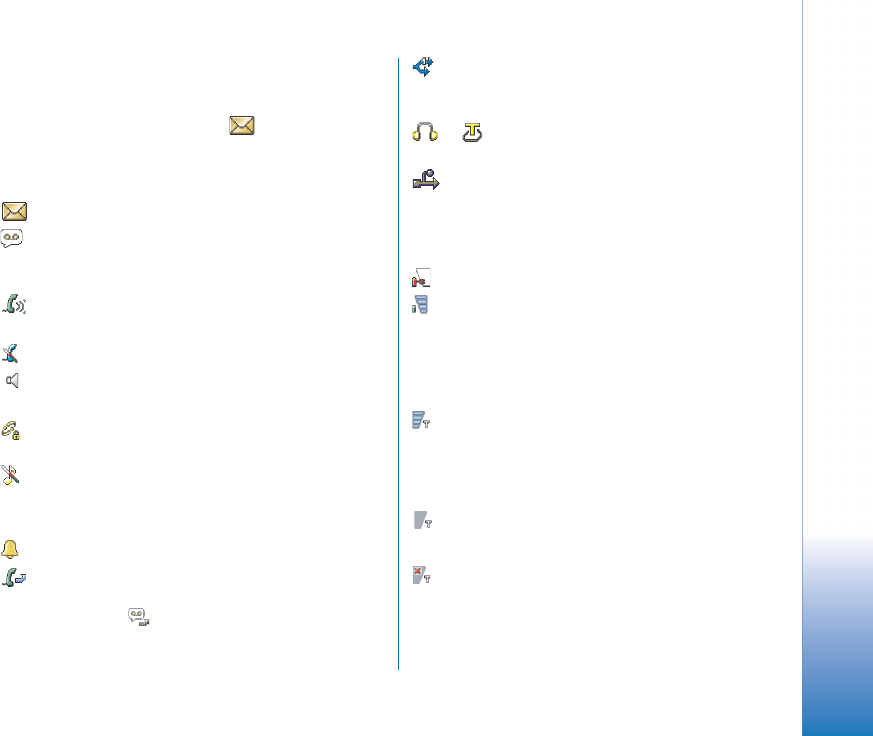
Getting started
22
FCC
Status indicators
You can open applications or dialogs by tapping some of
the status icons. For example, tap to open Inbox
where you can read the message you have received. Here
are some of the status icons as they appear when using the
default theme:
You have one or more unread messages in your Inbox.
You have received one or several voice messages. Tap
the icon to call your voice mailbox. If you have two phone
lines, a number indicates the phone line.
A voice call is in progress. Tap to open the call
handling view.
The microphone is in mute mode.
Volume control. Tap during a call to open volume
adjustment window.
The touch screen and keys of the device are locked. See
“Touch screen and keypad lock” on page 25.
You are using the Silent profile. The phone will not ring
to notify you of an incoming call or message. Tap to open
the profile selection dialog.
The alarm clock is active.
All your calls are diverted to another number. If you
have two phone lines, a number indicates the line to which
the call is diverted. indicates that all calls are diverted
to a voice mailbox. Tap the icon to modify call diverting
settings.
If you have two phone lines, the number indicates the
selected phone line. Tap the icon to switch between the
phone lines.
or Headset or loopset is connected to the media
device.
Your device is connected to a PC using a
connectivity cable.
Battery level
The battery is almost empty. Recharge it.
The battery is charged. When the bar stops scrolling
and all four bars are displayed, the battery is fully
charged.
Signal strength
The media device is connected to a wireless network.
When all four bars are shown, the wireless signal
reception is good. If the signal is weak, you can try to
improve the reception by moving the device slightly or by
using it in the handsfree mode.
The device is switched on, but it is outside network
coverage.
The phone functions of the device are switched off.
You cannot make or receive calls, and you cannot receive
messages with any of the communications applications
(SMS, data, or e-mail).

Getting started
23
FCC
Data connection indicators
Bluetooth connection. Tap to open a dialog where
you can switch off Bluetooth connection. For more
information on the Bluetooth technology, see “Bluetooth
connection” on page 122.
Data call is in progress. Tap to open the call handling
view.
HSCSD data call is in progress. Tap to open the call
handling view.
The GPRS connection is active. The GPRS symbol
is shown when the GPRS connection is suspended (on
hold), for example, if you have received or made a call
during a GPRS connection. Tap the icon to open the
Connection manager dialog.

General information
24
FCC DRAFT
General information
Stickers in the sales package
The stickers included in the sales package contain
important information for service and customer support
purposes. The sales package also includes instructions on
how you should use these stickers.
Access codes
Explanations for the different security codes that may be
needed:
•Lock code (5 to 10 digits): The lock code protects your
device against unauthorised use, and is supplied with
the device. The preset code is 12345. Change the code,
and keep the new code secret and in a safe place
separate from your device.
•PIN code and PIN2 code (4 to 8 digits): The PIN
(Personal Identification Number) code protects your
SIM card against unauthorised use. The PIN code is
usually supplied with the SIM card. After three
consecutive incorrect PIN code entries, the PIN code is
blocked and you need to unblock it before you can use
the SIM card again.
The PIN2 code may be supplied with some SIM cards,
and is required to access some functions, such as fixed
dialling number.
•PUK and PUK2 codes (8 digits): The PUK (Personal
Unblocking Key) code is required to change a blocked
PIN code. The PUK2 code is required to change a
blocked PIN2 code. If the codes are not supplied with
the SIM card, contact the operator whose SIM card is
in your media device.
•Barring password (4 digits): The barring password is
needed when using the Call barring service. You can
obtain the password from your service provider.
The Internet applications of the media device use
passwords and user names to protect against
unauthorised use of the Internet and its services. These
passwords are changed in the settings of the Internet
applications.
Memory management
Many features of the media device consume memory as
they store data. These features include videos, music files,
games, contacts, messages, images and ringing tones,
calendar and to-do notes, documents and downloaded
applications. The amount of free memory available
depends on how much data is already saved in the media
device memory.
You can use a memory card as extra storage space. If the
media device memory is getting low, you can move data to
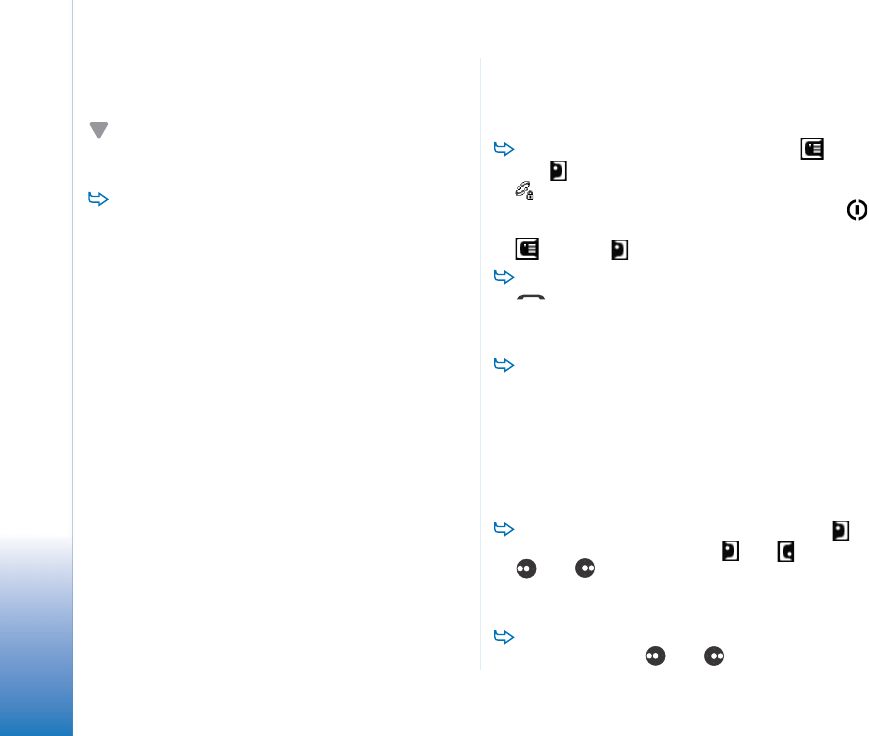
General information
25
FCC
a memory card. Memory cards are re-writable, so you can
repeatedly save data on a memory card, and delete data
from it as necessary.
Note: Some cards are read-only. They contain pre-
installed data that cannot be uninstalled from the card
or overwritten.
To view memory consumption, go to the Control
Panel application and open Memory. You can see what
kind of data you have both in the media device
memory and in the memory card, and how much
memory the different data groups consume.
Freeing memory
Installing many games or saving many images, music files
or video clips can use a large amount of the available
memory. The media device will notify you that the
memory is getting low. In this case, additional data may
not be saved until you delete some of the games, images,
or other entries to free memory. To avoid memory getting
low, you should regularly delete, or transfer data to a
memory card.
You can delete contact information, calendar notes,
games, messages, e-mail messages, or any other data. Go
to the respective application to remove the data.
Touch screen and keypad lock
You can lock the touch screen and keys to prevent them
from being pressed accidentally.
To lock the touch screen and keys, press and
then . When the touch screen and keys are locked,
appears in the status indicator area. Another way
to activate the keyguard is to press the power key
and select Lock touch screen and keys. To unlock, press
and then .
To answer a call when the keyguard is on, press
. During a call, the phone can be operated
normally. When you end or reject the call, the touch
screen and keys will automatically be locked again.
To turn the automatic keyguard on, go to the Control
panel application and open Display. Select the Screen
saver locks display & keys: check box and tap OK. The
touch screen and keys are locked automatically after
the screen saver is activated.
Volume control
To adjust the volume level during a call, press to
open the audio settings. Press and , or press
and on the scroll key to decrease or increase
the volume level, respectively. You can also select to
use the loudspeaker or mute the device.
To adjust the volume level when using a headset or
loudspeaker, press and on the scroll key.
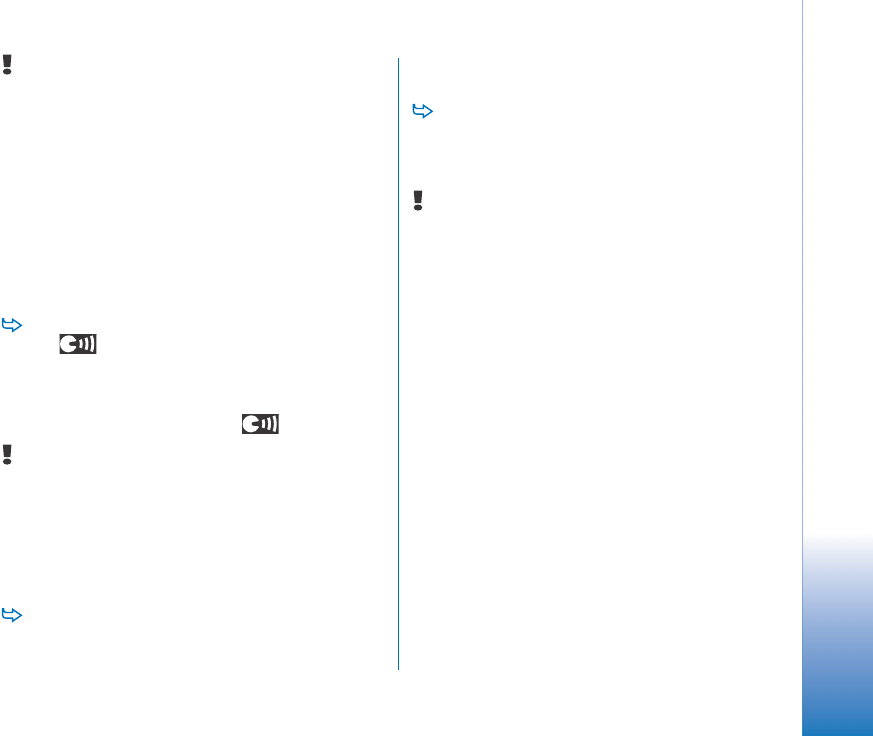
General information
26
FCC
WARNING: Listen to music at a moderate level.
Continuous exposure to high volume may damage your
hearing.
Loudspeaker
Your media device has a built-in loudspeaker for handsfree
use (See fig. 3 on page 13). The loudspeaker allows you to
speak and listen to the device from a short distance
without having to hold the device to your ear, for example,
you could leave it on a table nearby. The loudspeaker can
be used during a call, with sound applications, and when
viewing multimedia messages.
To turn the loudspeaker on during an active call,
press . The loudspeaker needs to be activated
separately each time for phone calls, but sound
applications such as Music player use the loudspeaker
by default. To turn off the loudspeaker and switch
back to using the earpiece, press .
WARNING: Do not hold the device near to your ear
when the loudspeaker is in use, because the volume
may be extremely loud.
Headset
You can listen to the radio and music player in your media
device with the supplied headset HS-3.
To connect the headset to the device, insert the end
of the headset cable into the Pop-Port™ connector on
the bottom of the device. (See fig 2 on page 13) The
headset’s lead functions as the antenna for the radio,
so let it hang freely.
To answer a call when using the headset, press the
remote control button, which is located in the
microphone part of the headset. To end the call, press
the same button again.
WARNING: When using the stereo headset your
ability to hear outside sounds may be affected. Do not
use the stereo headset where it can endanger your
safety.
Installing applications and
software
You can install two types of applications and software to
your media device:
• Applications and software specifically intended for the
Nokia 7710 or suitable for the Symbian operating
system. These installation files have the extension .SIS.
See “Installing software” on page 27.
• J2Micro EditionTMJava applications suitable for the
Symbian operating system. These files have the
extension .JAD or .JAR. Do not download
PersonalJavaTM applications to your device as they
cannot be installed. See “Installing JavaTM
applications” on page 27.
Installation files may be transferred to your device from a
compatible computer, downloaded during browsing, or
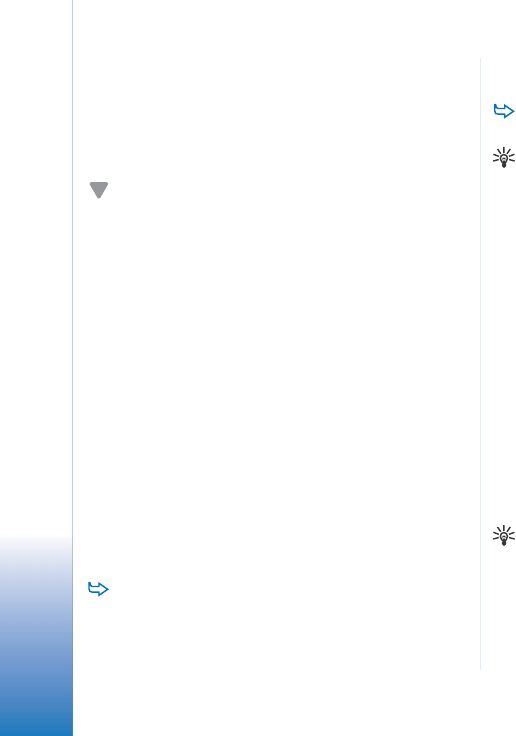
General information
27
FCC
sent to you in a multimedia message, as an e-mail
attachment, or via Bluetooth. If you are using the PC Suite
6 to transfer a file, place the file in the c:\nokia\installs
folder in your media device. If you are using Microsoft
Windows Explorer to transfer a file, place the file on a
memory card (local disk).
Important: Only install applications from sources that
offer adequate protection against harmful software.
During installation, the media device checks the integrity
of the package to be installed. The device shows
information about the checks being carried out, and you
are given options whether to continue or cancel the
installation.
For information on digital signatures and certificates, see
“Certificate manager” on page 103.
Installing software
If you install a file that contains an update or repair to an
existing application, you can only restore the original
application if you have the original installation file or a
full back-up copy of the removed software package. To
restore the original application, first remove the
application and then install the application again from
the original installation file or the back-up copy.
To install software, search the device memory or the
memory card for the installation file, and double-tap
the file to start the installation. For example, if you
have received the installation file as an e-mail
attachment, go to your mailbox, open the e-mail and
double-tap an installation file to start the installation.
To remove software, see “Application manager” on
page 102.
Tip: For more information on software installations,
see “Application manager” on page 102.
Installing JavaTM applications
1Search the device memory or the memory card for the
installation file, select the file and double-tap it to
start the installation. For example, if you have received
the installation file as an e-mail attachment, go to
your mailbox, open the e-mail and double-tap an
installation file to start the installation.
2Confirm the installation. The .JAR file is required for
installation. If it is missing, the device may ask you to
download it. If there is no access point defined, you
will be asked to select one. When you are downloading
the .JAR file, you may need to enter a user name and
password to access the server. You can obtain these
from the supplier or manufacturer of the application.
The device informs you when installation is complete.
Tip: When you are browsing, you can download an
installation file and install it immediately. Note,
however, that the connection is left running in the
background during installation.

General information
28
FCC
Data transmission
This device employs the data transmission capabilities of
the GSM network to send multimedia messages, short
messages and e-mail, and to establish connections with
remote computers.
Wireless data connections can be made from most
locations where your media device operates. However, it is
recommended that you move the device to a location
where the strongest possible wireless signal can be
obtained. When the signal is strong, data transmission is
efficient. In general, you should not expect the same
performance from wireless data communications as from
landline communications, due to the inherent
characteristics of the wireless environment.
The following factors may impair wireless connections in
the form of noise, low or lost signal, erroneous function of
the device, or distorted display:
Noise – Radio interference from electronic appliances and
equipment, as well as from other phones will affect the
quality of wireless data transmission.
Roaming – As the media device user moves from one
network cell to another, the signal strength of the channel
drops and the wireless telephone exchange may hand the
user over to a different cell and frequency, where the
signal is stronger. A cell handover may also occur when the
user is stationary, due to varying network traffic loads.
Such handovers may cause slight delays in transmission.
Electrostatic discharge – A discharge of static electricity
from a finger or a conductor may cause erroneous
functions in electrical devices. The discharge may result in
distorted display and unstable software operation.
Wireless connections may become unreliable, data may
become corrupted, and transmission halted. In this case
you need to end the existing call (if any), switch off the
device (if on) and remove the battery. Then replace the
battery and establish a new wireless connection.
Dead spots and dropouts – Dead spots are areas where
radio signals cannot be received. Dropouts occur when
the media device user passes through an area where the
radio signal is blocked or reduced by geographical
features or large structures.
Signal impairment – Distance and obstacles can cause
signals to become out-of-phase. They can also cause
reflected signals. Both situations result in a loss of signal
strength.
Low signal strength – Due to either distance or obstacles,
the radio signal strength from a cell site may not be
strong enough or stable enough to provide a reliable data
connection for communication. Therefore, to ensure the
best possible communication, remember the following
points:
• The data connection works best when the device is in
a stationary position. Attempting wireless data
communication while in a moving vehicle is not
recommended.
• Do not place the device on a metal surface.

General information
29
FCC
• Check that the signal strength on the media device
display is sufficient. Moving the media device within a
room, especially towards a window, may result in a
stronger signal. If a signal is not strong enough to
support a voice call, data connection should not be
attempted until you can find a location with better
signal reception.
Data connections
GSM data calls
A GSM data call enables data transmission rates of up to
14.4 Kbps. For availability and subscription to data
services, contact your network operator or service
provider.
High-speed data calls (High Speed
Circuit Switched Data, HSCSD)
HSCSD enables data transmission rates of up to 43.2 Kbps,
which is four times faster than standard data rates of the
GSM network. HSCSD is comparable to the speed of many
computer modems that communicate with fixed
telephone networks.
For availability and subscription to high-speed data
services, please contact your network operator or service
provider.
Note: Sending data in HSCSD mode may drain the
device’s battery faster than normal voice or data calls,
as the device may send data more frequently to the
network.
Packet data (General Packet Radio
Service, GPRS)
GPRS enables wireless access for mobile phones to data
networks (network service). GPRS uses packet data
technology where information is sent in short bursts of
data over the mobile network. The benefit of sending data
in packets is that the network is occupied only when
sending or receiving data. As GPRS uses the network
efficiently, it allows for quick data connection set up and
fast data transmission speeds.
You need to subscribe to the GPRS service. For availability
and subscription to GPRS, contact your network operator
or service provider.
(E)GPRS (Enhanced GPRS) is similar to GPRS but the
enables faster connection. For more information on the
availability of (E)GPRS and data transfer speed, contact
your network operator or service provider. Note that when
you have selected GPRS as a data bearer, the media device
uses (E)GPRS instead of GPRS if this is available on the
network.

General information
30
FCC
Pricing for GPRS and applications
Any data transfers via GPRS and (E)GPRS are subject to
applicable operator data transfer fees. For more
information on fees, contact your network operator or
service provider.
Access points
A data connection connects your media device to the
Internet via an access point. Your media device supports
three kinds of data connections:
• GSM data call ( )
• GSM high-speed data call, or HSCSD ( )
• packet data (GPRS) connection ( )
You need to set access point settings, if you want to, for
example, send and receive multimedia messages or e-mail,
browse pages, download JavaTM applications, or use your
media device as a modem.
Check with your service provider what kind of access point
is needed for the service you wish to access. For availability
and subscription to GSM data call, GSM high-speed data
call and GPRS connection services, contact your network
operator or service provider.
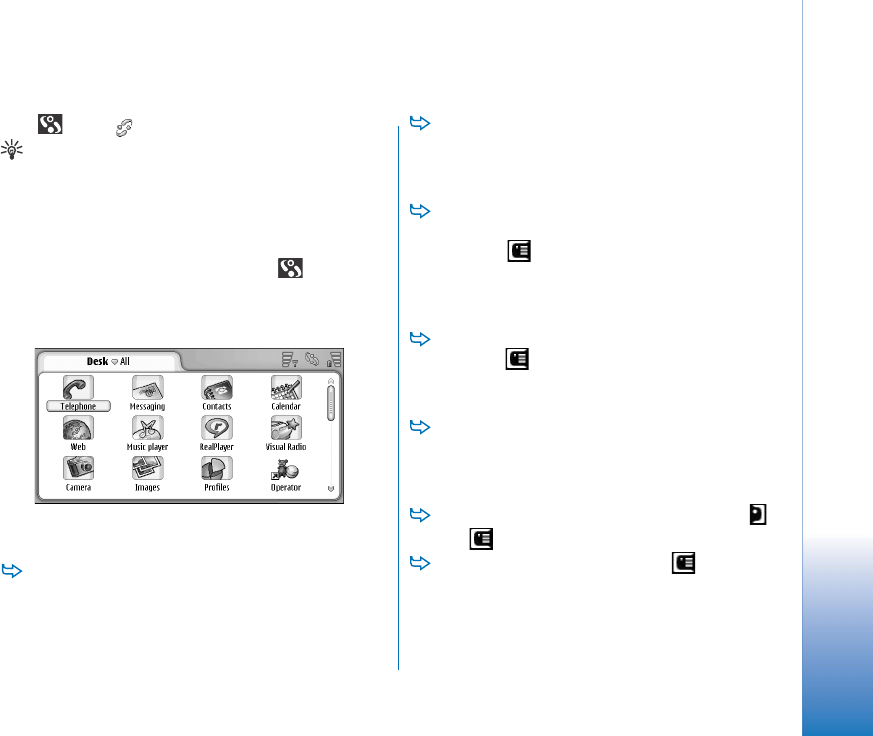
Desk
31
FCC DRAFT
Desk
Press , or tap on the status bar to open Desk.
Tip: A long press opens a list of recently used
applications that you can switch to.
Desk is your workspace where you can access all
applications and create shortcuts to items such as
documents, images, applications, or contact cards.
When you exit an application by pressing and switch
to another application, the media device saves data by
default.
Fig. 12: Desk
To open an application, double-tap the icon. Tap and
drag the scrollbar on the right to move up and down on
the screen.
To remove an application, go to Control panel > App.
manager, select the software package you want to
remove and tap Remove. A dialog appears asking for
your confirmation. Press Remove.
To add a shortcut to an item, go to the application
whose item you want to add to Desk, and select the
item. Press , and look for the Add to Desk... menu
command. For example, in the Images application,
select Tools > Add to Desk.... Select the Desk groups to
which you want to add the shortcut, and tap OK.
To delete a shortcut or application icon, select the
icon, press , and select Edit > Delete. Note that
application icons cannot be removed from the group
All.
To change the order of icons, tap on an icon by
holding the stylus down for about a second and drag
the icon with the stylus to its new location on the
display.
To increase or decrease the size of icons, press or
press , and select Display > Zoom in or Zoom out.
To add a background image, press , and select
Display > Set background image.... Select the image. Tap
Preview if you want to view the image. Otherwise, tap
OK. To further personalise the display, see “Themes”
on page 115.

Desk
32
FCC
Managing groups
You can divide the applications and shortcuts that are
displayed in Desk into separate groups. Having different
groups makes it easier to manage numerous applications
and shortcuts. You can have the same application or
shortcut in several groups.
To create a new group, press , select Group >
New..., and name the new group.
To switch between different groups, press ,
select View group, and select a group.
To add the selected application or shortcut to a
group, press , select Group > Add to group..., and
select the groups where you want to add the item.
To add or remove items in a group, press , and
select Group > Edit.... Note that this option is not
available for the group All. Select the application or
shortcut in the list on the left to add it to the group.
Tap Add. To remove an application or shortcut, select
it on the list on the right, and tap Remove.
To rename a group, press , select Group > Manage
groups.... Select the group that you want to rename,
and tap Rename.
To delete a group, press , select Group > Manage
groups.... Select the group that you want to delete, and
tap Delete. You cannot rename or delete the group All.

Writing text
33
FCC DRAFT
Writing text
You have two options for entering letters, numbers, and
special characters. Handwriting recognition enables you
to write characters directly onto the screen using the
stylus. You can also use the on-screen keyboard to tap in
the characters you want to enter.
To write text, tap the area on the screen where you
want to write. Either the handwriting recognition
window or the on-screen keyboard opens up. To
change from handwriting recognition to on-screen
keyboard, tap . To change to handwriting
recognition, tap . Start writing.
Important: Use only a stylus approved by Nokia for use
with this device. Using other stylus may invalidate any
warranty applying to the device and may damage the
screen. Avoid scratching the screen. Never use an actual
pen or pencil or other sharp objects to write on the screen.
To move the input window, tap and drag .
To hide the input window, tap .
To change the input language, tap and select the
language from the list.
Handwriting recognition
Tip: Tap on the handwriting window to open the
help function. Help offers detailed information on how
to enter characters and contains other useful tips.
Fig. 13 Handwriting recognition window
To use the handwriting recognition, draw the
characters on the handwriting window one by one with
the stylus.
Tip: Note that the part of the window where you write
affects recognition. Use the thin baseline to guide your
handwriting.
To switch between auto-capitalisation, uppercase
and lowercase, tap . At the beginning of a word you
can choose between capitalisation and lowercase. In
the middle of a word you can choose between

Writing text
34
FCC
uppercase and lowercase. All the sentences following
the characters ! ? ¿ ¡ and . are capitalised
automatically, unless you have disabled this option in
Control Panel Pen Input settings.
Note that the case of the letter depends on the alphabet
mode you have selected, not on how you write the letter
on the screen. You can write uppercase letters to produce
lowercase letters if the system recognises uppercase
writing more easily. Note also that you cannot select the
AB mode at the beginning of an auto-capitalised word.
Tip: See “Pen input settings” on page 35 for more
auto-capitalisation settings.
To write numbers, special characters or
handwriting gestures, tap for numbers and for
special characters. See figure 14 on how to enter
spaces, backspaces, etc.
Fig. 14 Handwriting gestures: 1 - space, 2- backspace, 3-
enter, 4 - tab
To delete text, select the text by dragging the stylus
over the text. Draw the backspace gesture. See fig. 14.
To teach the system your individual writing style,
select the Control panel application and Pen Input
Settings, then tap Training. Double-tap on a character
set (lowercase or uppercase letters, numbers, or special
characters) and select the individual character to be
trained. Tap Train. Draw the character in your own way
and tap OK. To change the writing style you have
taught the system, open the Draw character '%c'
dialog again, and tap Clear to remove the existing
style. Draw the new character and tap OK.
Train only the characters that the system has difficulty
recognising. If you try to train the system to recognize all
the characters, your device may run out of memory.
On-screen keyboard
To use the on-screen keyboard, tap on the keys of the
keyboard with the stylus.
Fig. 15 On-screen keyboard
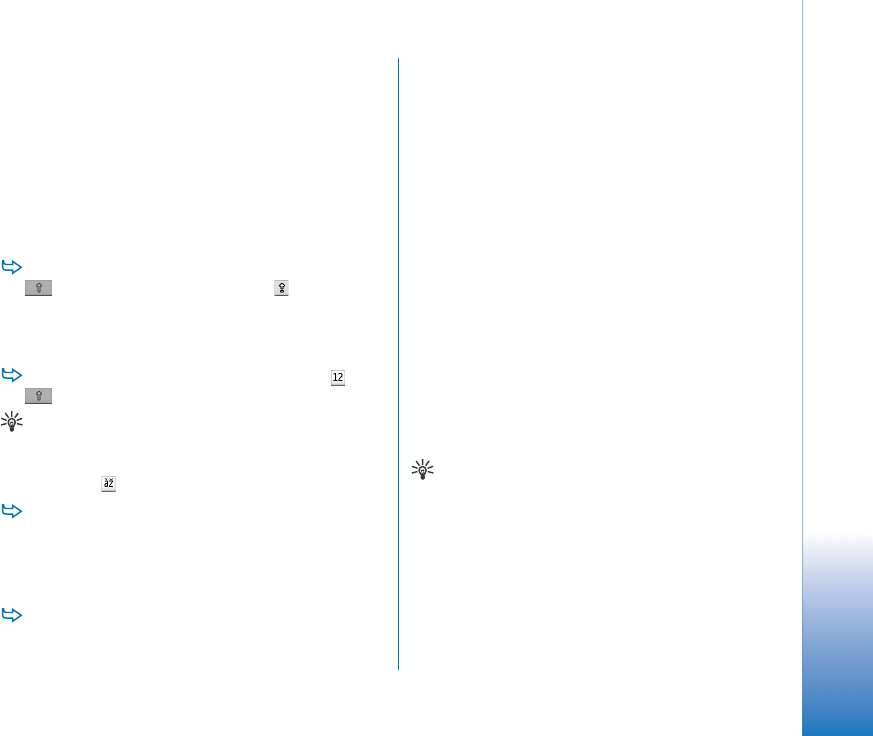
Writing text
35
FCC
1Input display. Displays the characters you are writing.
2Backspace. Deletes the character to the left of the
cursor.
3Enter. Starts a new line or adds new rows.
4Tab key. Adds a tab space or moves the cursor to the
next field.
5Caps lock. Switches on uppercase mode.
6Shift. Allows you to enter an uppercase letter when you
are writing in lowercase mode.
7Space. Inserts a space.
To switch between uppercase and lowercase, tap
. To switch on the caps lock tap .All the
sentences following the characters ! ? ¿ ¡ . are
capitalised automatically, unless you have disabled this
option in Control Panel Pen Input settings.
To write numbers or special characters, tap . Tap
to see more special characters.
Tip: To write accented letters, if the keyboard has keys
with only accents in them, first tap the accent and
then the letter. To select accented letters, you can
also tap , if available.
To delete text, select the text by dragging the stylus
over the text. Tap on the backspace icon.
Pen input settings
To configure text input settings, select Control panel
> Pen Input Settings. Define the following:
Input language: — This setting defines which language-
specific characters, in your handwriting, are
recognised and how your on-screen keyboard is laid
out.
Character recognition speed: — Adjust the speed at which
handwriting is recognised.
Line width: — Change the thickness of the trail of the
stylus.
Keyboard size: — Select the size for the virtual keyboard.
The default size is Small.
Input method: — By default, your device has two text input
methods: on-screen keyboard and handwriting
recognition. You do not need this setting unless
additional input methods are installed on your device.
Capitalise: — To capitalise words following the characters
. ! ? ¿ ¡ with space, select After '.', '?' or '!' with space. To
capitalize them without space, select After '.', '?' or '!' .
To turn off the capitalisation select No.
Tip: Use the After '.', '?' or '!' setting with text messages
to fit in more text.
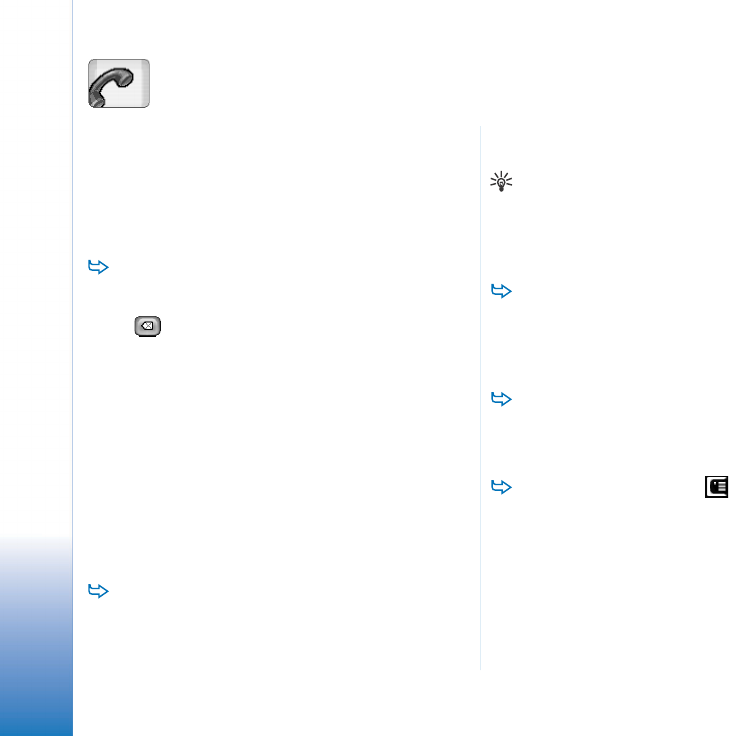
Telephone
36
FCC DRAFT
Telephone
Go to Desk > Telephone.
The microphone and earpiece are on the front side of the
device (See fig.“1” on page 12).
Calling
To make a call using the numeric keypad, open the
Telephone application, input the number by tapping
the keypad, and tap Call. To delete tapped numbers,
tap . For international calls, add the international
prefix + (double-tap the * button and select + from the
popup list) and then enter the country code, the area
code, and the phone number.
If the SIM card has been removed or is corrupted you can
make only emergency calls. Some networks may require
that a valid SIM card is properly inserted in the device to
make any calls.
If making an emergency call the normal way is not
possible, you may be able to enter an emergency number
preprogrammed in your device in the code query field and
tap Call.
To call a number in your directory, tap Contacts in
the Dialler window, select a contact in the directory,
and tap Call. If the contact has more than one phone
number, a list opens with all the contact’s phone
numbers. Choose a number from the list and tap OK.
Tip: You can use a phone number in a text box or
document as a hyperlink. Tap the number or move the
cursor inside it with the scroll key; it becomes a link
with a small icon. Tap the icon to call the phone
number.
To add the number from the number field to your
Contacts, tap Add to Contacts, select a contact or
create a new contact and fill in the contact
information. For more information, see “Contacts” on
page 60.
To call a number in a recent calls list, tap Recent
calls in the Dialler window. Select a number from one
of the lists and tap Call. To add a number to your
Contacts, select a number and tap Add to contacts.
To use speed dialling, press , select View > Speed
dialling and tap the name or number you want to call.
Speed dialling is a quick way to call frequently used
numbers.
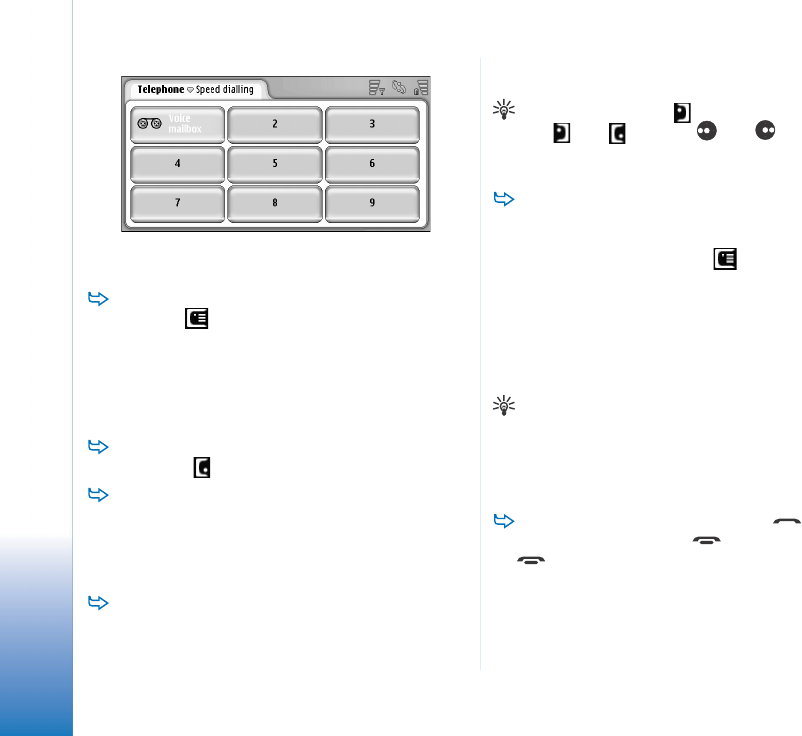
Telephone
37
FCC
Fig. 16: Speed dialling
To add speed dial numbers, open the speed dialling
view (press , select View > Speed dialling). Tap on an
empty speed dial number, then tap Assign in the
dialog that opens. Select the contact for which you
want to assign the speed dial number, and tap Select.
If there are several phone numbers to choose from,
pick one, and tap OK.
To switch between the Dialler and Speed dialling
views, press .
To call your voice mailbox, contact your network
operator for a voice mailbox number (network service).
In the Speed dial view, number 1 is reserved for calls
to your default voice mailbox. For more information,
see “Voice mailbox settings” on page 40.
To adjust the sound level during a call, tap Audio
settings. Move the slider to adjust the sound level.
Select Loudspeaker: to use the handsfree speaker and
microphone or Mute: to silence the microphone.
Tip: During a call, press to open the audio settings.
Press and , or press and on the scroll
key to decrease or increase the volume level,
respectively.
To make a new call during a call, tap New call. To
switch between the calls tap Unhold or Hold. To
connect the other two participants and remove
yourself from the call, press , select Options >
Transfer. To talk to both participants simultaneously,
tap Conference. A conference call can have up to 5
participants. When in conference call, tap Conf.
options to drop participants or speak to them privately.
A conference call and call transfer are network
services.
Tip: For information on monitoring missed, received,
and dialled calls, and on call duration, see “Log” on
page 118.
Answering
To answer a call, tap Answer or press . To reject
a call, tap Reject or press . To end a call press
. To mute the ringing tone, tap Silence. To mute
the tone and reply with a default message, see “Other
settings” on page 40

Telephone
38
FCC
Voice dialling
You can make a phone call by saying a voice tag that has
been added to a contact card. Any spoken word(s) can be
a voice tag.
Before using voice tags, note that:
• Voice tags are not language-dependent. They are
dependent on the speaker's voice.
• You must say the name exactly as you said it when you
recorded it.
• When recording and saying the voice tags, speak up. If
you speak too softly, the system may not recognise the
voice tag properly.
• Voice tags are sensitive to background noise. Record
voice tags and use them in a quiet environment.
• Very short names are not accepted. Use long names and
avoid similar names for different numbers.
Note: Using voice tags may be difficult in a noisy
environment or during an emergency, so you should not
rely solely upon voice dialling in all circumstances.
To add voice tags, see “Voice tags” on page 62.
To use voice dialling, press and hold or the
headset button until you hear a start tone or see a note
on the display. Say the voice tag for the number you
want to dial. To try again if the voice tag was not
recognised, press and hold down the key a few
seconds. To return to normal dialling, briefly press the
key or headset button, and press the ESC key.
Telephone settings
Call diverting (network service)
Call diverting allows you to direct your incoming voice
calls to another phone number. This is also known as call
forwarding.
1Press , and select Tools > Settings > Call divert.... A
dialog opens.
2Go to the Voice calls page.
3Define the following:
Divert all calls: — When activated, all incoming calls are
diverted.
Divert if busy: — When activated, incoming calls are
diverted when you are engaged in another call.
Divert if not answered: — When activated, incoming
calls are diverted if you do not answer them within a
certain time period.
Divert if out of reach: — When activated, incoming calls
are diverted when the device is switched off or outside
the network service area.
Divert if not available: — In a single action, this option
turns on Divert if busy:, Divert if out of reach:, and Divert if
not answered:.
The options available are:
Activate — Opens a dialog where you type the number
to which you want to divert the calls and - if available
- choose the time period after which the call is
diverted, if it is not answered. Tap to select your
voice mailbox number or other default numbers, if
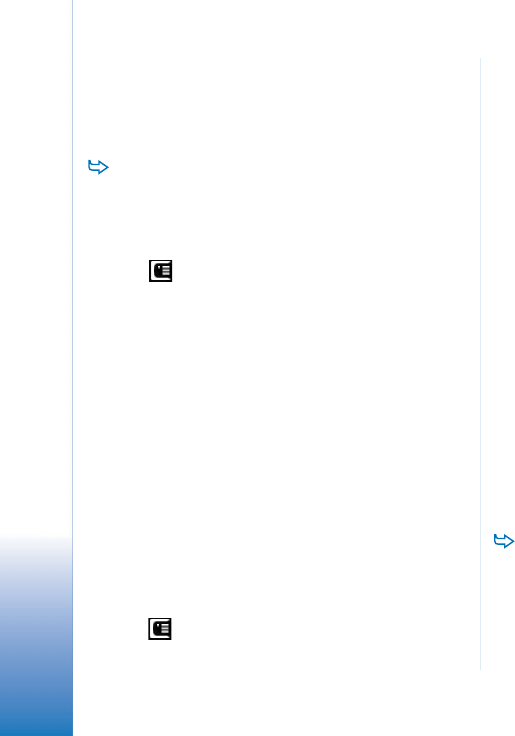
Telephone
39
FCC
available. Tap Select contact to search for a phone
number in the Contacts application.
Cancel — Turns off the divert.
Check status — Checks whether the divert is activated
or not.
To cancel all call diverts, tap Cancel all diverts.
Diverting data & fax calls (network
service)
1Press , and select Tools > Settings > Call divert....
2Go to the Data & Fax calls page and select one of the
following options to divert all data calls or all fax calls:
Activate - Opens a dialog where you type the number
to which you want to divert the calls, and choose the
time period after which the call is diverted, if it is not
answered. You can tap the box to select previously
added numbers, if available.
Cancel - Turns off the divert.
Check status - Checks whether the divert is active or
not.
Call barring (network service)
Call barring allows you to restrict the making and
receiving of calls with your media device. For this
function, you need the barring password from your service
provider.
1Press , and select Tools > Settings > Call barring.... A
dialog opens.
2Define the following:
All incoming calls: — When activated, calls cannot be
received.
Incoming calls when abroad: — When activated, calls
cannot be received when you are outside your home
country.
All outgoing calls: — When activated, calls cannot be
made.
International calls: — When activated, calls cannot be
made to other countries or regions.
Int. calls except to home country: - If you have enabled
international roaming with your network operator, you
cannot make international calls abroad, except to your
home country.
The options available are:
Activate — Turns on the barring.
Cancel — Turns off the barring.
Check status — Checks whether call barring is activated
or not.
3Enter the barring password, and tap OK to activate the
service.
If your SIM card supports the alternate line service, voice
call barring applies only to the selected line.
To cancel all call barrings, tap Cancel all barrings.
For information on barring data calls, see “Data call
barring” on page 105.
Call barring and call diverting cannot be active at the
same time. When calls are barred, calls still may be

Telephone
40
FCC
possible to certain official emergency number
programmed into your device.
Voice mailbox settings
For information on calling a voice mailbox (network
service), see “Calling” on page 36.
1Press , and select Tools > Settings > Voice mailbox....
2Define the voice mailbox number, and if you wish to do
so, the DTMF tone (voice mailbox password):
Number: — Write the voice mailbox number obtained
from your service provider.
DTMF: — Define DTMF tones for a voice mailbox. For
more information on DTMF tones, see “Sending DTMF
tones” on page 41.
If your SIM card supports the alternate line service, you
can define the voice mailbox settings for both lines.
Other settings
Press , and select Tools > Settings > Other settings....
Define the following:
Call page
Call waiting: (network service)— If you have activated the
call waiting service, the network will notify you of a new
incoming call while you have a call in progress. The option
Check status checks whether call waiting is activated or
not.
Send my caller ID: (network service) — Determines whether
your number is hidden or presented to the person you are
calling. The value may be set by your network operator or
service provider when you make a subscription (Set by
network).
Summary after call: — If you select the option On, the
approximate duration of a call will be displayed after the
call.
Automatic redial: — If you select the option On, and you call
a number that is busy or does not answer, the device
attempts to call the number automatically. The maximum
number of attempts is 10.
Reject with message: — If you select the option On, a text
box opens, where you can write a message that you can
send to a caller as a reply, whenever you mute an
incoming phone call. To modify the message afterwards,
select the option Edit message.
Line in use: (network service)— If your SIM card supports
the alternate line service, select the line you want to use.
Block line change: (network service) — If your SIM card
supports the alternate line service, and you select this
option, you cannot change the line in use. If you want to
change this setting, you must enter your PIN2 code.
Network page
Operator selection: — Allows you to change the way a
network is selected, and also to register to another
network. In automatic network selection, the device

Telephone
41
FCC
selects the most appropriate network. In manual network
selection, the device searches for available networks and
presents you with a list of networks found. You can then
select which network to use. Note that the possibility to
change a network depends on your network operator.
Cell info display: - Select On to indicate that the device is
used within a Micro Cellular Network. An indicator of the
MCN cell is shown in the phone number field. The
indicator is not shown during a call.
Security page
When security features that restrict calls are in use (such
as call barring, closed user group, and fixed dialing) calls
still may be possible to the official emergency number
programmed into your device.
Closed user group: —Specify a group of people to whom you
can call and who can call you. Select Default to activate
the group agreed on with the network operator. Select On
to activate this network service. You must enter the group
number that you have obtained from the network.
Fixed dialling: — If your SIM card supports this service, you
can restrict your calls to a limited set of numbers stored
in the SIM card. When the fixed dialling service is active,
the SIM phone book list shows only numbers in the fixed
dialling list. You still have access to the Contacts
directory, but you cannot call those numbers.
If you want to change the settings or view the fixed
numbers, you are required to enter your PIN2 code. Select
Contacts to add, modify, or delete numbers.
You are required to enter names and numbers into the
fixed dialling list.
Note: Fixed dialling also affects service requests (also
known as SS and USSD commands), such as activation
commands for network services.
Sending DTMF tones
DTMF (Dual Tone Multi-Frequency) tones are the tones
you hear when you tap the number keys on the numeric
keypad of the Telephone application. For example, DTMF
tones allow you to communicate with voice mailboxes and
computerised telephony systems.
You can send DTMF tones to the network to, for example,
access automated phone services, voice mailboxes, or
banking systems.
You can send DTMF tones automatically if you have added
a DTMF tone to the DTMF field in a contact card in
Contacts application. You can also send DTMF tones
manually in the Dialler view of Telephone. The manual
method of transmitting DTMF tones is recommended
when the DTMF tone string is short.
To send DTMF tone strings automatically during a
call, press , and select Options > Send DTMF.... If
there is a DTMF string for the currently active call in
Contacts, the Send DTMF dialog opens. Tap Send to
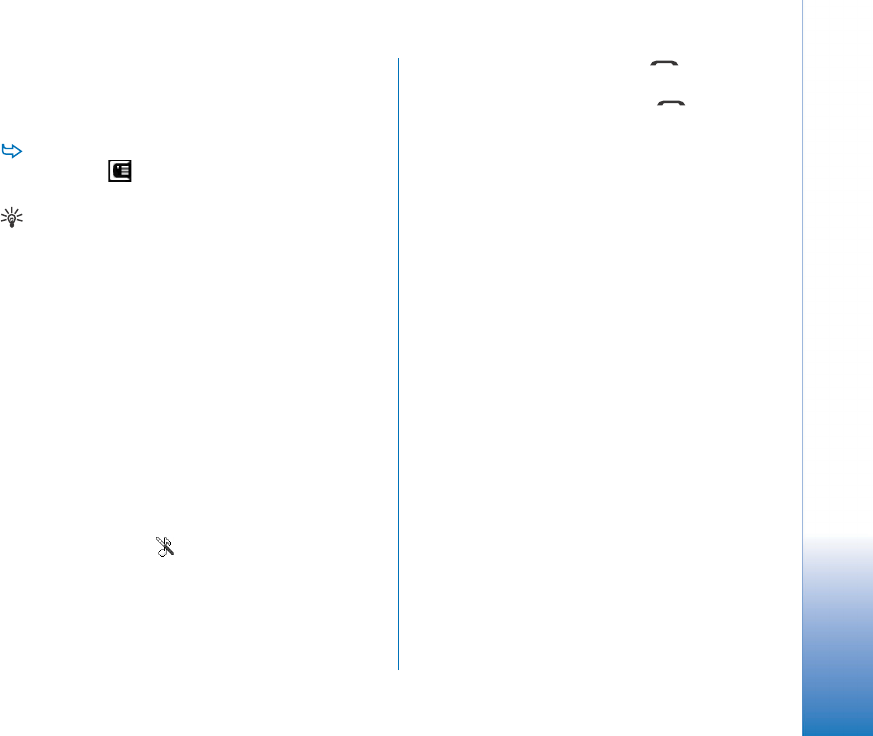
Telephone
42
FCC
send the DTMF tone automatically, or Enter manually
to use the Dialler view. The Dialler view opens
automatically if there is no DTMF string for the call in
Contacts.
To enter DTMF tones manually during a call, tap New
call or press > View > Dialler to open the Dialler
view. Enter the DTMF string.
Tip: There are 2 special characters that you can use by
double-tapping * on the keypad:
• p (pause) — Causes a three-second pause
between the digits in a DTMF tone string. All
digits that follow the pause are treated as
DTMF tones.
• w (wait) — Pauses the sending of DTMF digits
until you tap Send. The rest of the string is
sent to the network. All digits that follow the
wait are treated as DTMF tones.
You can add DTMF tones to the DTMF field in a contact
card.
Tips for efficient use of Telephone
• The silent indicator is displayed in the status
indicator area when you have set the Silent profile to
active. Tapping this indicator will open a dialog where
you can change the profile. The indicator is removed
from the status indicator area when you activate a
profile other than 'Silent'.
• In the call handling view, press during a call to
put the current call on hold or to activate a held call.
When you are not on a call, press to bring up the
last dialled calls list.
• In the speed dial view, you can drag the assigned
speed dial buttons with the stylus to reorganise them.
The fixed voice mail button cannot be moved.
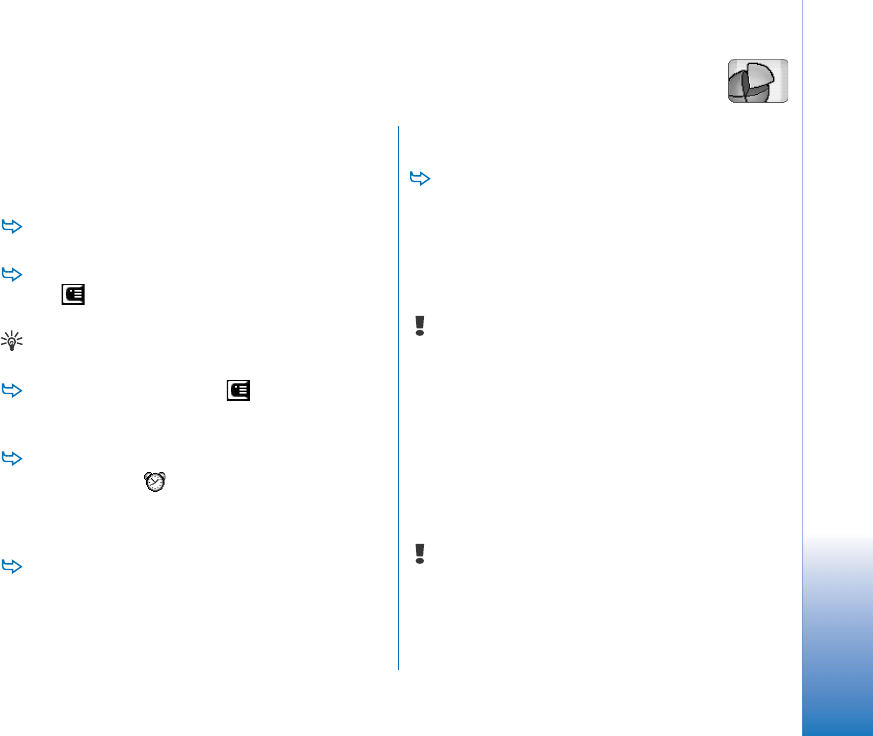
Profiles
43
FCC DRAFT
Profiles
Go to Desk > Profiles.
Profiles define the tones and sound level of your device for
different operating environments, events, and caller
groups.
To change a profile, select the profile from the list and
tap Activate.
To delete a profile, select the profile from the list,
press , and select Profile > Delete. Note that the
default profiles cannot be deleted.
Tip: You can also change profiles by briefly pressing
the power key.
To create a new profile, press , and select Profile >
New.... For more information on the settings, see
“Editing profiles” on page 44.
To define the time when the selected profile expires,
tap Set time. Tap , and then use the arrows to
change the time. When the end time is reached the
previously used profile is taken back into use. Note that
due to safety reasons the Flight profile cannot be timed.
To add a caller group to a selected profile, tap
Personalise and Alert for. Select the group or groups,
and tap OK. The device plays the chosen ringing or alert
tone only when a group member calls or sends a
message to you (if the caller’s telephone number is sent
with the call and your device recognises it). Other
callers are handled using the Silent profile.
To use your device without connecting to the GSM
wireless network, select the Flight profile, and tap
Activate. GSM wireless phone and FM radio signals to
or from the device and Bluetooth connections are
prevented, but you can still do tasks which do not
require the use of the wireless network. For example,
you can still listen to sound clips or write messages.
WARNING: With Flight profile you cannot make (or
receive) any calls, including emergency calls, or use
other features that require network coverage. To make
calls, first activate the phone function by changing the
profile. If the device has been locked, enter the lock
code. If you need to make an emergency call while the
device is locked and in flight profile, you may also be
able to enter an emergency number preprogrammed in
your device at the lock code field and tap Call. The
device will confirm that you are about to exit flight
profile to start an emergency call.
WARNING: Do not switch the device on when wireless
device use is prohibited or when it may cause
interference or danger.
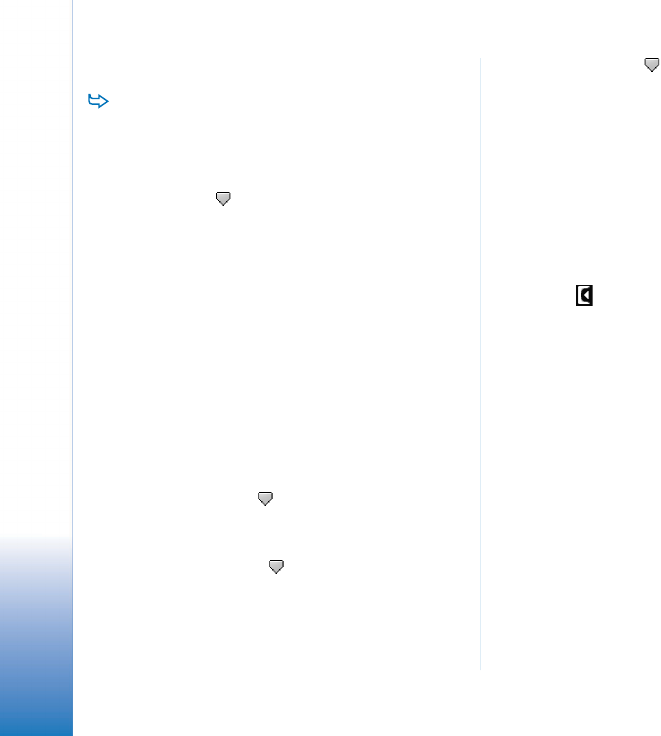
Profiles
44
FCC
Editing profiles
To edit a profile, select the profile from the list, and
tap Personalise. Note that not all settings can be
changed for all profiles. Define the following:
Profile name: — Rename the profile.
Ringing tone: — Tap to select a sound file to be used as
a ringing tone for voice calls. To listen to the selected
tone, tap Play tone. Similarly you can select a sound
file for different message types.
Incoming call alert: — When Ascending is selected, the
ringing volume starts from level one and increases
level by level to the set volume level.
Ringing volume: — Set the volume level by pressing <+> or
<->. The same volume level is used for incoming voice
calls, messages, and alarms.
Vibrating alert: — Set the device to vibrate at incoming
voice calls, messages, and alarms.
Message alerts: — Select to turn on message alerts.
Text msg. alert tone: — Tap to select the alert tone for
incoming text messages. If Message alerts: is not
selected, this option is not available.
Multimedia alert tone: — Tap to select the alert tone for
incoming multimedia messages. If Message alerts: is
not selected, this option is not available.
E-mail alert tone — Tap to select the alert tone for
incoming e-mail messages. If Message alerts:is not
selected, this option is not available.
Key tones: — Set the volume level of the key clicks.
Touch screen tones: — Set the volume level of the display
taps.
Warning tones: — The media device gives a notification
tone, for example, when the battery is running out of
power.
To close the dialog and discard all the changes you have
made, press .
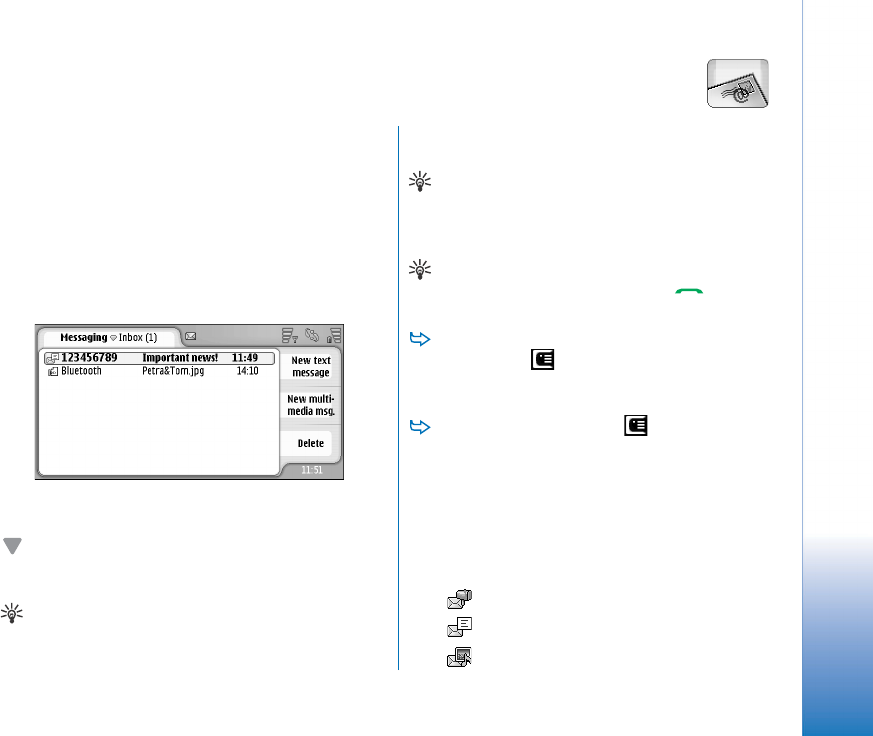
Messaging
45
FCC DRAFT
Messaging
Go to Desk > Messaging.
In the Messaging application you can create, send, receive,
view, edit, and organise various types of messages: text
messages, multimedia messages, e-mail messages, and
smart messages that are special text messages containing
data. You can also receive messages and data via
Bluetooth, and receive WAP service messages, cell
broadcast messages, as well as send service commands.
Fig. 17: Messaging
Note: Only devices that offer compatible multimedia
message or e-mail features can receive and display
multimedia messages.
Tip: To be able to send and receive e-mail and
multimedia messages, you need to configure Internet
access point settings. See “Setting up an Internet
access point” on page 107.
Tip: You can start to create a message from any
application that has the option Send (or menu
command Send). Select a file (an image, text) to be
added to the message and tap Send.
Tip: To send a message in the message edit view, when
a valid address in the To: field, press to send a
message.
To customise the command buttons in the main
window, press , select Display > Command bar
buttons..., select the appropriate command for each
button and tap OK.
To sort the messages, press , select Display >
Sort.... Select the appropriate sorting method and order,
and tap OK.
Inbox
The icons indicate the message type, priority, and possible
attachments. You may see some of the following icons:
New e-mail in remote mailbox
New text message
New multimedia message

Messaging
46
FCC
New calendar invitation
Unread e-mail
High priority e-mail
Low priority e-mail in remote mailbox
Attachment
Outbox statuses
E-mail and text messages can have the following statuses
in Outbox:
Sending - The message is currently being sent.
On request - The e-mail or text message will be sent only
if you specifically tap Send in the Outbox view.
Waiting - A text message is queuing and will be sent as
soon as possible. For example, a message can be lining up
when the device is switched on, while waiting for the
signal strength to become adequate, or while waiting for
the previous phone call to end. In the case of e-mail
messages, Waiting shows that the message will be sent
the next time you connect to your remote mailbox.
Failed - The message could not be sent.
Deferred -You have suspended the sending of the message.
You can resume the sending of a message by Tapping
Send in the Outbox view.
Folders
When you open Messaging, you can see the content of the
folder last opened.
To change to another folder, press and select
Folders. The list of folders contains:
Inbox — Contains received messages, except cell broadcast
messages.
Outbox — A temporary storage place for messages waiting
to be sent. For example, messages are placed in Outbox
when your device is outside network coverage. You can
also schedule e-mail messages to be sent the next time
you connect to your remote mailbox. Tap Defer sending to
keep the message on hold while in Outbox.
Drafts — Contains draft messages that have not been sent.
Sent — Stores messages that have been sent. Note that
messages or data that have been sent via Bluetooth
connection are not saved in the Sent folder.
Remote mailbox — When you open this folder, you
can either connect to your remote mailbox to retrieve your
new e-mail messages or view your previously retrieved e-
mail messages offline. See “E-mail messages” on page 47.
To add a new folder, press and select Tools >
Manage folders.... Tap New and give the new folder a
name. You can organise your messages into these
folders.

Messaging
47
FCC
To rename or delete folders, press and select
Tools > Manage folders.... Note that you cannot delete
default folders.
E-mail messages
To be able to receive and send e-mail, you need to set up
a remote mailbox service. This service may be offered by an
Internet service provider, a network service provider, or the
company you work for.
Setting up a remote mailbox
1Press in the main view of the Messaging
application and select Tools > New mailbox.... Tap Next.
2Define the following settings on the pages of the
mailbox setup wizard:
Mailbox name: - Write a descriptive name for the
remote mailbox.
Mailbox type: - Select the e-mail protocol your remote
mailbox service provider recommends. Note that this
setting can be selected only once and cannot be
changed if you have saved the settings or exited from
the mailbox settings. Tap Next.
Name: - Write your name.
User name: - Write your user name, given to you by your
service provider.
Password: - Write your password. If you leave this field
blank, you will be prompted for a password when you
try to connect to your remote mailbox.
My e-mail address: - Write the e-mail address given to
you by your service provider. The address must contain
the ‘@’ character. Replies to your messages are sent
to this address. Tap Next.
Incoming server (POP3): or Incoming server (IMAP4): - The
IP address or host name of the computer that receives
your e-mail.
Outgoing server (SMTP): - The IP address or host name of
the computer that sends your e-mail. Tap Next.
3After you have defined these options, tap Finish to
return to the Messaging application, or tap Advanced
to define optional advanced e-mail settings. For more
information, see “Advanced e-mail settings” on
page 47.
To edit remote mailbox settings, press and
select Tools > Message settings > E-mail.... Select the
mailbox you want to edit, tap Edit and make the
changes as previously explained. Note that you cannot
edit mailbox settings when the connection to a remote
mailbox is open.
To set a mailbox as the default mailbox, press
and select Tools > Message settings > E-mail.... Select
the mailbox you want to set as default and tap Set as
default.
Advanced e-mail settings
When you have finished setting up or editing your remote
mailbox settings in the Mailbox setup wizard (go to the
Messaging application, press , select Tools > Message

Messaging
48
FCC
settings > E-mail...), you can continue by configuring
advanced mailbox settings.
Retrieval page
Retrieve: — Specifies what will be retrieved from the
remote mailbox when the connection is established. The
Messages option is only available if the mailbox type is
IMAP4.
E-mail size limit: — Define the maximum size of a message
that is retrieved when you select E-mail > Retrieve and send
menu command. The minimum is 1 KB and maximum
1000 KB. If the limit is exceeded, only the header of the
message will be retrieved.
No. of e-mails to retrieve: — Define the number of new
message headers you want to display in Inbox. If you
retrieve new headers and the total amount of headers in
Inbox exceeds this limit, the older headers will be
removed. This option is only available if the mailbox type
is IMAP4.
Password authentication: — Used with POP3 protocol to
encrypt the sending of passwords to a remote mail server.
Retrieve e-mails to inbox: — Select to receive messages from
this account to your Inbox. If not selected, the messages
are received to separate mailbox folders outside your
Inbox.
Sending page
Default e-mail format: — The type of mail that you can
write and send from your device.
Send e-mail: — How mail is sent from your media device.
Include original in reply: — Select to include the original
message when replying to a message.
Request read report: — If you select this option, you will
receive a notification when the recipient has opened your
mail. You can only receive a notification if the recipient’s
e-mail application supports this feature.
Outgoing server (SMTP) page
Authentication required: — Select this if the SMTP (Simple
Mail Transfer Protocol) server requires authentication.
Some servers require that the user is authenticated before
e-mail can be sent.
User name: — Write your user name for the SMTP server.
Password: — Write your password for the SMTP server.
Other page
Security — Define the server security protocol.
Incoming e-mail port: — Enter the port number of the
incoming mail server. Normally you do not have to change
the default value.
Outgoing e-mail port: — Enter the port number of the
outgoing mail server. Normally you do not have to change
the default value.
Access point in use: — Select whether you want to connect
using any available access point or choose the access
point you want to use when connecting.
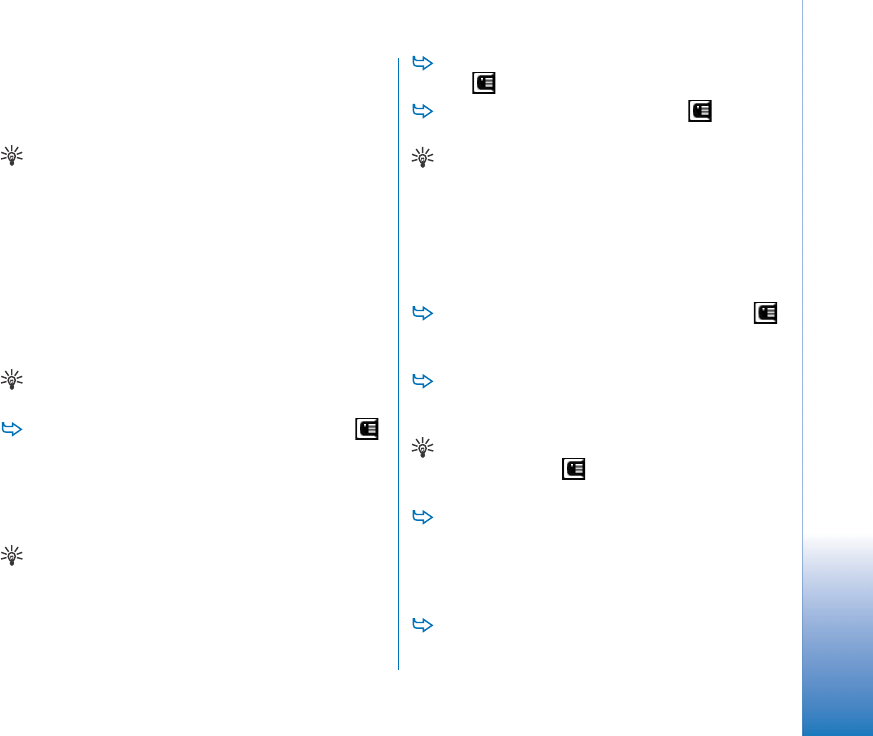
Messaging
49
FCC
Set as default mailbox: — If you select this check box, this
mailbox will be the default mailbox.
Retrieving e-mail from the mailbox
Tip: Delete or move e-mail regularly from your device
to free up memory space.
E-mail sent to you is not automatically received by your
media device, but by your remote mailbox. To read your e-
mail, you must first connect to the remote mailbox and
then select the messages you wish to retrieve into your
device. Connection to a remote mailbox is established via
a data call.
You receive all messages in your remote mailbox folders
unless you specify to receive messages to your Inbox.
Tip: For information on specifying e-mail retrieval
options, see “Advanced e-mail settings” on page 47.
To retrieve e-mail from a remote mailbox, press
and select E-mail > Retrieve and send. Select the
appropriate command to get e-mail either from all
mailboxes or from a selected mailbox. Note that if you
have e-mail in Outbox, these messages will be sent
simultaneously.
Tip: If you have not specified a password in remote
mailbox settings, you will be prompted for a password
when initially connecting to the remote mailbox. In the
dialog that opens, write the password and tap OK.
To retrieve the contents of a selected message,
press , and select E-mail > Retrieve e-mail contents.
To disconnect from a mailbox, press and select
E-mail > Disconnect from Internet. The data call ends.
Tip: To retrieve the contents of a selected e-mail
message, tap the message. The content of the message
is retrieved into your media device, and if there were
any new messages in the remote mailbox, the list of
messages is updated simultaneously.
Reading and replying to e-mail
To open your Inbox or any other folder, press
and select Folders > Inbox/Outbox/Drafts/Sent or the
name of a remote mailbox, if defined.
To open a message, double-tap it. If there is a Web
link in the message, you can open it by tapping the
link.
Tip: You can create a new contact card for the sender
of an e-mail. Press and select Tools > Add to
Contacts....
To open an attachment in a message, double-tap the
attachment. Note that attachments may contain
viruses or other harmful content. Always make sure
that you can trust the sender. To save the
attachment, select it and tap Save.
To reply to a message after reading it, tap Reply. To
reply to all the recipients, not just the sender of the

Messaging
50
FCC
e-mail message, press and select Message > Reply
to all.
When replying to an e-mail message, HTML messages are
included as attachments.
Tip: For information on specifying e-mail sending
options, see “Advanced e-mail settings” on page 47.
To forward an e-mail message, press and select
Message > Forward.
To delete a message from Inbox or remote mailbox,
tap Delete. If required, specify whether you want to
delete the message just from your media device, or
from both the media device and the e-mail server.
Sending e-mail
1Press and select Message > Create > E-mail in the
main view of the Messaging application.
2Write the e-mail address in the To: field. Add a
semicolon (;) to separate each recipient.
If the recipient is in your Contacts, tap . Select the
recipient from the list and tap Add. Tap Done when
you have selected all recipients.
3Fill in the subject and write the message. Tap Send.
Tip: You can use an e-mail address in a text box or
document as a hyperlink. Tap the address, or move the
cursor inside it with the scroll key; it becomes a link
with a small icon. Tap the icon to open the e-mail
editor.
If the name you have entered matches more than one
name, or if the person has more than one e-mail address,
select the correct name or e-mail address from the list and
tap OK.
Tip: You can select more than one contact at a time.
See “Common actions in applications” on page 21.
To show or hide Cc: and Bcc: fields in the mail editor,
press and select Display > Cc field or Bcc field. If you
add a recipient to the Cc: field, a copy of the message
is sent to the recipient, and the recipient’s name is
visible to other recipients of the message. If you add a
recipient to the Bcc: field, a copy of the message is sent
to the recipient, but the recipient’s name is not visible
to other recipients of the message.
To save, but not send an e-mail you have just written,
tap Close. The message is saved in the Drafts folder. The
saved message replaces the previously saved version of
the same message.
To specify sending options for the current e-mail,
tap Sending options. Note that any changes you make
in this dialog affect only the current e-mail you are
about to send, and affects the format of the message
when it is opened by the recipient. For example, the
format may affect the legibility of the characters.
Define the following:
Priority: — The importance level of the message.
E-mail format: — The format style of the message. Select
Formatted text (HTML) to be able to use enhanced text

Messaging
51
FCC
formatting options. Select Plain text to use the regular
internet format, or Plain text (no MIME), if you know that
the receiving mail system cannot display mail sent in
the regular Internet format.
Request read report: — Select this if you want to receive
a note when the recipient has opened your message.
Mailbox in use: — The remote mailbox that is used for
sending this message.
Send e-mail: — Define when the message will be sent.
Immediately means that the message will be sent as
soon as possible if you are connected to your remote
mailbox. If you are not connected, an attempt is made
to establish the connection. The option When
connection available means that the e-mail is sent when
you connect to the remote mailbox the next time. The
option On request means that the message is saved in
Outbox when you tap Send. The message is sent when
you select the message in Outbox and tap Send.
Style of e-mail
Text and paragraph formatting is only possible when the E-
mail format: sending option for the current e-mail is set to
Formatted text (HTML).
To format selected text, press and select Format
> Font.... The toolbar at the bottom of the screen also
contains text editing tools. If the toolbar is not visible,
press and select Display > Toolbar.
To align selected paragraphs, press and select
Format > Alignment > Left, Right, or Centred.
Scheduling
You can define when and how often your device tries to
connect your remote mailbox to send and receive e-mail.
To define e-mail scheduling, press , select E-mail
> Auto-retrieve and send... and tap Edit. Define the start
time, end time and interval of sending and receiving as
follows: Tap and tap and to change the
time. Tap the am/pm field as necessary, if you are using
the 12-hour clock format. In the Days: field, highlight
the days of the week, when you want the connection
to be made. Tap OK.
To enable or disable scheduling, press , select E-
mail > Auto-retrieve and send... and select or clear a
connection to enable or disable the scheduling for it.
Note: Do not leave this option activated, if not
needed. Charges may apply every time the device
connects.
E-mail attachments
You can send most documents and messages you create
in the other applications of your device as e-mail
attachments.
Important: E-mail messages may contain viruses or
otherwise be harmful to your device or PC. Do not open
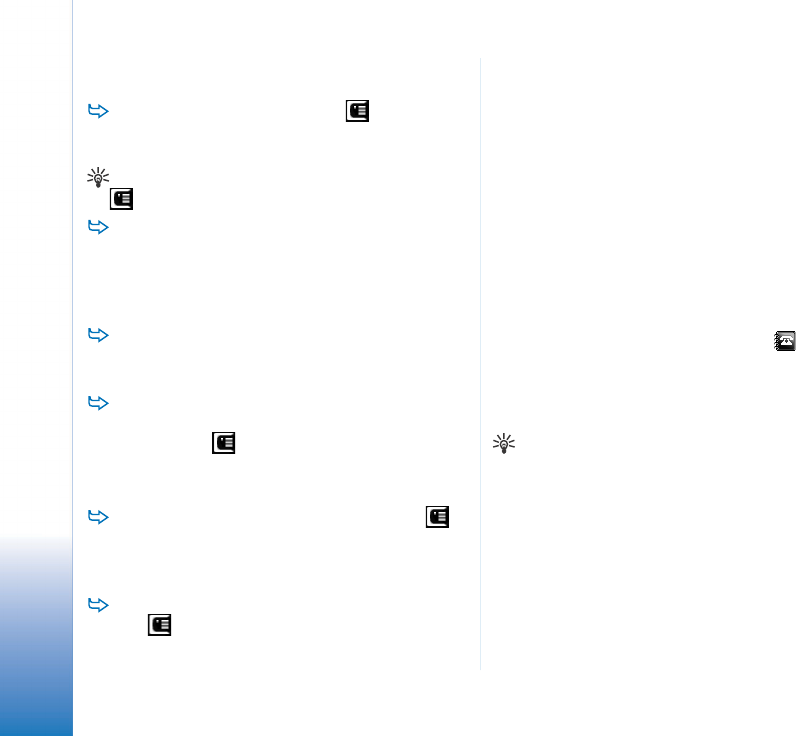
Messaging
52
FCC
any attachment if you are not sure of the trustworthiness
of the sender.
To add e-mail attachments, press in the e-mail
editor and select Attachment > Attach file. Search and
select the file you want to attach to the e-mail.
Tip: To add your contact card as an attachment, press
and select Attachment > Attach 'My contact card'.
To view attachments, open a received or sent e-mail
message containing attachments and double-tap the
attachment icon at the bottom of the message. If the
attachment file format is not recognised by the
system, a question mark icon is displayed.
To save attachments, open the e-mail message
containing attachments, select the attachment at the
bottom of the message and tap Save.
To delete an attachment while creating an e-mail
message, select the attachment at the bottom of the
message, press and select Attachment > Remove.
Signatures
To define an e-mail account signature, press ,
select E-mail > Signatures..., tap Edit and write the
signature. Select the Attach 'My contact card': to add
your contact card to any e-mail message you send.
To enable or disable an e-mail account signature,
press , select E-mail > Signatures... and select or
clear the signatures to enable or disable them. The
signature must be defined to be enabled.
Text messages
The Short Message Service (SMS) enables you to send and
receive text messages over the digital wireless network.
Sending text messages
1Tap New text message in the main view of the
Messaging application.
2Write the phone number in the To: field. Add a
semicolon (;) to separate each recipient.
If the recipient is in your Contacts, tap . Select the
recipient from the list and tap Add. Tap Done when you
have selected all recipients.
3Write the message and tap Send. Note that a text
message can only contain unformatted, plain text.
Tip: When sending a text message that contains
special or accented characters, note that not
necessarily all devices support special characters.
Your device supports the sending of text messages beyond
the normal 160-character limit. If your message exceeds
160 characters, it will be sent as a series of two or more
messages.
Character counter at the bottom of the text message
window shows the number of characters used in the
message in real time. If the number of characters exceeds
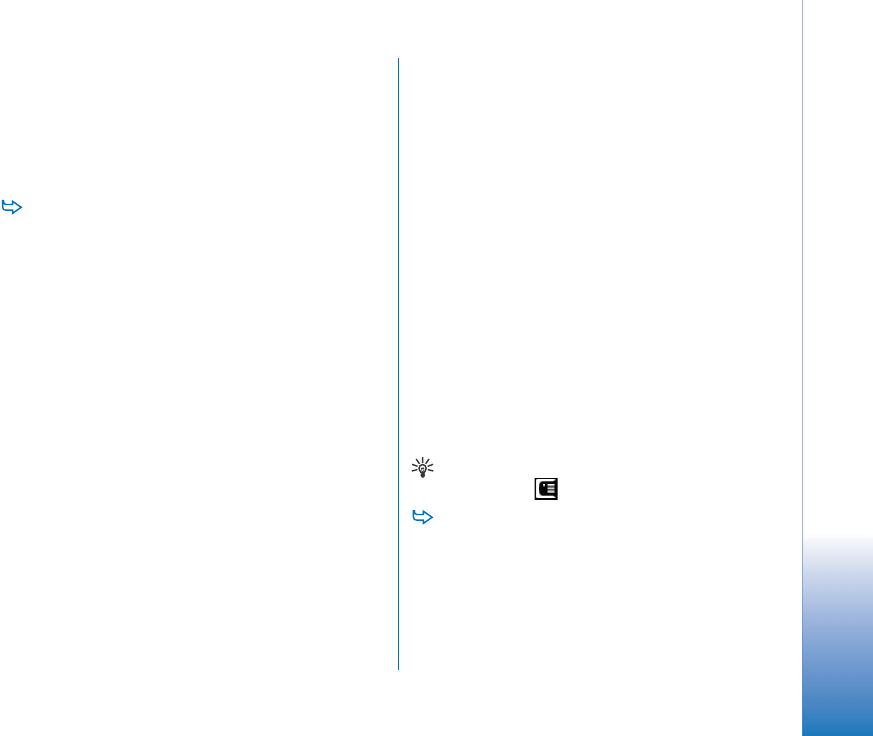
Messaging
53
FCC
160 characters, then also the number of messages required
to transmit the message is displayed.
Using special (Unicode) characters such as ë, â, á, ì takes
up more space.
Note also that sending a message in several parts may be
more expensive than sending just one message.
To specify sending options for the current message,
tap Sending options. Note that any changes you make
in this dialog affect only the current message you are
about to send. Define the following:
General page
Message centre in use: — Select which message centre is
used for delivering text messages.
Receive report: (network service) - If you select this, you can
view the status of the sent message in the Log application.
If you do not select this check box, only the status Sent is
shown in Log.
Send message: — Define when you want the message to be
sent. The option On request means that the message is
saved in Outbox when you tap Send. The message is sent
when you select the message in Outbox and tap Send.
Advanced page
Message validity: (network service) — If the recipient of a
message cannot be reached within the validity period, the
message is removed from the text message centre. Note
that the network must support this feature. Maximum
time is the maximum amount of time allowed by the
network.
Reply via same centre: (network service) — Select this if you
want the reply message to be sent using the same
message centre number.
Message sent as: — Change this option only if you are sure
that your message centre is able to convert text messages
into other formats. Contact your network operator.
Receiving text messages
Text messages are received automatically, provided that
this service is available and that the device is on and
within network coverage.
When a new text message arrives, a tone will sound -
unless the device is using a silent profile - and a dialog
opens on the display. Tap Open to open the message. To
open a message in Inbox, double-tap it.
Tip: To create a contact card for the sender of a text
message, press and select Tools > Add to Contacts....
To reply to text messages, open the original message
and press Reply. Write your reply and tap Send. The
original message is included in the reply if you have
the Include original in reply: check box selected in text
message settings.
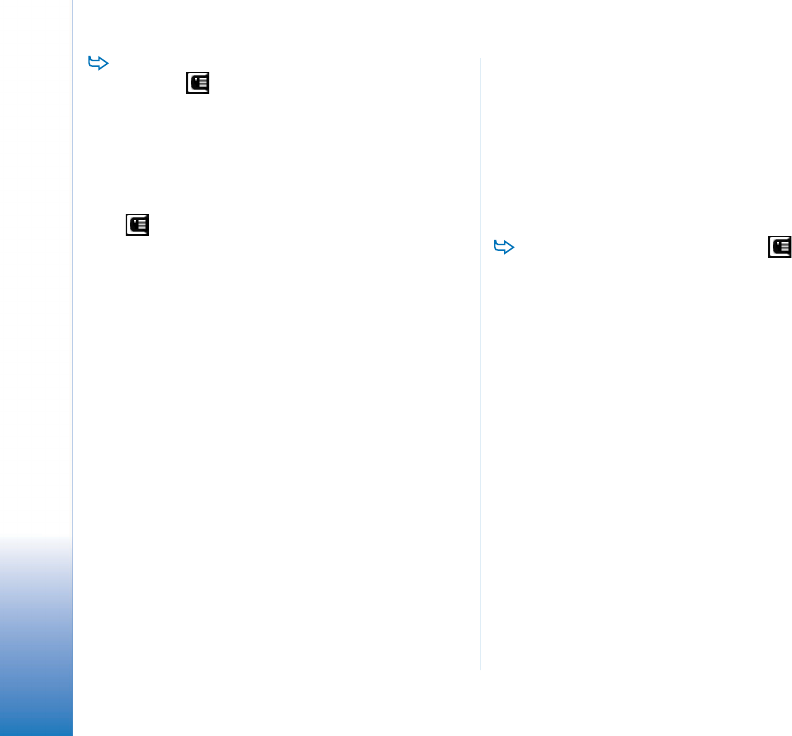
Messaging
54
FCC
To move, copy, or delete messages from the SIM
card, press and select Message > SIM messages....
Select the messages and tap the corresponding button.
Text message settings
Any changes you make to text message settings affect the
way in which your text messages are sent and received.
Press in the main view of Messaging and select Tools
> Message settings > Text message.... Define the following:
General page
Message centre in use: - Select which message centre is
used for delivering text messages.
Receive report: (network service) - If you select this, you
can view the status of the sent message in the Log
application. If you do not select this check box, only the
status Sent is shown in Log.
Send message: - Define when you want the message to be
sent. The option On request means that the message is
saved in Outbox when you tap Send in the message editor
view. The message is sent when you select the message in
Outbox and tap Send.
Advanced page
Message validity: — If the recipient of a message cannot be
reached within the validity period, the message is
removed from the text message centre. Note that the
network must support this feature. Maximum time is the
maximum amount of time allowed by the network.
Reply via same centre: (network service) — Select this if you
want the reply message to be sent using the same text
message centre number.
Include original in reply: — Specifies whether text in the
received text message is copied to your reply.
Preferred connection: — You can send text messages via
normal GSM network or via GPRS, if supported by the
network.
To add a new message centre, press , and select
Tools > Message settings > Text message.... Tap Msg.
centres, then New. Write a name and number for the
text message centre. You receive the number from your
service provider. Select the Set as default centre: check
box if you always want to use this message centre for
sending text messages.
About text message services
Text messages can be sent or received even during voice,
data, and fax calls. Messages can be read in any mobile
phone that has this capability. If the phone receiving the
message is switched off at the time of sending, the
message centre continues to attempt to send the message
until the validity period allowed by the network expires.
If you want to send text you have written or edited in
another application as a text message, all embedded
objects or any rich text formatting will be lost. You cannot
send attachments as text messages, either.
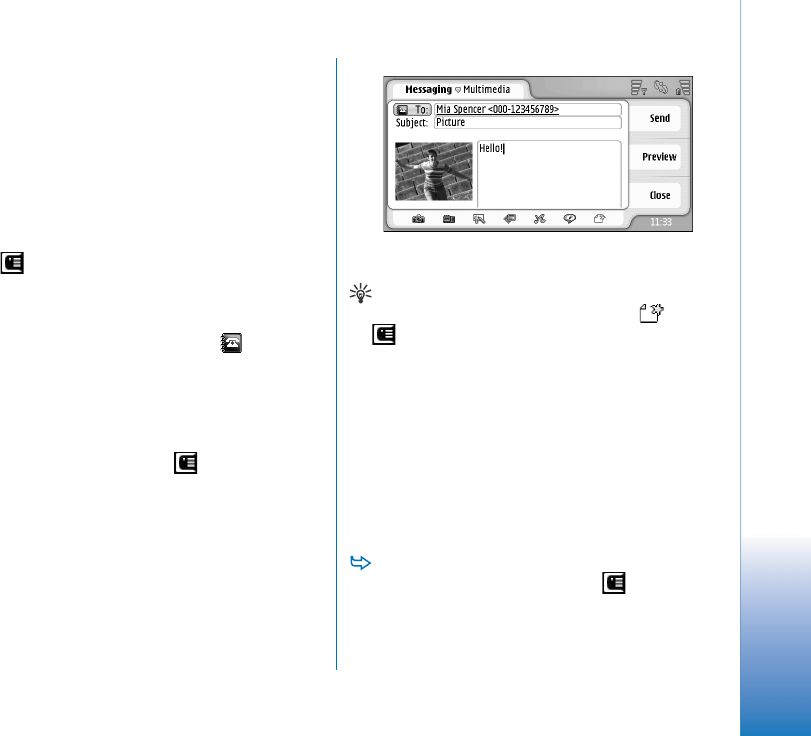
Messaging
55
FCC
Multimedia messages
A multimedia message can contain text, images, video
clips, and/or sound clips.
Copyright protections may prevent some images, ringing
tones, and other content from being copied, modified,
transferred, or forwarded.
Creating multimedia messages
1Press , and select Message > Create > Multimedia
message.
2Write the recipient’s telephone number in the To: field.
Add a semicolon (;) to separate each recipient.
If the recipient is in your Contacts, tap . Select the
recipient from the list and tap Add. Tap Done when you
have selected all recipients.
3Write the message and add a media object. Use the
toolbar, or the menu command Insert to add images,
sound, or video to your message. See below for details.
If the toolbar is not visible, press , and select Display
> Toolbar.
4When the message is ready, tap Send.
Fig. 18: Sending a multimedia message
Tip: A multimedia message may contain several
pages. To add pages, tap the toolbar icon , or press
, and select Insert > Page break. If the cursor is in
the To:, Cc: or Subject: field when you add a page, the
new page will become the first page of the message.
Otherwise, the new page is added after the page where
the cursor is. Note that each page can contain only
one video or one sound clip. You can, however, have in
one message several pages that contain a video or a
sound clip. The maximum size of a multimedia
message supported by your device is 100 kB. To limit
the content of your messages, see MMS settings,
“General page” on page 58.
To insert an existing image, sound, or video to your
message, use the toolbar, or press , and select
Insert > Image, Track or Media clip. Browse for the item,
and tap Insert to add it to the message. Note that
wireless network may limit the size of MMS messages.
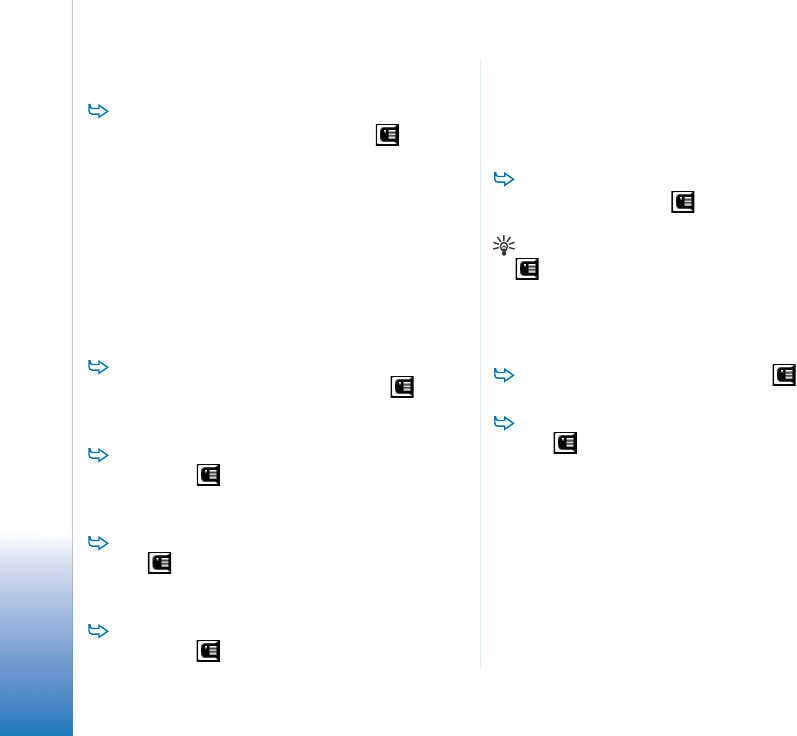
Messaging
56
FCC
If the inserted picture exceeds this limit, the device
may make it smaller so that it can be sent by MMS.
To create a new picture, drawing or voice clip for
your message, use the toolbar, or press , and
select Insert > New image/media clip, New sketch or
Sound clip. The corresponding application opens. See
“Taking pictures” on page 73, “Editing images” on
page 79, or “Voice recorder” on page 90 for details. Tap
Insert to add the item to message.
Note that if some of the menu items under Tools menu are
not available or you get an error message when trying to
insert a multimedia item, your settings may be too
restricted. See MMS settings, “General page” on page 58
for details.
To change the position of text in relation to an
image or video, select the text field, press , and
select Tools > Page layout > Place text on right or Place
text on left. (Not available in Restricted mode:.)
To format text, select the text by dragging the stylus
over it, press , and select Tools > Format text.... You
can also select the formatting first and then start
writing. (Not available in Restricted mode:.)
To change the background colour of a message,
press , and select Tools > Set background colour....
Tap the colour square and choose a new colour. (Not
available in Restricted mode:.)
To add effects to multimedia objects, select the
object, press , and select Tools > Transition
settings.... You can specify how long an object is
displayed and how a new object is opened. (Not
available in Restricted mode:.)
The appearance of a multimedia message may vary
depending on the receiving device.
To delete a multimedia object from a message,
select the object, press , and select Edit > Delete.
Select the appropriate command.
Tip: To add new pages to a multimedia message, press
and select Insert > Page break. If the cursor is in the
To:, Cc:, or Subject: field when you add a page, the new
page becomes the first page of the message. Otherwise,
the new page is added after the page where the cursor
is located.
To delete a page, go to the page, press , and select
Edit > Delete > Page.
To specify sending options for the current message,
press , and select Tools > Sending options... . Note
that any changes you make in this dialog affect only
the current message you are about to send. Define the
following:
Receive report: - (network service) Select this, if you want
to receive a notification when the message has been
delivered to the multimedia messaging centre.
Message validity: - (network service) If the recipient of a
message cannot be reached within the validity period,
the message is removed from the multimedia

Messaging
57
FCC
messaging centre. Note that the network must support
this feature. Maximum time is the maximum amount of
time allowed by the network.
To preview the message before sending, press , and
select Message > Preview.
Toolbar
If toolbar is not visible press , and select Display >
Toolbar.
1Take a picture or record video.
2Record a sound clip or insert an existing sound clip.
3Create a sketch image.
4Insert an image.
5Insert a music clip.
6Insert a video clip.
7Insert a page break.
Receiving multimedia messages
Multimedia messages are received in your Inbox and you
can open, reply to, or forward them just like other
messages.
You may be able to receive multimedia messages
containing objects unsupported by your device, but you
cannot view them. You may be able to, however, forward
these messages to another device.
Important: Multimedia message objects may contain
viruses or otherwise be harmful to your device or PC. Do
not open any attachment if you are not sure of the
trustworthiness of the sender.
To save a selected multimedia object, press ,
and select Tools > Save object....
To view details of an object, double-tap it.
To view a list of all the objects in a message, press
, and select Tools > View objects.... To save an
object select it and tap Save. To play an object, select
it, and tap Open.
Multimedia message settings
Any changes you make to multimedia message settings
affect the way in which your messages are sent and
received. You may receive these settings as a special
message from your service provider.
Press in the main view of Messaging, and select Tools
> Message settings > Multimedia message.... Define the
following:
Sending page
Access point in use: - Choose the Internet access point (IAP)
connection you want to use for sending messages. To
create an IAP, see “Setting up an Internet access point” on
page 107.
Homepage: - Write the address of the multimedia
messaging centre.

Messaging
58
FCC
Receive report: - Select this, if you want to receive a
notification when the message has been delivered to the
intended destination. Receiving a delivery report of a
multimedia message that has been sent to an e-mail
address may not be possible.
Send message: - You can select when you want the
message to be sent.
Message validity: - (network service) If the recipient of a
message cannot be reached within the validity period, the
message is removed from the multimedia messaging
centre. Note that the network must support this feature.
Maximum time is the maximum amount of time allowed by
the network.
Retrieval page
On receiving messages: - Select Retrieve immediately if you
want to receive multimedia messages. Select Defer
retrieval if you want the multimedia messaging centre to
save the messages to be retrieved later. Select Reject
message if you want to reject multimedia messages. The
multimedia messaging centre will delete the messages.
Receive advertisements: - Select this, if you want to allow
the reception of messages defined as advertisements.
Allow anonymous messages: - Select this, if you want to
allow reception of messages from unknown senders..
To define your Internet access point, press , and
select Tools > Message settings > Multimedia message....
Tap Internet setup and Next. See “Setting up an
Internet access point” on page 107 for details.
General page
Multimedia mode: - Select Restricted mode: to limit the
MMS message features and make the message more
compatible with other phones. Text formatting and
multimedia options are restricted. Select Guided mode: to
allow more options with warnings when basic options are
exceeded. Select Free mode: to use a full set of features in
MMS messages.
Smart messages
Your media device can receive many kinds of smart
messages, text messages that contain data, also called
Over-The-Air (OTA) messages. Examples of these are
picture messages, business cards, ringing tones, or
calendar entries.
You can also receive a text message service number, voice
mailbox number, profile settings for remote
synchronisation, access point settings for the browser,
multimedia messaging or e-mail, access point login script
settings, or e-mail settings as OTA messages.

Messaging
59
FCC
Service messages
Service messages are notifications of, for example, news
headlines and may contain a text message or a link. For
availability and subscription, contact your service provider.
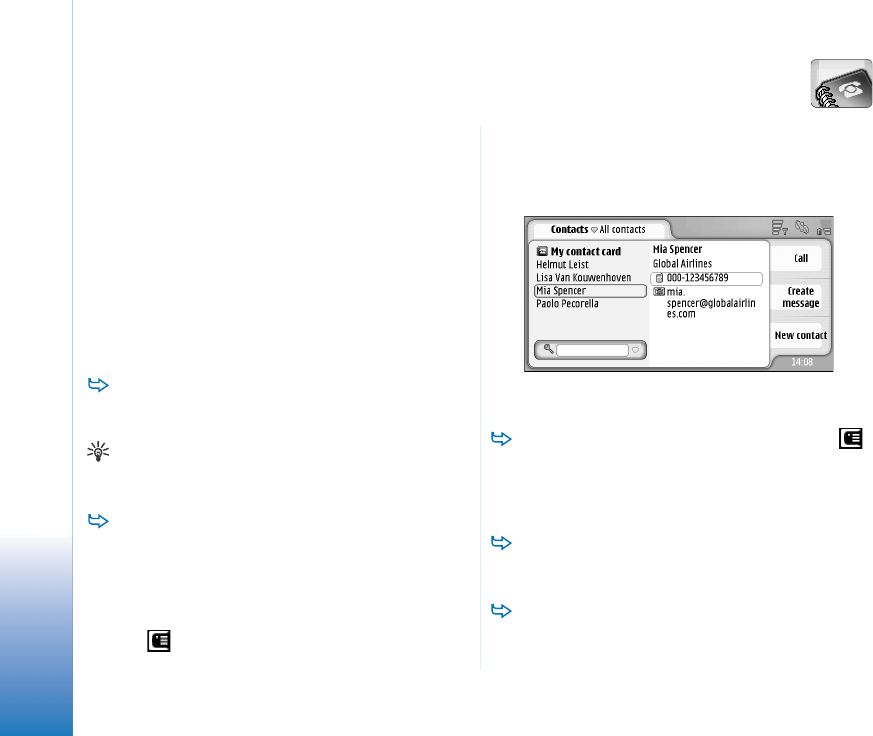
Contacts
60
FCC DRAFT
Contacts
Go to Desk > Contacts.
You can use Contacts to create, edit, and manage all
contact information, such as phone numbers and
addresses.
For information on synchronising your contacts with
compatible PC applications, see the PC Suite Guide on the
sales package CDROM.
Viewing and searching for
contacts
To view a contact card, tap a name in the list of
contacts. Double-tapping opens the contact card for
editing.
Tip: Double-tap the phone number in the right pane
to call the contact. Similarly, you can send e-mail by
double-tapping an e-mail address.
To search for a contact card, tap the letters in the
bottom row corresponding to the name on the card
you want to see. For example, tap once to see contacts
beginning with the letter M, twice for contacts
beginning with the letter N, and three times for
contacts beginning with the letter O. Alternatively,
press , and select Display > Search field to display a
search field. Start writing the name of the contact in
the search field. The list of contacts changes to show
the matching contacts as you write.
Fig. 19: Contacts main window with find field.
To change the sorting order of contacts, press ,
select Display > Sort by, and select the appropriate order.
Creating and editing contacts
To make a new contact card, tap New contact, tap on
an empty field and enter the information. See also
“Contact card fields” on page 61.
To edit a contact card, double-tap a contact in the list
to open it, edit the card as necessary, and tap Done.

Contacts
61
FCC
To delete a contact card, select the contact, press
, and select Contact > Delete. Note that you cannot
delete your own card.
To add a speed dial to a contact, open the contact by
double-tapping it, and tap on the phone number field
where you want to add the speed dial. Press ,
select Tools > Assign speed dial..., select a speed dial
number, and tap Assign.
To set a specific ringing tone for a contact, open the
contact by double-tapping it. If the Personal ringing
tone field is not on the card, tap Add field, select the
appropriate field from the list, and tap OK. Double-tap
the Personal ringing tone field. Select a ringing tone. Tap
Play to listen to the tone.
To insert a picture, open the contact by double-
tapping it, and double-tap the picture place holder on
the top right. Select a picture, and tap Add to add it
without editing or Edit to open the picture in an image
editor where you can modify it. Use the stylus or the
scroll key to select the area of the image to be inserted.
Use the toolbar to zoom, flip or rotate the image, or to
add a coloured border to it. When you are happy with
the picture, tap Add to add the picture to the contact
card. To remove a picture, press , and select Image
> Remove.
To show the correct address format of your home
country or region, press , select Tools > Address
format..., and select your country or region from the
list. The new setting applies to all cards if defined from
the main view or just the current card if defined while
editing a card.
To create or edit SIM contact cards, press , and
select Tools > SIM directory.... Tap New or select a
contact, and tap Edit. SIM contact cards are cards that
are saved only in your SIM card, not in the device
memory.
The length of the name and phone number you can enter
is defined by the SIM card. For example, some SIM cards
allow a maximum of only fourteen characters.
Contact card fields
To add more fields to a contact card, open the
contact card, and tap Add field. Select the appropriate
field from the list. To remove a selected field, press
, and select Contact > Remove field. These changes
will only affect the card you are currently modifying.
To rename a field, select a field, press , and select
Contact > Rename field.... Write the new name. If the
Rename field... menu command is dimmed, it means that
you cannot edit that field.
To modify the contact card template, press , and
select Tools > Card template.... Tap Add field to add a
new field, or select a field, and tap Remove field to
delete it. Note that not all fields can be removed. These
changes affect all contact cards, except for the SIM
contact cards.
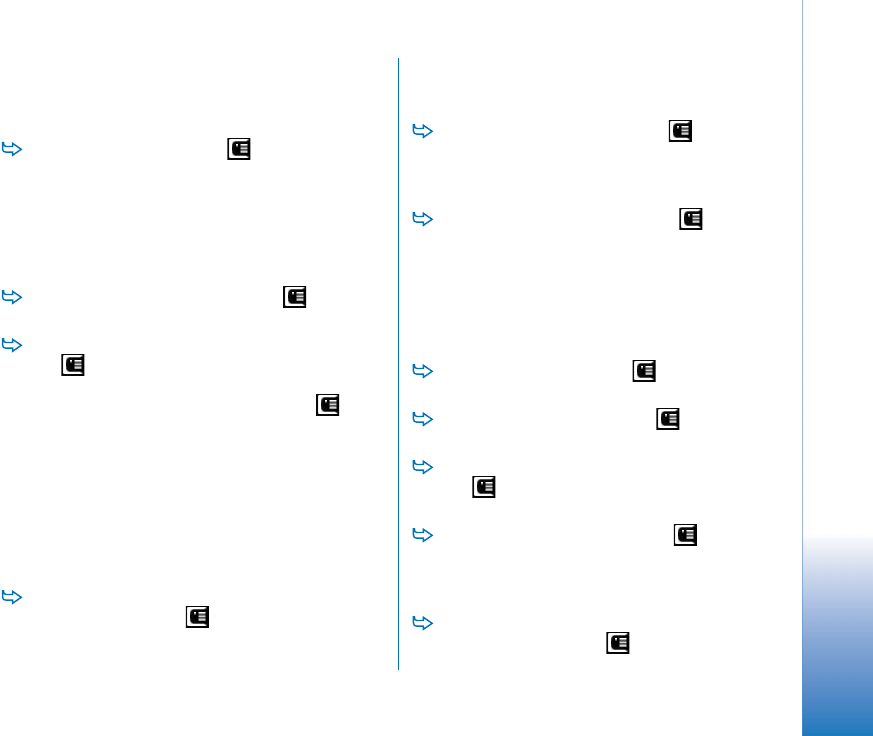
Contacts
62
FCC
Transferring contacts
Note that contact information can only be sent to or
received from compatible devices.
To send a contact card, press , and select Contact
> Send. Select the method of sending. To send your
own contact card, select your card, and tap Send.
Select the message type. Your contact card is sent as a
business card in vCard format. For more information on
sending options, see “Messaging” on page 45 and
“Sending data via Bluetooth” on page 123.
To copy a contact to a SIM card, press , and select
Contact > Copy to SIM directory...
To copy individual SIM card contacts to Contacts,
press , and select Tools > SIM directory.... Select the
contact, and tap Copy to Contacts. To copy all the
contacts of a SIM card to Contacts, press , and
select Tools > Copy SIM directory to Contacts.... Tap Copy.
Voice tags
When you attach a voice tag to a contact card, you can call
the contact with the tag by activating voice dialling and
saying the voice tag you have recorded. For more
information, see “Voice dialling” on page 38.
To set a voice tag for a contact, open the contact by
double-tapping it. Press , and select Tools > Add
voice tag.... Select the phone number to which you want
to add the voice tag, and tap OK. Tap Start. After the
tone, speak clearly into the microphone the word(s)
you want to record as a voice tag. After recording, the
media device plays the recorded tag and saves it.
To view a list of voice tags, press , and select
Tools > Voice tags.... The list shows all the contacts that
have a voice tag attached. You can add voice tags to
up to 50 phone numbers.
To edit or delete a voice tag, press , and select
Tools > Voice tags.... Tap Change or Delete.
Contact groups
You can organise your contacts into groups, and add a
ringing tone for a group.
To create a new group, press , and select Group >
New.... Write a name for the group.
To switch between groups, press , and select View
group. Select the group you want to view.
To add a contact to a group, select a contact, and
press . Select Group > Add to group..., select the
group by marking the check box, and tap OK.
To rename or delete a group, press , select Group
> Manage groups..., select a group, and select the
corresponding command. Note that you cannot
rename or delete the group All contacts.
To add or remove group members, select the group
you want to modify, press , and select Group > Edit

Contacts
63
FCC
group.... Select a contact from the list on the left to add
it to the group. Tap Add. To remove a group member,
select a contact from the list on the right and tap
Remove.
To add a ringing tone for a group, open the Profiles
application. Select the profile you want to assign for
the group, and tap Personalise, then Alert for. Select
the group, and tap OK. When a group member calls or
sends a message to you, the device plays the chosen
ringing or alert tone (if the caller’s telephone number
is sent with the call and your device recognises it).
Other callers will be handled using the Silent profile.
For more information on profiles, see “Profiles” on
page 43.
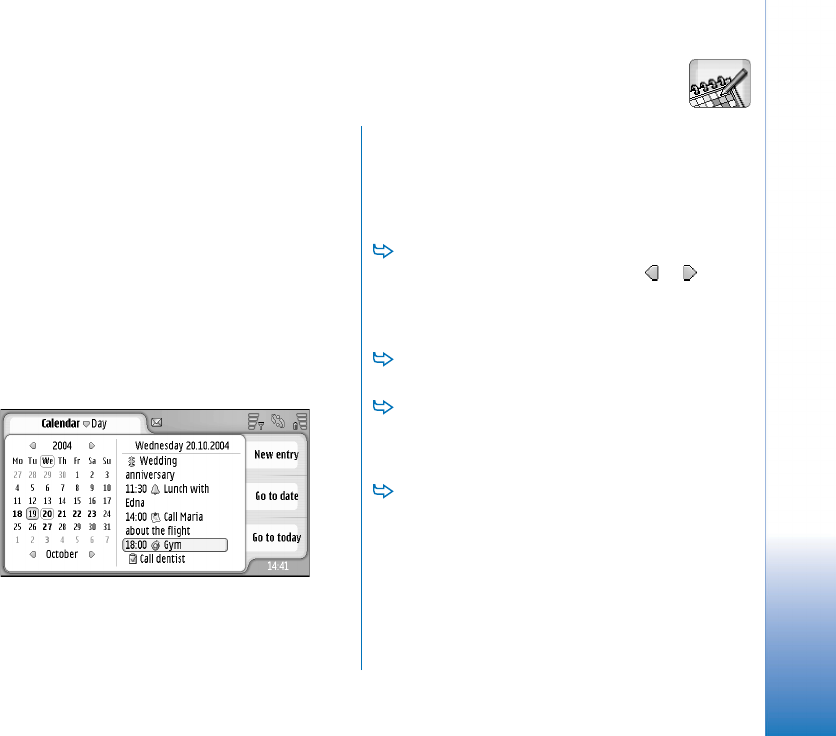
Calendar
64
FCC DRAFT
Calendar
Go to Desk > Calendar.
In the Calendar application you can create and check your
scheduled events and appointments. You can also set
alarms for all of the calendar entries.
You can synchronise your calendar with Microsoft Outlook
98/2000/2002/2003, Microsoft Outlook Express, Lotus
Notes 5.0/6.0, or Lotus Organizer 5.0/6.0, if you connect
your device to a compatible PC. For information on
synchronisation, see the PC Suite Guide on the CDROM.
Day view
Fig. 20: Day view
If you are using the default theme, today’s date is framed,
dates that have scheduled events are marked in bold, and
the currently selected date is highlighted with brown.
The events of the currently selected date are shown in the
frame on the right.
To go to a date visible in the left frame, tap it. To
move to the previous or next year, tap or next to
the year at the top of the left frame. Similarly, to move
to the previous or next month, tap the arrows next to
the name of the month at the bottom of the left frame.
To go to a specific date, tap Go to date, and specify
the day, month, and year.
To go to the current date, tap Go to today.
Managing entries
To create a new calendar entry, select the date in the
day view, and tap New entry. Fill in the fields. If the
event entry is related to the whole day, select the All-
day entry: check box and specify the start and end date
for the entry. If it is not related to the whole day,
specify the start and end time for the entry. To set a
reminder for an entry, select the Alarm: check box.
Specify the day and time when the alarm will go off. To
repeat an entry, tap Repeat. Define the repeat
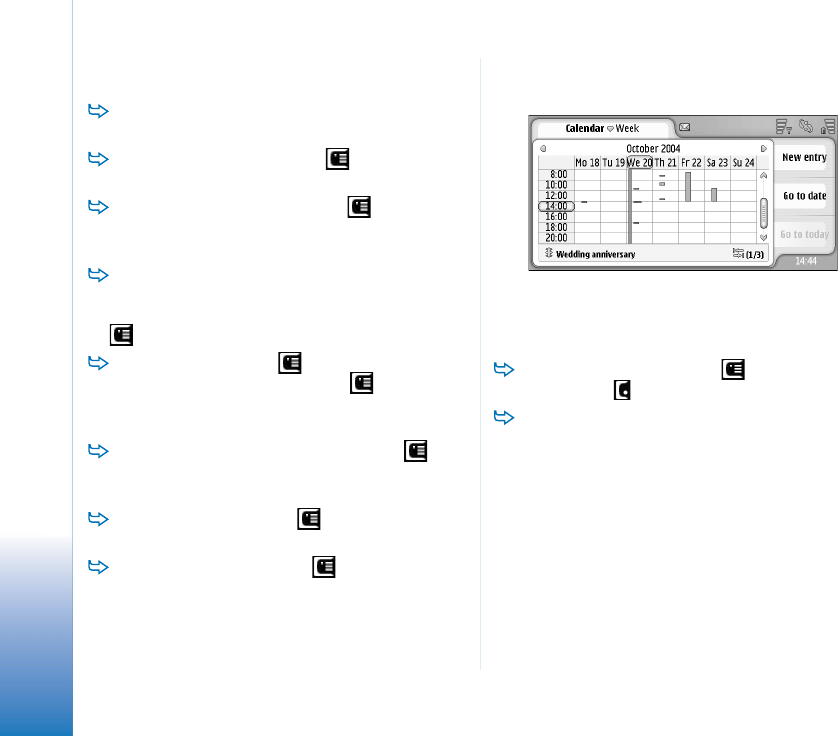
Calendar
65
FCC
frequency and the possible end date. When you have
specified all the required details, tap Done.
To edit an entry, double-tap it, and make the
changes. Then tap Done.
To send a calendar entry, press , and select Entry
> Send. Select the sending method.
To make an entry tentative, press , and select
Entry > Mark as tentative. A tentative entry is marked as
dimmed in the list of entries.
To make an entry private so that the details will not
be shown to others when your calendar is
synchronised with a networked PC calendar, press
, and select Entry > Mark as private.
To delete an entry, press , and select Edit > Delete.
To delete a range of entries, press , and select
Tools > Delete entries.... Define the time scope of the
entries to be removed.
To define the default entry settings, press , and
select Tools > Entry template.... Define the type of an
entry you would most commonly use.
To view to-do notes, press , and select Display >
To-do notes.
To search for an entry, press , and select Edit >
Find.... Write the text in the search field. You can tap
Options and specify a search period. Tap Find to start
the search.
Week view
Fig. 21: Week view
The week view shows the reserved hours for the selected
week with bars. The currently selected time box is framed.
To open the week view, press , and select View >
Week, or press .
To select a time box, tap it. Double-tap a time box to
view or edit the entry details. To move to the previous
or next week, tap the arrows at the top corners of the
week view.
If a time box contains an entry, the area at the bottom
of the screen shows the details of the entry. If there is
more than one entry in a single time box, the numbers
in the right-hand corner indicate the number of entries
in the time box. For example, 1/3 means that there are
three entries in that time box and you are viewing the
details of the first of the three entries.

Calendar
66
FCC
To view all the entries of a time box containing more
than one entry, tap , or tap the number of the entry
on the bottom right-hand corner.
Icons
The following symbols are used in the Calendar
application:
- Entry with an alarm
- All-day event
- Repeated entry
- Entry with a note
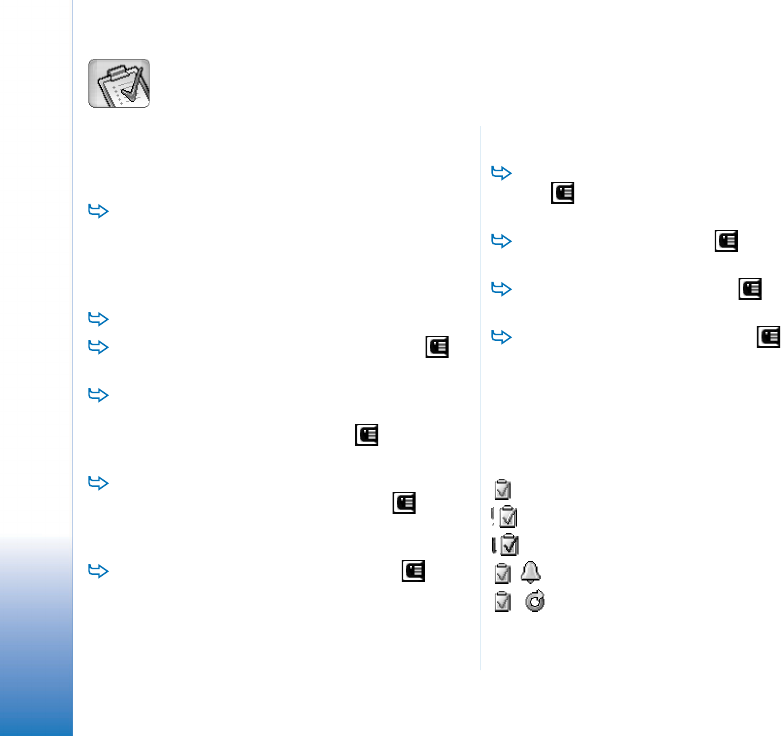
To-do
67
FCC DRAFT
To-do
Go to Desk > To-do.
With the To-do application you can create and manage
task lists.
To create a new task, tap New to-do note. Fill in the
fields. To set a reminder for the note, select Due date:
and Alarm: and specify the day and time when the
alarm will go off. To repeat the task, tap Repeat.
Define the repeat frequency, and the possible end date.
To edit a note, double-tap it, and make the changes.
To mark the selected task as complete, press ,
and select To-do note > Mark as completed.
To make a note private so that the details will not be
shown to others when your calendar is synchronised
with a networked PC calendar, press , and select
To-do note >Mark as private.
To delete a to-do note, select the note, and tap
Delete. To delete a range of notes, press , and
select Tools > Delete to-do notes.... Define the time scope
of the entries to be removed.
To define the default note settings, press , and
select Tools > To-do note template.... Define the type of
a note you would most typically use.
Grouping to-do notes
To add a note to a group, select a to-do note, and
press . Select Group > Add to group..., select the
group, and tap OK.
To create a new group, press , and select Group >
New.... Write a name for the group.
To switch between groups, press , and select View
group. Select the group you want to view.
To rename or delete a group, press , select Group
> Manage groups..., select a group, and select the
corresponding command.
Icons
The following symbols are used in the To-do application:
- To-do note
- To-do note with high importance
- To-do note with low importance
- To-do note with an alarm
- Repeated to-do note

Web
68
FCC DRAFT
Web
Go to Desk > Web.
To connect to the World Wide Web:
• The wireless network you use must support data calls or
GPRS.
• The data service must be activated for your SIM card.
• You must configure Internet access point and Internet
connection settings. For more information, see
“Internet setup” on page 107.
Fig. 22: Web
Plug and play mobile services
Your device supports plug and play mobile services, which,
for example, allow you to subscribe to data services and
receive the required settings. Note that to be able to use
this feature, your network operator must support it. In
some networks this feature may be available without a
data services subscription.
When you try to connect to the World Wide Web and have
not subscribed to a data service, or your Internet access
point or Internet connection settings are invalid, your
device asks if you want to subscribe to a service or create
settings yourself.
If you choose to subscribe, you are directed to the service
home page, from where you can order settings (MMS,
WAP/GPRS, e-mail and Internet) by following given
instructions.
Using the web browser
To open a web page, write the address of the page
into the address field at the bottom of the display, and
tap or press the centre of the scroll key. If you
have specified a home page, tap to go to that web
page. If you have a bookmark of the page you want to
visit, tap , select a bookmark, and tap it to go to
that web page.
Tip: As you write, the previous matching web
addresses, if any, are shown in a list above the address
field. Tap an address in the list to select it.
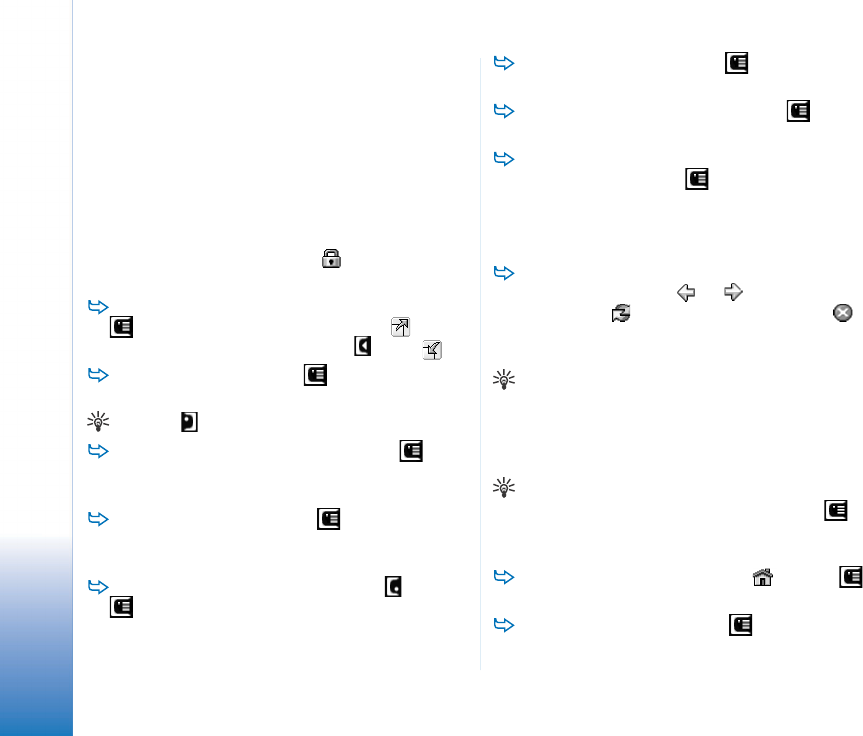
Web
69
FCC
If you have selected the Ask before connecting: check box
when setting up the Internet connection, a dialog opens
asking you to confirm the connection or to change the
access point. You can choose not to be shown this dialog
when the connection is made. See “Internet connection
settings” on page 110.
Duration for establishing an Internet connection may vary
depending on the network configuration and load.
If the web page and its components are encrypted by a
security protocol, the security icon appears on the
address bar.
To have the web page fill the entire screen, press
, and select Display > Full screen or tap . To
return to a normal screen size, press or tap .
To adjust the volume, press , and select Tools >
Volume....
Tip: Press to use the zoom function.
To save a web page on your device, press and
select File > Save web page.... You can then view the
web page without connecting to the Internet.
To open a new window, press , and select File >
New window. The number of open windows depends
on, and is limited by, the memory available.
To switch between open windows, press , or press
, select View, and choose the window you want to
open.
To close extra windows, press , and select File >
Close > Current window or All windows.
To disconnect from the Internet, press , and
select File > Disconnect.
To view local downloaded web pages without
accessing the web, press , and select File > Browse
offline.
Navigating
To browse the web, tap the buttons and underlined
links on the display, tap or to browse recently
visited pages, to reload the current page, or to
stop loading the current page. Alternatively, use the
commands in the Navigate menu.
Tip: You can use a web address in a text box or
document as a hyperlink. Tap on the address, or move
the cursor inside it with the scroll key; it becomes a link
with a small icon. Tap the icon to access the web site
if you have an active Internet connection.
Tip: You have more icons visible on the address bar
when the command buttons are hidden: press ,
select Display, and make sure Command bar is not
selected.
To return to your home page, tap or press ,
and select Navigate > Home page.
To set a new home page, press , and select Edit >
Set home page....

Web
70
FCC
To add a bookmark to the current web page, press
, and select Edit > Add bookmark. For more
information on bookmarks, see “Bookmarks” on
page 70.
To go to a search page, press , and select Navigate
> Search page. To define a search page see “Address
page” on page 71.
To display the images of a web page, press , and
select Display > Auto load images.
Tip: Tap on an image or link by holding the stylus down
for about a second to open a popup menu. This has
options to save the image or open the link in a new
window. Zoom option is available in the popup menu
when you tap and hold the stylus down anywhere on a
web page.
Note: Text characters may not be displayed correctly
on web pages with different languages. You may be
able to make a web page more readable by choosing
another character encoding. Press , and select Tools
> Character encoding. Select the language type that best
matches the language of the web page you are viewing.
Bookmarks
The Bookmarks view lists links to web pages in related
folders. You can open a web page by double-tapping a
bookmark in the list.
Your device may have some bookmarks loaded for sites not
affiliated with Nokia. Nokia does not warrant or endorse
these sites. If you choose to access them, you should take
the same precautions, for security or content, as you
would with any Internet site.
To view all bookmarks, tap on the address bar, or
press , and select View > Bookmarks.
To edit the name or address of a bookmark, select
the bookmark, press , and select Bookmark > Edit....
To add a bookmark, tap Add Bookmark. Write a
name for the bookmark, and specify the web address
or file location.
Tip: If the command bar buttons are not visible, press
, and select Display > Command bar.
To move to the previous folder in the folder
hierarchy, tap Up one level.
To create a new folder or rename a folder, press
, and select Bookmark > New folder... or Rename
folder....
Viewing page, cache, plug-in, history,
and download details
A cache is a memory location that is used to store data
temporarily. If you have tried to access or have accessed
confidential information requiring passwords, empty the
cache after each use. The information or service you have
accessed is stored in the cache.
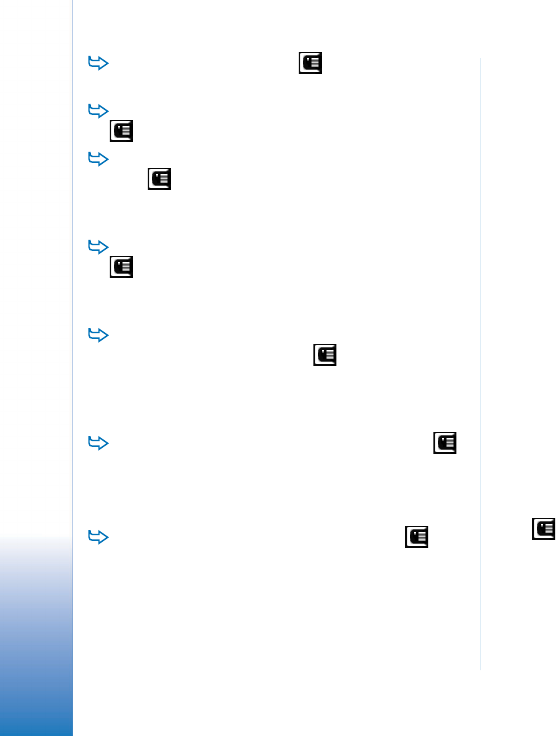
Web
71
FCC
To empty the cache, press , select Tools > Cache
details, and tap Clear.
To view information about the current page, press
, and select Tools > Page details.
To view information about pages you have visited,
press , and select Navigate > History list.... You can
go to the web page by pressing Open. To empty the
history list, tap Clear all.
To view information about the cache memory, press
, select Tools > Cache details. Cache memory is a
temporary storage of the pages you visit. To empty
the cache, tap Clear.
To view the add-on software for the web browser
that has been installed, press , and select Tools >
Plug-in details. Plug-ins can display documents that the
web browser itself cannot show, such as multimedia
clips. You can download plug-ins from the web.
To view details on downloads in progress, press ,
and select Navigate > Downloads....
Web browser settings
To change the web browser settings, press , and
select Tools > Settings.... A dialog with four pages
opens. Define the following:
General page
Maximum cache size (kB): — Define the amount of internal
memory that you want to use as disk cache to speed up
browsing.
Show frames: — Some web pages are split into several
frames, which makes reading difficult. Clear to disable
frames. Note that many pages do not work properly, if you
disable frames.
Default character encoding: — Choose the default character
set.
Address page
Web address suffixes: — If you write here the URL suffixes
(for example: .com, .org, .net) of the web addresses that
you view most often, you can leave them out when writing
the address in the URL address field.
Home page location: — The address of the home page you
use.
Search page location: — The address of the search page you
use.
New window content: — The web page that opens when you
press , and select File > New window.
Plug-ins page
Enable plug-ins — Select to expand browsers functionality
with plug-ins. Plug-ins enable the use of Flash animations
and other extra functionality.
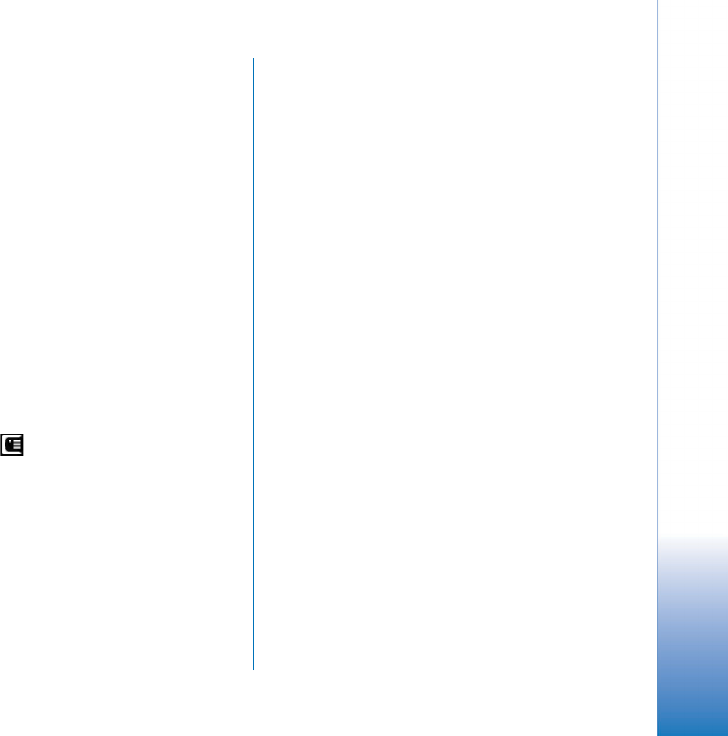
Web
72
FCC
Enable JavaScript — JavaScript functionality is used on
many web sites. To show these pages correctly, select this
option.
Privacy page
Allow automatic redirection: — Select this to enable
automatic redirection to a new web page address, if you
try to open an old page with a redirection command.
Enable pop-up windows: — Select this to make all
unrequested popup windows open automatically.
Accept cookies: — Some web pages store data on your
device in files called ‘cookies’. Use this setting to
determine whether to accept cookies, and if you accept
them, whether you wish to be prompted each time a cookie
is stored or accept them always.
As cookies accumulate with time, they may eventually take
up a large amount of memory space. You can free memory
space by deleting the cookies stored in the memory. To
delete cookies, press , and select Tools > Clear cookies.
Tap Clear.

Camera
73
FCC DRAFT
Camera
You can take pictures and videos with Camera. You can
view and modify pictures with Images, and send your
images as multimedia messages. Videos can be viewed
and sent as multimedia messages with the RealPlayer
application.
To switch between camera and camcorder mode,
tap a corresponding picture on the left side of the
screen.
To open the Camera application, double-tap Camera
in Desk, or tap Go to Camera in the Images
application.
To open the Images application, tap Go to Images in
the camera mode or double-tap Images in Desk.
To open the RealPlayer, tap Go to RealPlayer in the
camcorder mode.
To open Camera in the RealPlayer , tap Go to
Camera.
Camera mode
The camera lens is located on the back of the device. The
display works as a viewfinder.
The Nokia 7710 device supports an image capture of
Megapixel (1152 x 864 pixels) and video size of QCIF (176
x 144 pixels). The image resolution in these materials may
appear different.
Taking pictures
To take a picture, aim at your subject, and press the
centre of the scroll key, or tap Capture. If the Preview
setting is on, you can view the picture to decide
whether to keep it or not. If you tap Save or press the
centre of the scroll key, the picture is saved
automatically in the Images application in the folder
displayed in the title area of the screen.
Fig. 23: Taking a picture
Tip: In the top-right hand corner of the viewfinder you
can see the number of pictures you can still take with

Camera
74
FCC
the memory available. The stars indicate the picture
quality level. Tap the area to open Camera settings.
To show less or more of the subject before taking a
picture, tap Zoom in or Zoom out, or press and
on the scroll key.
Camcorder mode
To switch to Camcorder mode, tap the icons on the
left side of the screen..
To record the video, aim at your subject, and press the
centre of the scroll key, or tap Record. To stop, tap
Stop.
The maximum recording time is one hour per clip.
Tip: In the top-right hand corner of the viewfinder you
can see the selected quality level of the video and how
long you can still record with the memory available.
Tap the area to open Camera settings.
Camera settings
To edit the camera settings, press , and select
Tools> Settings.... Define the following:
General page
Theses settings affect both picture taking and video
recording.
Contrast: — Adjust the contrast of the picture or video as
appropriate. This affects both the viewfinder image and
the picture taken.
Brightness: — Adjust the brightness of the picture or video
as appropriate. This affects both the viewfinder image
and the picture taken.
Memory in use: — Select internal memory or memory card
as the storage location of the pictures and videos.
Image page
Image quality: — Indicated by stars in the corner of the
viewfinder. The better the picture quality, the more
memory the picture consumes.
Default image name: — Set a name for the pictures taken.
By default, the pictures are named in the format
’Image’. For example, if you set ‘Beach’ as the default
name, Camera will name the pictures you take ‘Beach’,
‘Beach(01)’, ‘Beach(02)’, and so on, until you change
the setting again.
Preview before saving: — If you select this option, you can
view a picture you have taken and decide whether to
keep it or not. If this option is not selected, all the
pictures that you take are saved automatically without
a chance to preview them.

Camera
75
FCC
Video page
Quality: — Indicated by stars in the corner of the
viewfinder. The better the video quality, the more
memory the video consumes.
Default video name: — Set a name for the video taken. By
default, the video is named ‘newvideo’. For example, if
you set ‘Beach’ as the default name, the following
videos are named ‘Beach(01)’, ‘Beach(02)’, and so on,
until you change the setting again.
Tips on taking good photographs
Here are some tips on how to get the most out of your
device’s camera.
Picture quality
Use the appropriate picture quality. The camera has
three picture quality modes (Basic, Normal, and High). Use
the High setting to make sure that the camera produces
the best picture quality available. Note however, that
better picture quality requires more storage space. For
MMS and e-mail attachments it may be necessary to use
Normal, or Basic setting. You can define the quality in
Tools> Settings... and the quality level is indicated in the top
right hand corner of the viewfinder.
Background
Use a simple background. For portraits and other
pictures with people, avoid having your subject in front of
a cluttered, complex background that may distract
attention from the subject. Move the camera, or the
subject, when these conditions cannot be met.
Depth
When shooting landscapes and sceneries, you can add
depth to your pictures by placing objects into the
foreground. Note however, that if the foreground object
is too close to camera, it may be blurred.
Lighting conditions
Changing the source, amount and direction of light can
change photographs dramatically. Here are some typical
lighting conditions:
•Light source behind the subject. Try to avoid placing
your subject in front of a strong light source. If the
light source is behind the subject or visible in the
display, the resulting picture may have weak contrast,
may be too dark, and may contain unwanted light
effects.
•Sidelit subject. Strong side light gives dramatic effect
but may be too harsh resulting in too much contrast.
•Light source in front of the subject. This is generally
quite usable except that a harsh sunlight may cause

Camera
76
FCC
the subjects to squint their eyes. The contrast may also
be too high.
•Optimal lighting is found in situations, where there is
plenty of diffused, soft light available like for example,
on a bright, partially cloudy day or on a sunny day in
the shadow of trees.
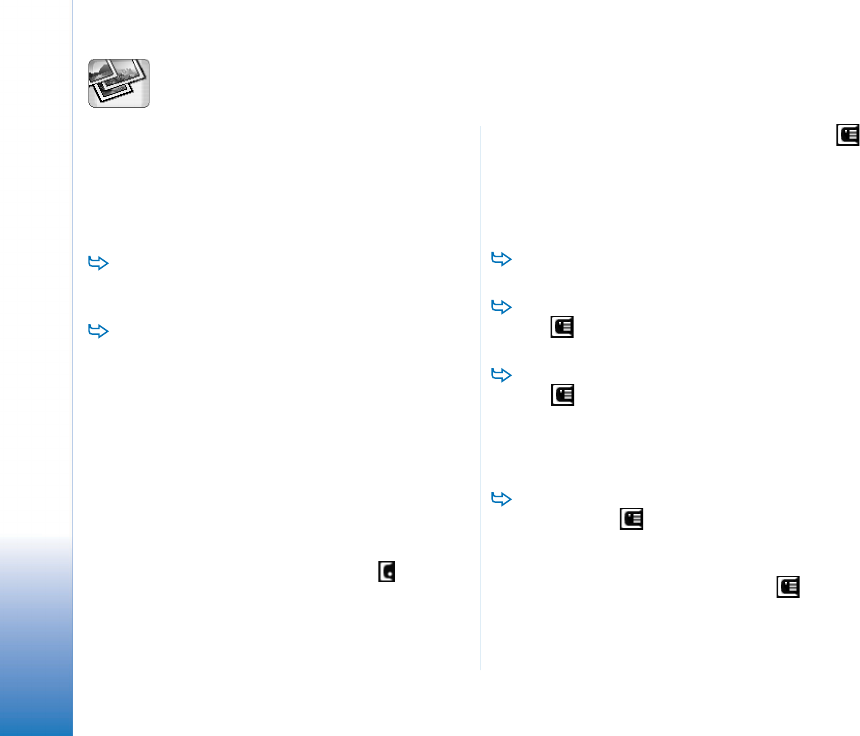
Images
77
FCC DRAFT
Images
Use Images to view and modify images. You can take
pictures with Camera, view and modify them with Images,
and send your images as multimedia messages. You can
also edit pictures taken with the camera, or create new
sketch drawings, which can contain text and geometrical
shapes.
To open the Images application, double-tap Images
in Desk, or tap Go to Images in the Camera
application.
To open the Camera application, tap Go to Camera
in the Images application.
The Images application supports the following file
formats: JPEG, GIF 87a/89a, animated GIF, TIFF/F, PNG,
BMP, and WBMP. The Images application does not
necessarily support all variations of a file format.
The Images application is divided into three different
views, each with different commands:
•In the list view you can copy, move, delete, and send
images stored in your device. You can also create a
new sketch image. The images can be displayed either
as thumbnails or in a file name list. Press to switch
between the thumbnails and the list.
•In the viewer view, which opens when you double-tap
an image in the list view, you can view images.
•In the editor view, which opens when you press
and select Image > Open for editing in the viewer view,
you can modify and transform images.
Viewing images
To open an image for viewing, double-tap it in the list
view. The image opens in viewer view.
To open the next or previous image for viewing,
press , and select Image > Next or Previous, or press
the scroll key on the right or left.
To enlarge the viewed image or make it smaller,
press , and select Display > Zoom ratio. Select the
appropriate zoom level.
Managing images and folders
To view detailed information about an image, select
an image, press and select Tools > Details. The
following information is displayed:
Name: – Name of the image. You can change the default
base name in the Camera application: press and select
Tools> Settings.... Edit the name in the Default image name:
field.
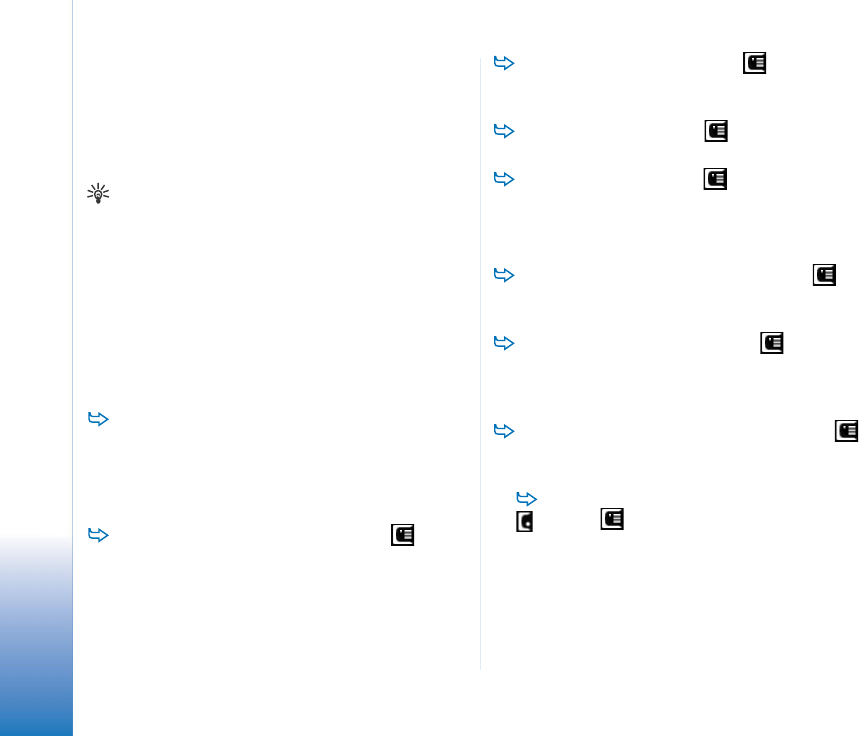
Images
78
FCC
Type: –The format of the image file. If the format is not
supported Unknown is displayed.
Size: – the size of the file in bytes (B).
Date: and Time: – When the image was last modified.
Width: and Height: – The resolution of the image in pixels.
Tip: Resolution is a measure for the sharpness and
clarity of an image. Resolution refers to the number of
dots (pixels) in an image or a display. The more pixels
there are, the more detailed the picture is. Resolution
is usually measured in pixels, for example,
640x480=300 kilopixels (kpix)=0.3 megapixels (Mpix).
Protected: – Indicates if the image is protected by
technical protection means.
Read-only: – If you select this check box, the image cannot
be modified.
To send an image, tap Send, and select the
appropriate sending method.
Copyright protections may prevent some images, ringing
tones, and other content from being copied, modified,
transferred, or forwarded.
To add an image to a contact card, press , select
Tools > Add to contact.... In the view that opens, use the
stylus or the scroll key to select the area of the image
to be inserted. Use the toolbar to zoom, flip, or rotate
the image, or to add a border to it. When you are happy
with the picture, tap Add, and select the contact card
to which the image is added.
To change the file format, press in the editor
view, and select Options > Convert format.... Select a new
file format and other options, if available.
To rename an image, press , and select Image >
Rename.... Write a new name for the image.
To remove an image, press , and select Image >
Delete.
The following commands are only available in the list
view:
To move an image to another folder, press , and
select Edit > Move to folder.... Browse for the target
folder or tap New to create a new one.
To make a copy of an image, press , and select
Edit >Duplicate. Note that you should always make a
copy of the image you are going to edit and edit the
copy to ensure that the original stays intact.
To view the contents of another folder, press ,
and select Image > Change folder.... Browse for the
target folder or tap New to create a new one.
8To view images as lists or as thumbnails, press
, or press , select Display > View > Thumbnail or
List.
See “Common actions in applications” on page 21 for
further information on how to select images, create
folders, and add shortcuts to Desk.

Images
79
FCC
Image settings
To define settings, press , and select Tools >
Settings.... Define the following:
Open images in full screen mode: — If you select this, every
image you open is displayed in full screen mode. To
return to normal view, tap on the screen.
Default sketch name: — Write the name to be used as a basis
for sketch file names. For example, if you write
’Drawing’, the default names of the following sketches
will be Drawing01, Drawing02, Drawing03, and so on,
until you change the setting again.
Special features of some image
formats
To change the page of a multipage TIFF/F image,
press and select Tools > Page > Next/Previous.
Multipage TIFF/F images cannot be edited.
To view animated GIFs, you can let the animation run
in a continuous loop until you close the Images
application or move to a different image. You cannot
edit the image but you can zoom it or view it in full
screen mode.
Editing images
You can edit images that are in JPEG, GIF, BMP, TIFF/F,
PNG, or WBMP format , or create new drawings. Note that
you cannot edit multipage TIFF/F images.
Fig. 24: Editing an image
To edit a copy of an image you are viewing, press
and select Image > Open for editing. For detailed
information on modifying images, see “Drawing tools”
on page 80 and “Transformations” on page 80.
To create a new sketch, press , and select Image
> Create sketch. This command is not available when
viewing an image. Start drawing in the blank area.
Select drawing tools from the toolbar. To save the
sketch, tap Done. Saved sketches are listed in the list
view of the Images application.
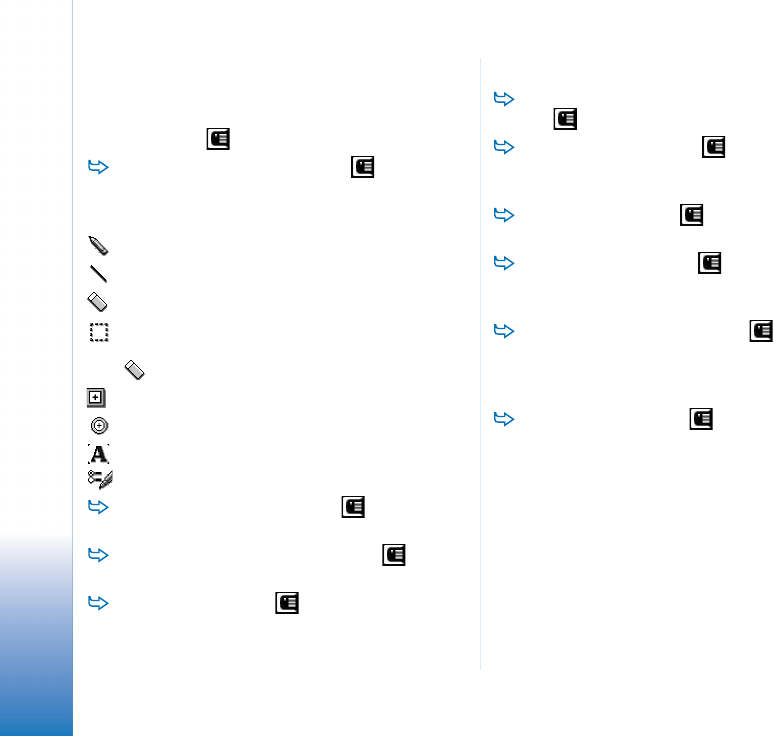
Images
80
FCC
Drawing tools
The toolbar provides shortcuts to the most important
drawing tools. The same tools are also available as menu
commands: press , and select Tools > Sketch tools.
To show or hide the toolbar, press , and select
Display > Toolbar.
Toolbar icons:
— Draw freehand lines.
— Draw straight lines.
— Erase.
— Select an area. All the transformations will affect
only the selected area. To erase a selected area, tap
.
— Draw a rectangle.
— Draw an ellipse or circle.
— Insert text. To format the text, tap Font.
— Select tool line width and colour.
To draw a filled rectangle, press , and select
Tools > Sketch tools > Filled rectangle.
To draw a filled ellipse or circle, press , and
select Tools > Sketch tools > Filled oval.
To undo changes, press , and select Edit > Undo /
Undo all.
Transformations
To make the background of a selection transparent,
press , and select Options > Make transparent.
To rotate the image, press , and select Options >
Rotate > Right or Left. The image will be rotated by 90
degrees in the chosen direction.
To flip the image, press , and select Options > Flip
> Horizontally or Vertically.
To resize the image, press , and select Options >
Resize.... Select one of the sizes available, or select a
custom option to define the size yourself.
To make the canvas bigger, press , and select
Options > Increase image area.... Select the location of
the white space in the new canvas, and define the
amount of enlargement in pixels.
To crop the image, press , and select Options >
Crop. The image is cropped automatically by removing
all the extra white space around the image. If there is
no white space around the image, the command is
disabled.

RealPlayer
81
FCC DRAFT
RealPlayer
Go to Desk > RealPlayer or tap Go to RealPlayer in
Camera (Camcorder mode).
Fig. 25: RealPlayer
With the RealPlayer application you can watch video clips
recorded with the device camcorder or transferred to your
device via compatible PC, Web, e-mail, or memory card.
You can also watch a video stream from the Internet or
listen to audio stream.
When using video streaming and other features that use
the GPRS network, please note that any data transfers
using GPRS are subject to applicable operator data transfer
fees.
RealPlayer supports the following file formats: .RAM, .RM,
.3GP, and .MP4.
RealPlayer does not necessarily support all the variations
of a file format. RealPlayer only opens rtsp links, not http
links.
Playing videos
To start playing a video you have just recorded with
device camcorder, tap Go to RealPlayer in Camera ,
select the video that you have just recorded and tap
Open.
To start playing a video clip, open RealPlayer, select
a file from the list, and tap Open.
Note that low quality video clips may cause unwanted
viewing effects when played on the device.
Tip: You can start watching videos in several ways:
• Double-tap a video file in the File Manager application
or in the list view.
• Double-tap a shortcut to a video file that you have
created in Desk.
• Open a video attachment sent by e-mail or multimedia
message.
• Tap a streaming video link in the web browser.
To stop playing a video, tap .

RealPlayer
82
FCC
To start playing a streaming video, click on a
streaming link in the Web browser or, from the
RealPlayer, open a .RAM file containing the link to
start streaming. Before playing streaming video or
audio, make sure that the settings are correct. For
details, see “RealPlayer settings” on page 112.
Tip: You can also control RealPlayer from the menu.
Press , select Options and an appropriate menu
command.
To adjust the volume, tap and drag the volume bar at
the top right of the screen, or press and on
the scroll key.
To mute the sound, tap the speaker icon next to the
volume bar.
To fast forward or rewind the current video clip, tap
and drag .
To pause a video, tap . Tap again to resume
playback.
Note that if you open the menu while watching a video,
the video is paused.
To watch a video in full screen, tap on the screen. To
return to normal screen size, tap the screen again.
To always open videos in full screen mode, press
, select Tools > Settings..., and select Open clips in full
screen mode.
To save a link to the current streaming video or
audio, press , and select Media clip > Save link....
Managing videos
The list view of RealPlayer shows a list of all saved videos
and streaming links. The name of the folder is shown in the
title area. For example, in this view you can view the
videos in the device, open a video to play, rename a video,
and organise videos into folders.
To move a video to a different folder, press , and
select Edit > Move to folder.... Browse for the target
folder.
To open another folder, press , and select Media
clip > Change folder..., or Recent folders to open one of
the last six folders that you have used.
To delete a selected video from the device, press
, and select Media clip > Delete.
To delete several videos from the device, press ,
and select Edit > Mark/Unmark > Mark. Tap the videos
to be deleted to mark them, press , and select Edit
> Delete.
To sort videos, press , select Display > Sort. You can
sort the files by their name, date, or file size.
To view detailed information on a video, press ,
and select Tools > Details.
To send videos, tap Send, and select the method of
sending.

RealPlayer
83
FCC
Copyright protections may prevent some images, ringing
tones, and other content from being copied, modified,
transferred, or forwarded.
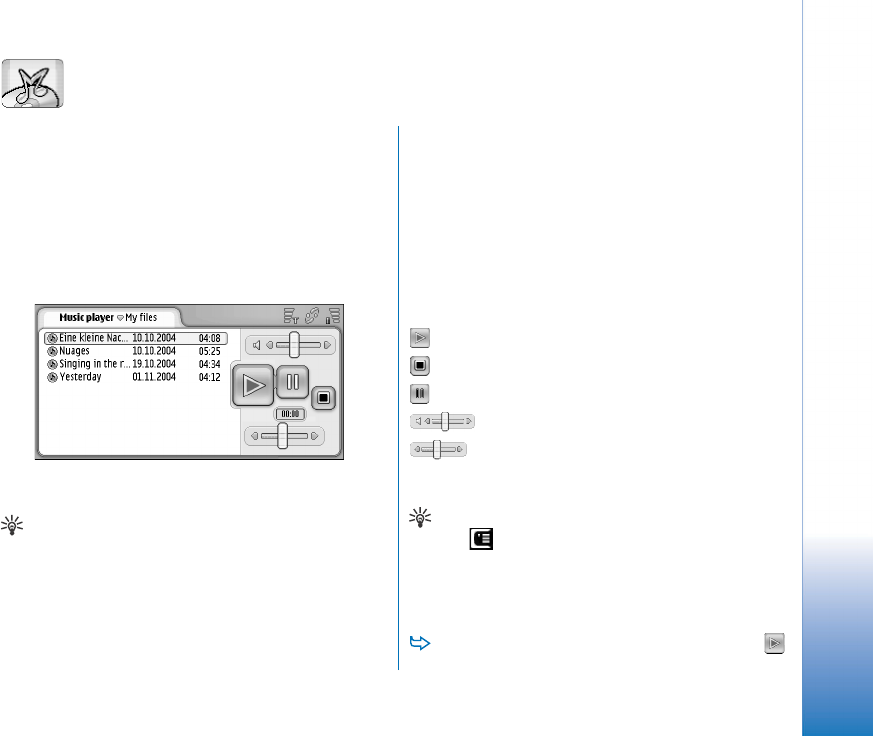
Music player
84
FCC DRAFT
Music player
Go to Desk > Music player.
With the Music player application you can listen to the
music and other audio files stored on your device or
memory card. Music player supports following file formats:
MP3, WAV, MIDI, AAC, AMR, AU, RMF, and M3U. Music
player does not necessarily support all the variations of a
file format.
Fig. 26: Music player
Tip: For information on transferring music tracks from
a compatible PC to the media device, see the PC Suite
Guide on the sales package CDROM.
You can listen to music using the internal loudspeaker or a
compatible headset, and continue listening while using
other applications on your device.
Music is copyright protected in international treaties and
national copyright laws. It may be necessary to obtain
permission or a license to reproduce or copy music. In
some countries national law prohibits private copying of
copyrighted material. Please check the national legislation
of the applicable country concerning the use of such
material.
Music player controls
— Tap to play a selected track.
— Tap to stop playing a track.
— Tap to pause and resume playing a track.
— Tap and drag to adjust volume.
— Tap and drag the slider to find a specific part
of the current track. The time indicator above the slider
changes accordingly.
Tip: You can also control Music player from the menu.
Press , select Options and an appropriate menu
command.
Playing tracks
To play a track, double-tap it, or select it, and tap .

Music player
85
FCC
Tip: You can also open Music player by double-
tapping a compatible sound file in the File manager or
Messaging application, or by opening a shortcut in
Desk.
To play one track after another, press , and
select Options > Play options > Normal. Select a track,
and tap to start playing.
To play tracks in random order, press , and select
Options > Play options > Random.
To play one track at a time, press , and select
Options > Play options > Play selected track. To repeat
the track, press , and select Options > Play options
> Repeat. The track is repeated until you clear the
Repeat menu command. To move to the next track,
press , and select Options > Next track.
To adjust the volume, tap and drag the volume bar at
the top right of the screen, or press and on the
scroll key.
WARNING: Listen to music at a moderate level.
Continuous exposure to high volume may damage
your hearing.
To mute the sound, tap the speaker icon next to the
volume bar.
Managing tracks
To move a track to a different folder, press , and
select Edit > Move to folder.... Browse for the target
folder.
Tip: To select several tracks, tap on a track to select it,
press , and select Edit > Mark/Unmark > Mark. Tap
to mark the rest of the items you want to select.
To add a track shortcut to Desk, press , and select
Tools > Add to Desk....
To delete a track from the device, press , and
select Track > Delete track.
To sort the tracks, press , and select Display > Sort.
You can sort the files by their name, date, or file size.
To view detailed information on a track, press ,
and select Tools > Details.
To send a track, press , and select Track > Send,
and select the method of sending.
Copyright protections may prevent some images, ringing
tones, and other content from being copied, modified,
transferred or forwarded.
To save a track that is an attachment in a
multimedia message, open the attachment in
Messaging, press , and tap Save.
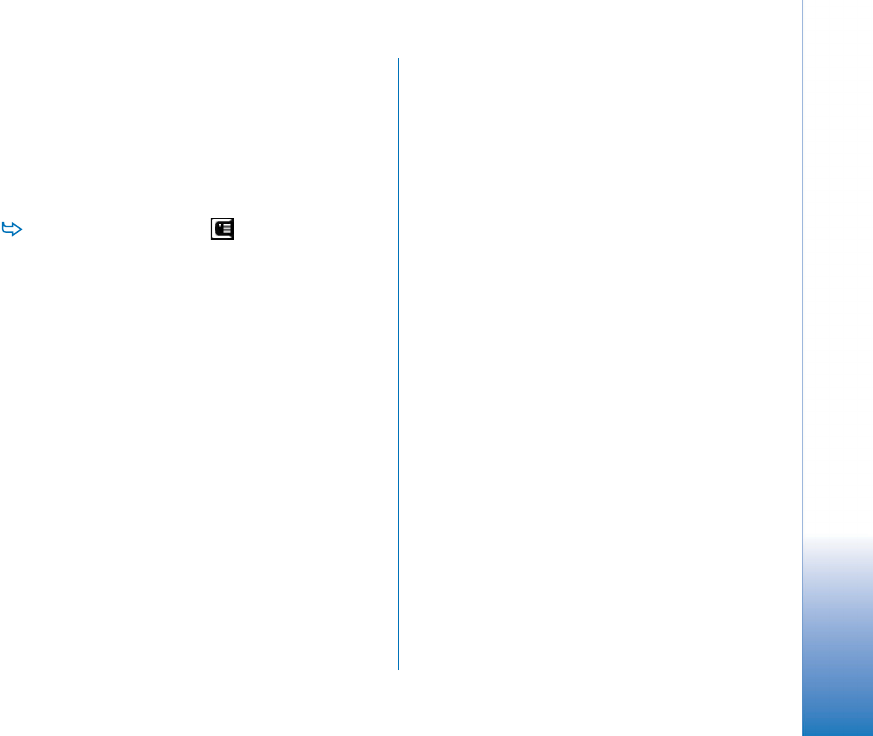
Music player
86
FCC
Track lists
Note that you cannot create new track lists in Music
player, but you can transfer track lists created elsewhere to
your media device. You can use a memory card or
compatible computer to transfer the track lists. For
information on transferring track lists to your device, see
the Nokia PC Suite Guide on the sales package CDROM.
To open a track list , press , and select Track >
Change track list..., or Recent track lists to open one of the
last six track lists that you have used.
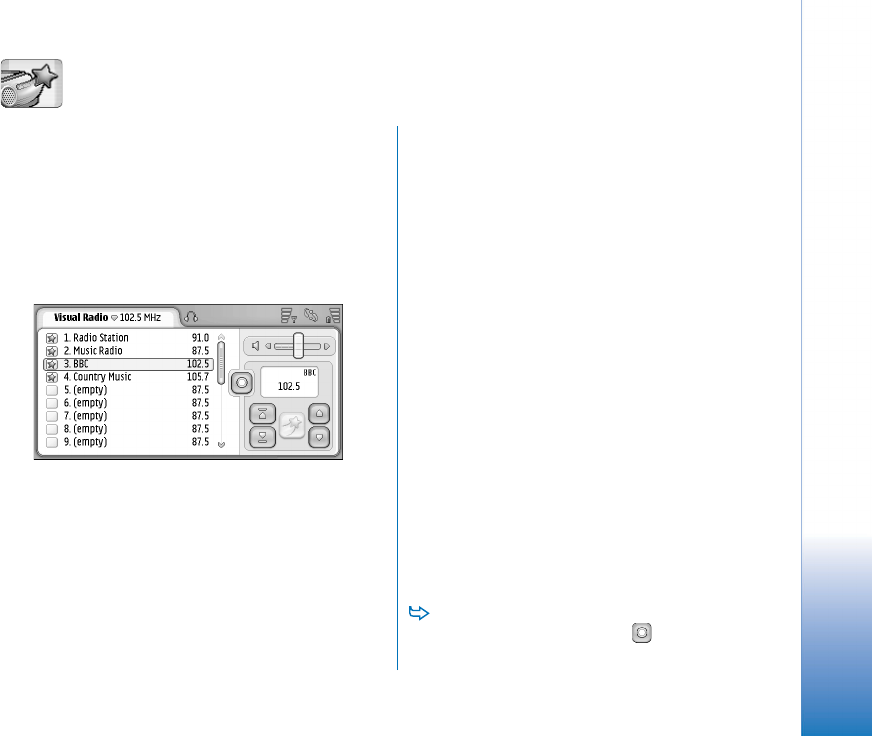
Visual Radio
87
FCC DRAFT
Visual Radio
Go to Desk > Visual Radio.
You can use the Visual RadioTM application as a traditional
FM radio with automatic tuning and preset channels, or
with parallel visual information on the display, if you tune
in to stations that offer Visual Radio service. The Visual
Radio service uses GPRS (network service). You can listen
to the FM radio while using other device applications.
Fig. 27: Visual Radio
To use the Visual Radio service, the following conditions
are required:
• The station you listen to and the network operator
you use must support this service.
• The device must be switched on.
• The device must have a valid SIM card fitted.
• Your Internet access point must be defined for
access to the operator’s visual radio server.
• The preset radio channel must have the correct
Visual Radio service ID defined and have Visual
Radio service enabled. See “Preset channels” on
page 88 for details.
If you do not have access to the Visual Radio service, the
operators and radio stations in your area may not support
Visual Radio. The Visual Radio service may not be available
in all areas and countries.
The radio uses the wire of the headset as an antenna. A
compatible headset needs to be attached to the device for
the radio to function properly.
You can normally make a call or answer an incoming call
while listening to the radio. The radio is turned off when
there is an active call. When the call is finished, you may
need to turn the radio back on manually.
Listening to radio
Note that the quality of the radio broadcast depends on
the coverage of the radio station.
To switch the radio on or off, connect a compatible
headset to the device and tap in Visual Radio.
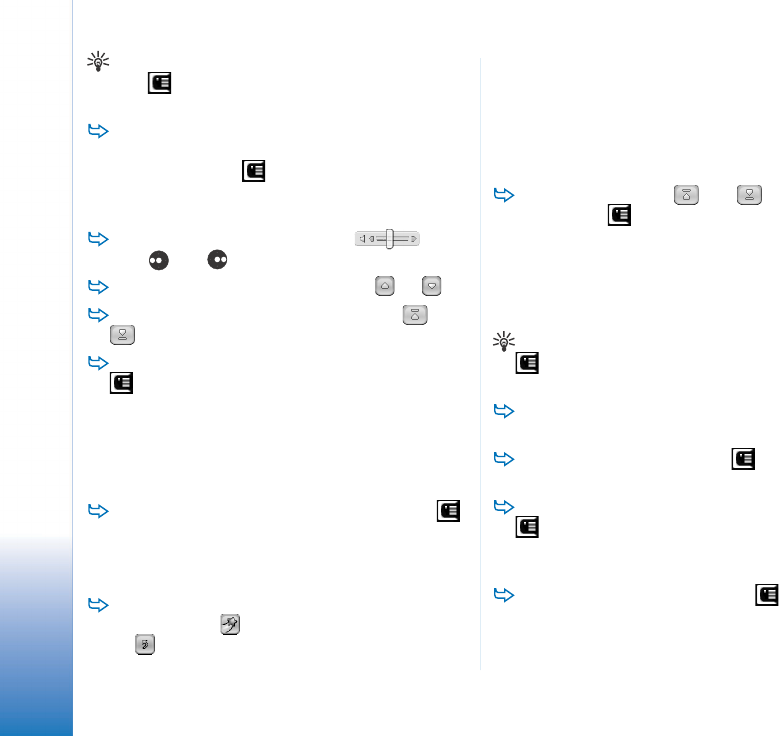
Visual Radio
88
FCC
Tip: You can also control the radio from the menu.
Press , select Radio and an appropriate menu
command.
To listen to the radio through the headset or
loudspeaker, make sure that the headset is connected
to the device, press , and select Tools > Speaker in
use > Headset or Loudspeaker. The lead of the headset
functions as the radio antenna, so let it hang freely.
To adjust the volume, tap and drag , or
press and .
To tune radio channels manually, tap or .
To search for channels automatically, tap or
. Searching stops when a channel is found.
To view available channels based on location, press
, and select Tools > Channel directory.... Select a
location and radio station. Visual Radio tunes to that
station automatically. To save the channel to a list of
preset channels, tap Save. See “Preset channels” on
page 88 for details. To view station details, such as
the visual service ID, tap Details.
To switch to stereo or mono output mode, press
and select Tools > Sound> Stereo or Mono.
Viewing content
To view available visual content, select the preset
channel, and tap . To stop viewing visual content,
tap . Note that you must have the correct visual
service ID defined and have Visual Radio service
enabled. See “Preset channels” below for details.
Preset channels
You can save up to 20 radio channels to Visual Radio.
To save a channel, tap and to tune in to a
station. Press , and select Channel > Save.... Select
a channel slot and write a name for the preset channel.
Change the frequency, if necessary. If the station
provides visual content, add the Visual Radio service
ID, and select the Enable visual service: check box to
allow for visual content.
Tip: To find the visual service ID of a channel, press
, and select Tools > Channel directory.... Select the
radio station, and tap Details.
To listen to a preset channel, tap on a channel in the
list view.
To edit a preset channel, press , and select
Channel > Edit....
To reorder preset channels, select a channel, press
, and select Channel > Reorder.... Select a channel
slot in the list. Press the centre of the scroll key to
confirm the move.
To remove a preset channel, press , and select
Channel > Delete.
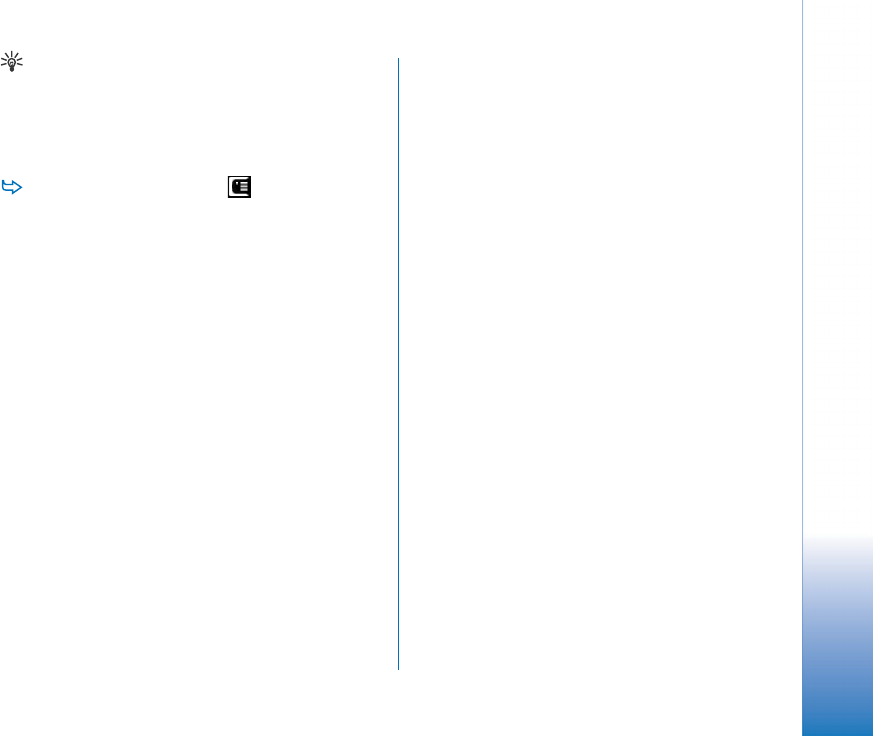
Visual Radio
89
FCC
Tip: When using a compatible headset, press the
headset key to scroll to the next radio channel or next
preset channel, if a preset list is selected.
Visual Radio settings
To modify the settings, press , and select Tools >
Settings.... Define the following:
Auto-start visual service: — When this option is selected, the
Visual Radio service is started automatically when you
tap a preset channel that offers visual service.
Access point: — Select the access point used for a data
connection. For more information, see “Setting up an
Internet access point” on page 107. Note that you do
not need this access point to use Visual Radio as an
ordinary FM radio.

Voice recorder
90
FCC DRAFT
Voice recorder
Go to Desk > Voice recorder.
The Voice recorder application allows you to record voice
memos. You can also listen to your own recordings and
other sound files or insert voice clips to multimedia
messages.
The maximum length of a recording depends on the
memory available.
You can open files that have been stored in the following
file formats: WAV, AMR.
Recording and playing
To start recording, tap . The number display starts
to show the elapsed time. To stop recording, tap .
Tip: Press quickly to start and stop recording.
To play a selected sound clip, tap .
To pause playing a sound clip, tap . Tap again to
resume playback.
To adjust the volume, tap and drag the volume bar at
the top right of the screen, or press and on the
scroll key.
To fast forward or rewind the current sound clip, tap
and drag .
To stop playing, tap .
Tip: You can also control the Voice recorder from the
menu. Press , select Options and an appropriate
menu command.
Managing sound clips
To send a voice clip, press , and select Sound clip
> Send, and select the method of sending.
To sort the sound clip list, press , and select
Display > Sort. You can sort the sound files by their
name, date, or file size.
To rename or delete a selected sound clip, press ,
select Sound clip, and the corresponding command.
To open another folder, press , and select Sound
clip > Change folder....
To add a sound clip shortcut to Desk, press , and
select Tools > Add to Desk....
To view detailed information on a sound clip, press
, and select Tools > Details.

Voice recorder
91
FCC
Voice recorder settings
To edit the Voice recorder settings, press , and
select Tools > Settings.... Define the following:
Clip name: — Write the name to be used as a basis for the
sound clips. For example, if you write “Sound”, the
default names of the following sound clips will be
Sound(01), Sound(02), Sound(03), and so on.
Clip format: — Select the file format in which the sound
clips are saved by default.
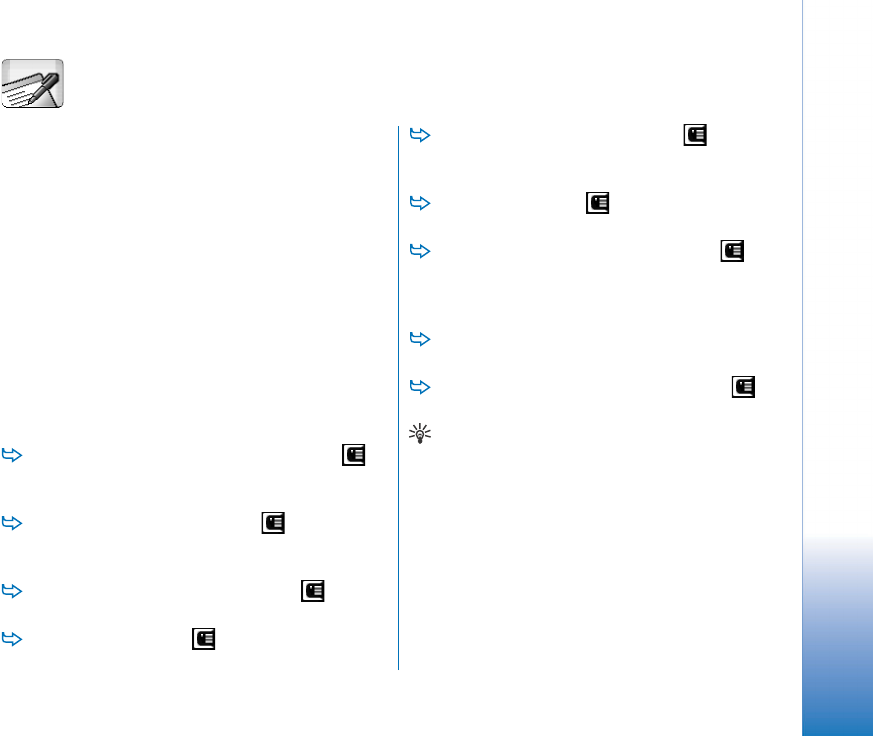
Documents
92
FCC DRAFT
Documents
Go to Desk > Documents.
You can use the Documents application to write new and
edit existing text documents. You can insert and view
images and other files in the documents. You can also send
and receive documents as a short message, MMS, e-mail
attachment, or via Bluetooth technology.
You can open, edit, and save documents created with
Microsoft Word for Windows version 97 or later. Note that
not all features and formatting of the original documents
will be supported. The original document must not be
password-protected. Documents made with other versions
of Microsoft Word may only be viewed.
Working with documents
To create, open or rename a document, press
and select the approriate command in the Document
menu.
To insert special characters, press and select
Insert > Special character.... Select the character or
symbol you want to insert and tap OK.
To insert a date into a document, press and
select Insert > Date....
To undo mistakes, press and select Edit > Undo.
To show or hide text markers, press and select
Tools > Formatting marks.... Select the markers you want
to make visible in the document and tap OK.
To count words, press and select Tools > Word
count....
To protect a document from editing, press in the
list view and select Tools > Details. Select the Read-only:
check box and tap OK. The document can now be
viewed but not edited.
To send a document, tap Send, select the sending
method and tap OK.
To view the structure of a document, press and
select Display > Outline view....
Tip: If you write a phone number, e-mail address, or
web address in a document, you can use it as a
hyperlink. Tap on the number or address, or move the
cursor inside it with the scroll key; it becomes a link
with a small icon. Tap the icon to call the phone
number, to open the e-mail editor, or to access the web
site if you have an active Internet connection.
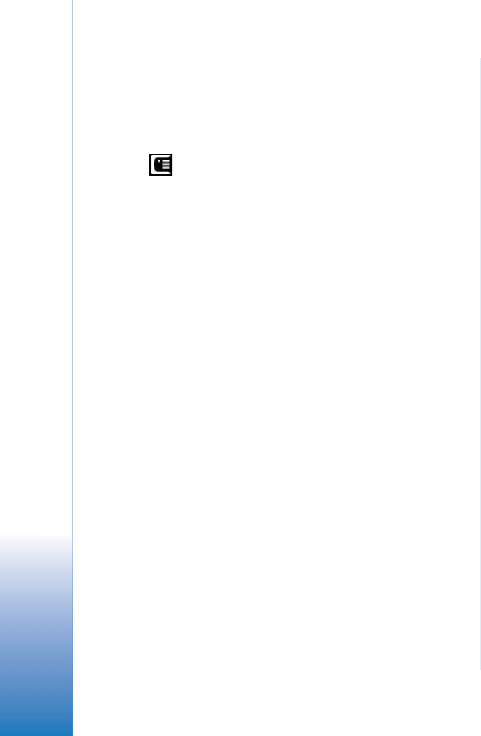
Documents
93
FCC
Editing paragraph styles
Paragraph style is a set of formatting characteristics with
which you can quickly change the appearance of your
text.
1Press and tap Format > Style....
2Select the style you want to edit and tap Edit. Tap
New to create a new style.
3Give the new style a name and select the outline level.
Level 0 means that the text with this style is not
shown in the outline view.
4Tap Format, select what you want to edit, and tap
Format again to start editing. You can change the
following values:
Font – You can change the font type, size and colour.
You can also add bold, italic, underline, and
strikethrough formatting. You can raise or lower the
text by selecting superscript or subscript formatting.
To see the effect of the changes, tap Preview.
Paragraph – You can change the appearance of the
edges of paragraphs by aligning them differently. You
can change the space between lines of text, indent
paragraphs, and add tab stops to set the position of
text on a page.
Borders – You can add a border to any side of a page
and choose a style and colour for it.
Bullets – You can choose from four bullet styles, and
define the size, colour, and indentation of the bullets.
5Tap OK when you have finished editing a style value.
6Tap Close to exit the dialog.

Sheet
94
FCC DRAFT
Sheet
Go to Desk > Sheet.
In the Sheet application you can work and store your data
in a file that is called a workbook. Each workbook contains
at least one worksheet. A workbook can also contain
charts; a chartsheet is a sheet containing a chart that is
based on data from a worksheet.
The Sheet application can open documents created with
Microsoft Excel 97 for Windows or later. Note that not all
features and formatting of the original documents will be
supported. The maximum number of characters in a single
cell is 256, and cells containing more characters will have
the contents truncated when the file format is converted.
Workbooks
To protect a workbook from editing, press in the
list view and select Tools > Details. Select the Read-only:
check box and tap OK. The workbook can now be
viewed but not edited.
To create, open or rename a workbook, press
and select the approriate command in the Workbook
menu.
Working with worksheets
To create a duplicate of a worksheet, tap
Worksheets / Charts. Select the sheet and tap
Duplicate.
To rename a worksheet, tap Worksheets / Charts.
Select the sheet and tap Rename. Write the new name
and tap OK.
To select a cell you have named, press and select
Edit > Mark/Unmark. Select Named area for the range
and choose from the list the cell you want, then tap OK.
To keep rows visible when scrolling, select the row
below the area that you want to remain visible. To keep
columns visible, select the column to the right of the
area that you want to remain visible. Then tap on the
toolbar, or press and select Display > Freeze panes.
To go to a particular cell or named area, tap Go To.
Specify the cell or named area where you want to go
and tap OK.
Tip: You can insert a sum for a range of cells
automatically by using the toolbar icon . Select the
cell where you want to add the sum and tap . The
suggested formula is shown in the formula field on top
of the worksheet. You can change the suggested
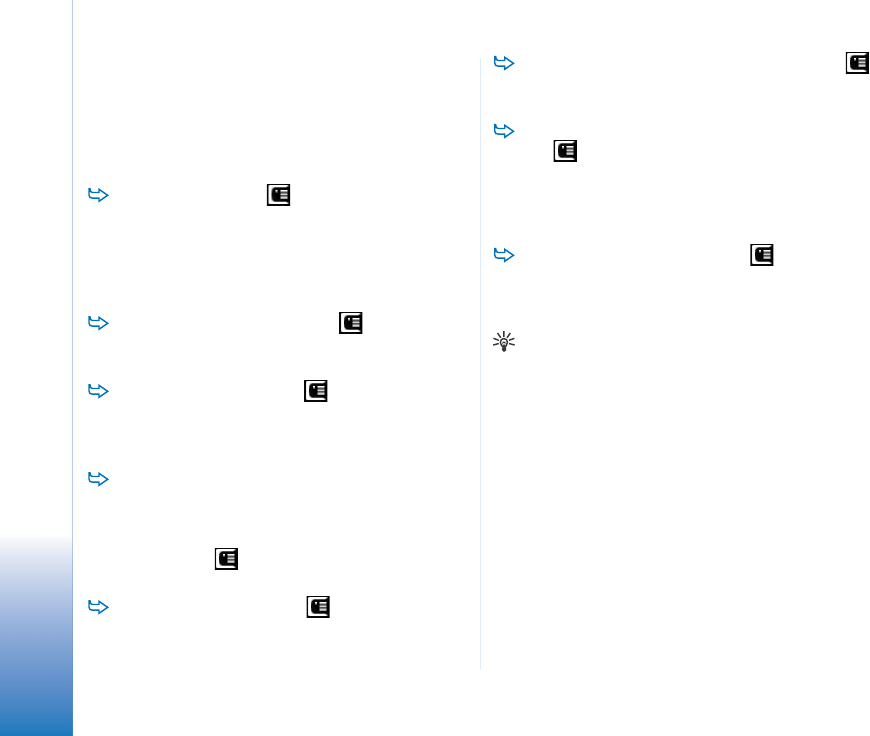
Sheet
95
FCC
formula by editing it in the formula field, or accept it
by exiting the cell.
Formatting worksheets
First select the cell or cells you want to format.
To format fonts, press and select Format > Font.
You can change the font type, size, and colour. You can
also add bold, italic, underline, and strikethrough
formatting. You can raise or lower the text by selecting
superscript or subscript formatting. To see the effect of
the changes, tap Preview.
To change number format, press and select
Format > Numbers. For example, you can specify how
the date, time, or currency is displayed.
To align cell contents, press and select Format >
Alignment. If you select Wrap text to cell:, the row height
of the selected cell will be adjusted to display the
entire content of the cell.
To adjust the row height or column width, drag the
boundary below the row heading or on the right side
of the column heading until the row/column is the size
you want. To specify the height or width more
precisely, press and select Format > Row height or
Column width. Specify the height or width and tap OK.
To format cell borders, press and select Format >
Borders. You can add a border to any side of a cell.
Choose a style and colour for the border and tap OK.
To change the background colour of a cell, press
and select Format > Background colour. Choose a colour
and tap OK.
To show or hide gridlines, zero values, and headers,
press and select Tools > Settings. Select the items
you want to make visible in the worksheet and tap OK.
Chartsheets
To format a chart in detail, press and select
Format. Select the object you want to edit. The
selection of settings varies depending on the type of
the chart.
Tip: You can access some of the setting dialogs by
tapping the relevant item in the chart. For example, the
X-axis settings dialog opens when you double-tap the
X-axis in the chart.
Font – You can change the font type, size and colour. You
can also add bold, italic, underline, and strikethrough
formatting. You can raise or lower the text by selecting
superscript or subscript formatting. To see the effect of the
changes, tap Preview.
Chart – You can select the chart type, make the chart
three-dimensional, and change the colour of the
background and axis. You can also change the title shown
in the chart, and the title of the X- and Y-axis.
X-axis – You can select the label type and write the data
range for it, display or hide the axis line, and add tick

Sheet
96
FCC
marks. You can also enter the category number where the
other axis crosses, and change the number of minor tick
marks per category.
Y-axis – You can define whether the values are shown in
the chart or not, specify the highest and lowest value
displayed, and determine the location where the axes
cross. You can also use the logarithmic scale, change the
interval at which major tick marks appear, and change the
number format.
Legend – You can add a box where the colours used in a
chart are explained, and specify the position of the box.
Gridlines – You can select whether the major and minor
axes have gridlines.
Series – You can add new data series to a chart or edit the
existing series. You can define whether the series is shown
in the chart or not, change the data range of the series,
select the label type and enter the data range for it. You
can also specify the colour with which to display the series
on the chart. Note that pie charts can have only one data
series.
To create a duplicate of a chartsheet, tap
Worksheets / Charts. Select the chart and tap
Duplicate.
To rename a chartsheet, tap Worksheets / Charts.
Select the chart and tap Rename. Write the new name
and tap OK.
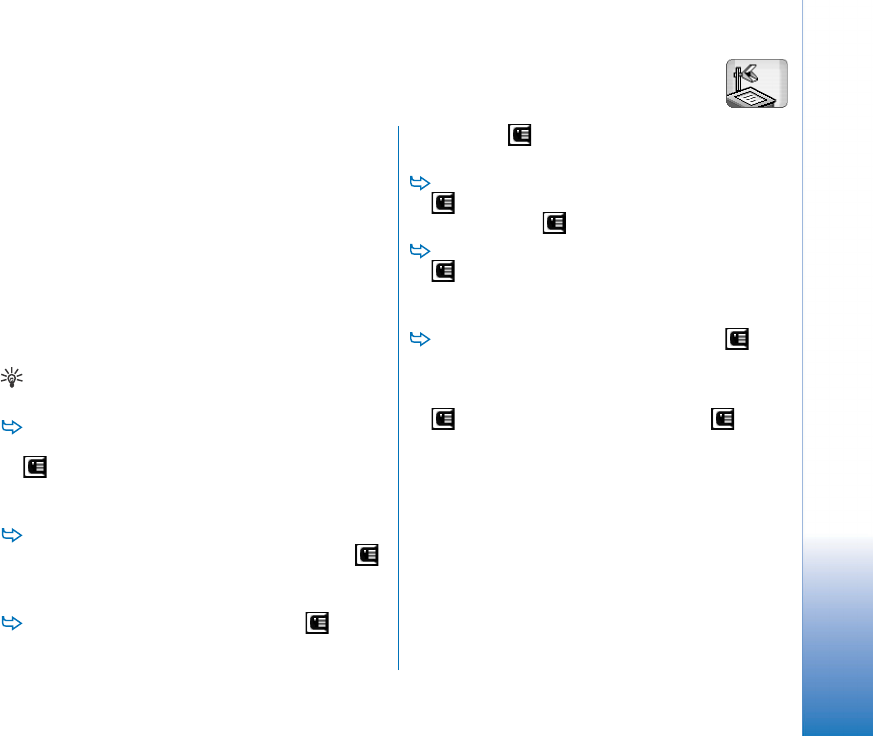
Presentations
97
FCC DRAFT
Presentations
Go to Desk > Presentations.
You can open and view presentations created with
Microsoft PowerPoint 97 or later. Note that not all
features and formatting of the original documents will be
supported. You can send and receive these presentations
via e-mail or Bluetooth technology.
The list view shows a list of all presentations in the
selected folder. The name of the folder is shown in the title
area. In this view you can manage presentations without
opening the actual files. For example, using the menu bar
commands you can move or copy presentations.
Tip: For more information on available commands, see
“Common actions in applications” on page 21.
To open a presentation, double-tap the presentation
in the list. If the file is located in another folder, press
and select Presentation > Change folder.... Select the
folder where the presentation is saved. Note that you
can have only one presentation open at a time.
To move between slides, use the Next and Previous
buttons. To move directly to a specific slide, press
and select Presentation > Go to slide. Select the slide
from the list and tap OK.
To view slides in full screen mode, press and
select Display > Full screen. To return to the standard
view, press and select Display, then clear the Full
screen option.
To view additional notes in a presentation, press
and select View > Notes. To return to the standard
slide view, press and select View > Slide.
To get an overview of the whole presentation, press
and select View > Outline. To open a selected slide
in the standard slide view, tap Slide view or double-
tap the title of the slide.
To copy text from the current slide, press and
select Edit > Copy text. The text is copied to the
clipboard. In the Notes view the content of the notes is
copied, too. To copy all text in a presentation, press
and select View > Outline. Then press again
and select Edit > Copy all text. All the text on the slides
and notes is copied to the clipboard. To copy all the
text on the slides, select Copy all slide text, and to copy
all the text in the notes, select Copy all note text. Note
that some of the formatting may be lost.

Clock
98
FCC DRAFT
Clock
Go to Desk > Clock.
To set the current date and time, tap Date and time.
Select the Auto-update of date & time: check box if you
want the network to update the date and time
automatically to your device. Note that this is a
network service. Otherwise, tap and tap the
arrows to change the time. Tap to set the date.
To use daylight saving time, select the Apply daylight-
saving: check box.
See also “Regional settings” on page 113.
To change between an analogue and digital clock
type, tap the face of the clock.
To display only the home city in the Time view, press
and select Display. Clear the option Destination
city.
To switch between the Time and Alarm view, press
and select View > Alarm or Time.
Fig. 28: Clock
Alarms
To set an alarm, tap Set alarm. Write the text that is
displayed when the alarm goes off. Tap , then tap
and to set the alarm time. Tap OK. Define how
often the alarm repeats, and tap OK.
If the alarm time is reached while the device is switched
off, the device switches itself on and starts sounding the
alarm tone.
To turn off and remove a sounding alarm, tap Stop.
If the device was switched off when the alarm sounded,
it asks whether you want to activate the device. Press
Cancel to switch off the device or Switch on to switch
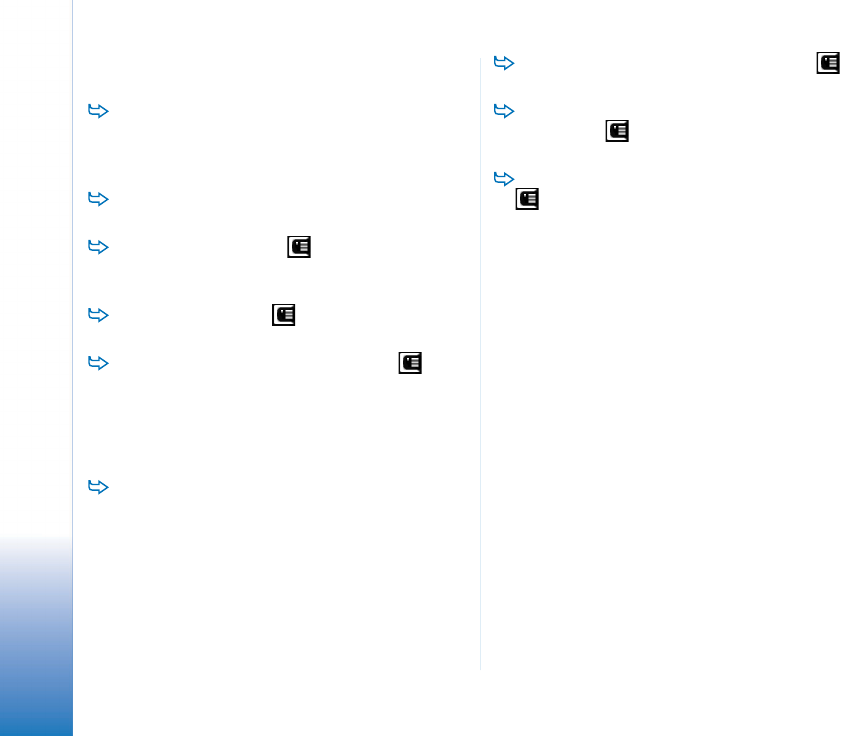
Clock
99
FCC
it on. Do not press Switch on when wireless phone use
may cause interference or danger.
To snooze a sounding alarm for ten minutes, tap
Snooze. If the device was switched off when the alarm
sounded, it will switch itself off again and back on
after 10 minutes.
To mute a sounding alarm, tap Mute. The alarm is
silenced, but the notification remains on the screen.
To delete an alarm, press and tap View > Alarm.
Select the alarm you want to remove and tap Remove
alarm.
To edit an alarm, press and tap View > Alarm.
Double-tap the alarm you want to edit.
To deactivate or activate an alarm, press and
tap View > Alarm. Select the alarm you want to
deactivate or activate and tap Activate/ Deactivate.
Cities and countries
To change cities in the Time view, select the left
frame to change the current city or the right frame to
change the destination city. Tap Change city, drag the
scroll bar to browse the list, or enter the name of the
city in the search box below the list. The list changes
to show possible matches as you enter more
characters in the search field. Select the city and tap
OK. If the city is not included on the list, tap New city
to add it to the list.
To add a new city, country, or region, press and
select City or Country/Region > New....
To edit the currently selected city, country, or
region, press and select City or Country/Region >
Edit....
To copy the dialling code of a selected city, press
and tap Tools> Copy dialling code.
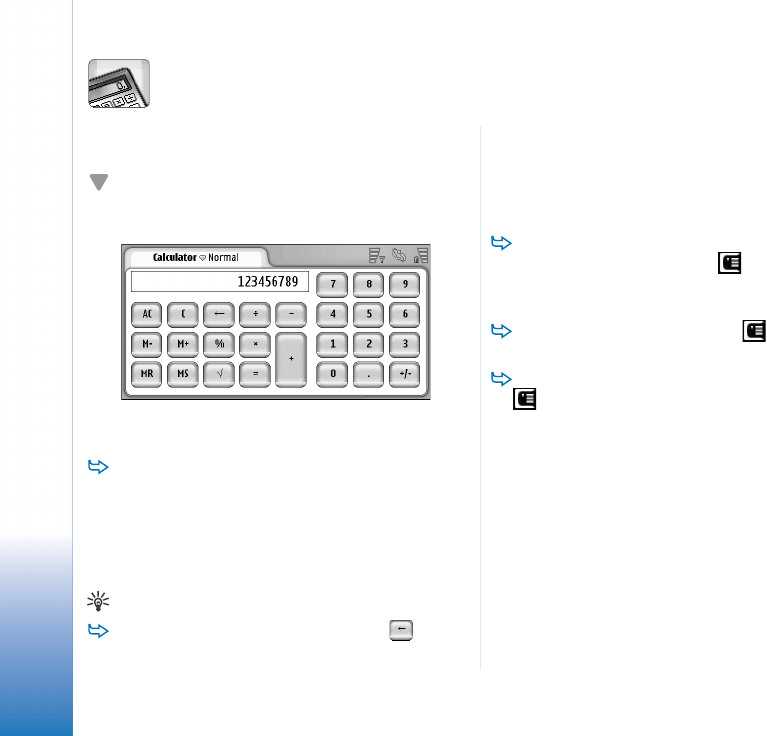
Calculator
100
FCC DRAFT
Calculator
This device has a calculator application for basic
calculations.
Note: This calculator has limited accuracy and is
designed for simple calculations.
Fig. 29: Calculator
To perform calculations, tap the buttons on the
display.
The calculator performs operations in the order in which
they are written, despite the hierarchical difference
between operator types. You cannot use parentheses to
change the performance order of operations.
Tip: To use the percentage symbol, x% equals x/100.
To delete numbers in the input field, tap .
You cannot remove an entered operation symbol from the
input field. If you enter two operator symbols in sequence,
the latter one replaces the former symbol. Otherwise you
can use backspace to remove the last value character in
the input field when editing a calculation.
To switch between the normal calculator view and
till roll calculator view, press and select View>
Normal or Till roll. The till roll calculator shows all
previous input.
To clear the entire till roll, press and select Edit
> Clear till roll.
To flip the position of buttons and input field, press
and select Display > Flip layout.
Using calculator memory
It is possible to store one number value at a time in the
memory of the calculator and then recall it, and add or
substract a value to/from this value in the memory. When
any number value besides zero (0) is saved in the memory,
the letter M appears at the upper left side of the input
field. If zero (0) is saved, it means the same as clearing the
memory.
These are the memory commands:
MR — Recalls the value in memory to the input field.

Calculator
101
FCC
M+ — Adds the value in the input field to the value in the
memory.
M- — Subtracts the value in the input field from the value
in the memory.
MS — Saves the current value in memory.
Constant function
The constant function can be used to store temporarily a
value that is added, subtracted, multiplied, or divided
constantly.
To use a constant, enter the value you want to use as
a constant and tap on an operator symbol twice. The
letter K is displayed in the calculation line when the
constant value has been stored. Enter a new value and
tap on the equals symbol (=) to perform the
calculation.
For example: Enter the value 2 in the calculator. Tap
twice on the plus symbol (+). The constant value 2 is
saved. Enter the value 5 and tap on the equals symbol
(=). The sum (7) is displayed. Enter the value 10.2 and
tap =. The sum (12.2) is displayed.
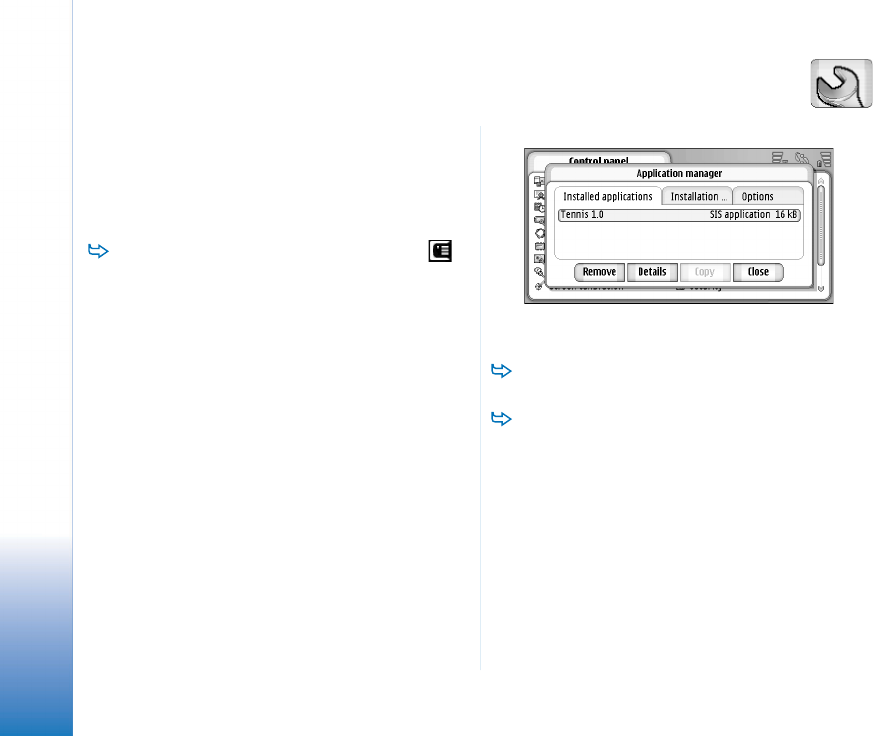
Control panel
102
FCC DRAFT
Control panel
Go to Desk > Control panel.
In Control panel you can define and modify various
settings of your device. Modifying these settings affects
the operation of your media device across several
applications.
To restore the original factory settings, press ,
and select Restore original settings. Tap Restore to
confirm.
Application manager
Go to Desk > Control panel > App. manager.
With the App. manager application you can view the
details of installed applications or remove them from your
device. You can also specify installation settings.
You cannot install applications in Application manager.
For information about installing software, see “Installing
software” on page 27.
When you open Application manager, the Installed
applications page lists all of the software packages that
have been installed, with their name, version number,
type, and size.
Fig. 30 Application Manager
To display the details of an installed software
package, tap Details.
To remove an installed software package from your
device, select the software package you want to
remove and tap Remove. A dialog appears asking for
your confirmation. Press Remove.
Some software packages update existing software and
after the installation you may only be able to remove the
whole software package, not the update.
If you remove software, you can only reinstall it by having
the original software package file, or by restoring a full
back-up that contains the removed software package. If
you remove a software package, you may no longer be able
to open documents created with that software. If another

Control panel
103
FCC
software package depends on the software package that
you removed, the other software package may stop
working. Refer to the documentation of the installed
software package for details.
To view the list of software installations and
removals that have taken place, go to the Installation
log page. This list shows what software has been
installed and removed, and when that happened. If you
encounter problems with the device after installing a
software package, you can use this list to find out
which software package may be the cause of the
problem. The information on this list may also help to
pinpoint problems that are caused by software
packages that are incompatible with each other.
To configure installation settings, go to the Options
page. Here you can select options related to software
installation. Define the following:
Delete files after installation: - If selected, the software
package installation file will be deleted from the
device after installation. If you download software
packages using the web browser, this may be helpful
in reducing the amount of storage space required. If
you want to store the software package file for
possible reinstallation later on, either set this option to
No, or make sure that you have a copy of the software
package file stored on a compatible PC or on a CDROM.
Enable online certificate check: - If selected, the certificate
of the software package installation file will be
checked before installation. For more information on
certificates, see “Certificate manager” on page 103.
Web address for cert. check: - Define the URL adress of the
server checking the certificate.
Default installation language: - If the software package
contains several different language versions of the
software, the language version specified here will be
installed.
Software installation: - Define what kind of SIS installations
are allowed. Select On to allow all installations, Signed
only to only allow installations of SIS files with valid
signature or certificate, or Off to prohibit all SIS
installations.
Bluetooth
Go to Desk > Control panel > Bluetooth.
See “Bluetooth connection” on page 122.
Certificate manager
Go to Desk > Control panel > Certificate manager.
With the Certificate manager application you can manage
digital certificates which you use when connecting to web
sites, mail servers, and when installing software. Digital
certificates may be used for:
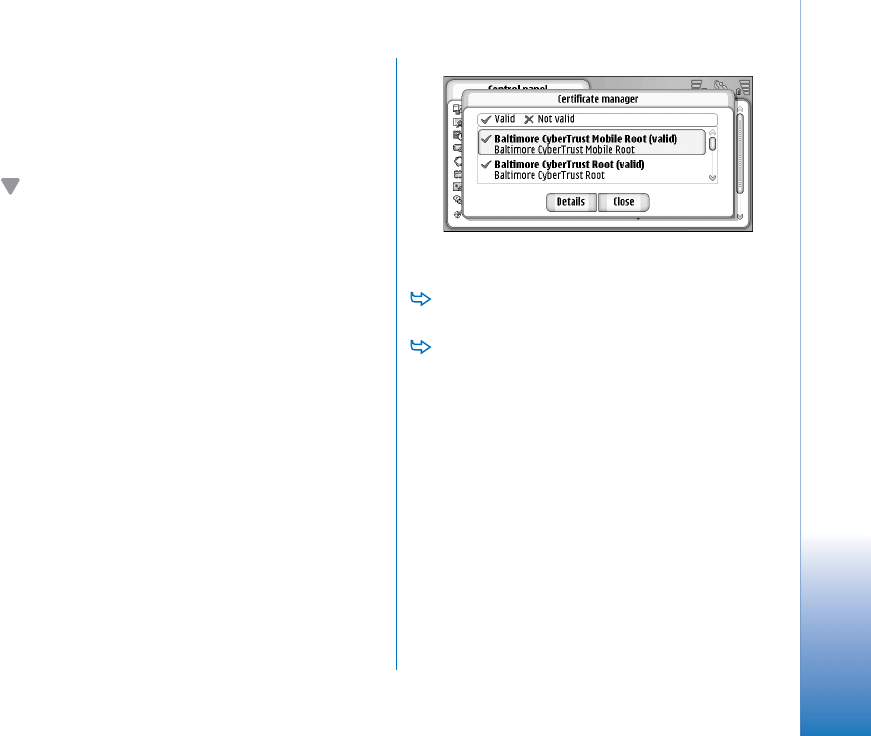
Control panel
104
FCC
• connecting to an online bank or another site or remote
server for actions that involve transferring confidential
information
• reducing the risk of viruses or other malicious software
and checking the authenticity of software when
downloading and installing it
Important: Note that even if the use of certificates
makes the risks involved in remote connections and
software installation considerably smaller, they must be
used correctly in order to benefit from increased security.
The existence of a certificate does not offer any protection
by itself, the certificate manager must contain correct,
authentic, or trusted certificates for increased security to
be available. Certificates have a restricted lifetime. If
“Expired certificate” or “Certificate not valid yet” is shown
even if the certificate should be valid, check that the
current date and time in your device are correct.
Before changing any certificate settings, you must make
sure that you really trust the owner of the certificate and
that the certificate really belongs to the listed owner.
Fig. 31: Certificate manager
To view certificate details, double-tap a certificate.
To delete a certificate, tap Delete.
To define the usage of the certificate, double-tap a
certificate and tap Trust settings. Define the
following:
SIS installation: — Select this check box, if you want this
certificate to be able to certify the origin of a new SIS
software.
Application installation: - Select this check box, if you want
this certificate to be able to certify the origin of a new
java software.
Web and e-mail: — Select this check box, if you want this
certificate to be able to certify web sites and mail-
servers.
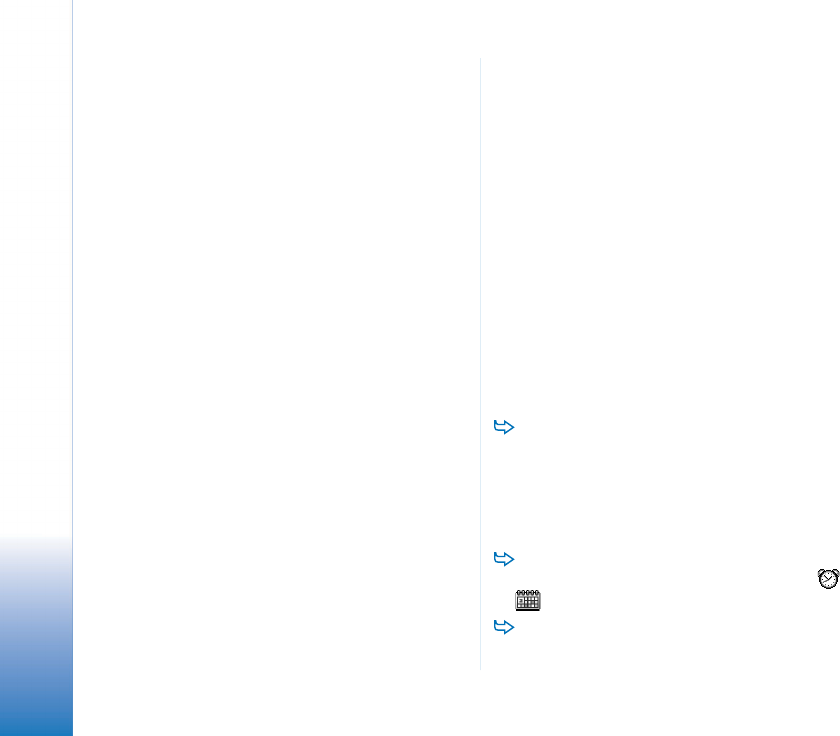
Control panel
105
FCC
Checking the authenticity of a
certificate
1Select the certificate and tap Details. A view of
certificate details opens.
2The Issued to: field identifies the owner of this
certificate. Make sure that this is the name of the
party to whom you think that this certificate belongs.
3Scroll the dialog until you see the Fingerprint: field,
which uniquely identifies the certificate. Contact the
help desk or customer service of the owner of the
certificate (see step 2 above) and ask for the MD5
fingerprint of the certificate. Compare the fingerprint
with the one shown in the dialog. If they match, the
certificate should be authentic.
Use this authentication procedure each time you add a
new certificate.
Data call barring
Go to Desk > Control panel > Data call barring.
You can prevent or allow the following data call types:
All incoming calls: — When activated, data calls cannot be
received.
Incoming calls when abroad: — When activated, data calls
cannot be received when you are outside your home
country.
All outgoing calls: — When activated, data calls cannot be
made.
International calls: — When activated, data calls cannot be
made to other countries or regions.
International calls except to home country: — If you have
enabled international roaming with your network
operator, you cannot make international data calls abroad,
except to your home country.
The options available are:
Activate — Turns on the barring.
Cancel — Turns off the barring.
Check status — Checks whether data call barring is
activated or not.
To modify these settings, you need the barring password
from your service provider.
To cancel all data call barrings, tap Cancel all
barrings.
Date and time
Go to Desk > Control panel > Date and time.
To set the current time and date, write the time and
date directly into the respective fields, or tap and
. Tap the small arrows to change the time and date.
To let the network automatically update the time
and date in your device, select Auto-update of date &

Control panel
106
FCC
time:. This is a network service. Note that this may
cause some alarms to expire, if the alarm has been set
between the old and the updated time.
To use daylight saving time, select Apply daylight-
saving:.
Display
Go to Desk > Control panel > Display.
Fig. 32: Display
To change the brightness of the display, tap <+> or
<->.
To define how soon the display brightness will go
down to save power if the screen is left untouched,
select the appropriate brightness period.
Tip: Selecting a low brightness level and a short time
period saves the battery and increases the operation
time of the device.
To define how soon a screen saver starts if the
screen is left untouched, select the appropriate time
limit for the Screen saver time-out: option. Note that
you cannot change the look of the screen saver.
To set an automatic touch screen and keypad lock
on, select the Screen saver locks display & keys: check
box. The touch screen and keypad are locked
automatically when the screen saver is activated. For
more information, see “Touch screen and keypad lock”
on page 25.
Enhancements
Go to Desk > Control panel > Enhancements.
Here you can define some of the settings of the headset
and loopset used with the device.
To modify the enhancement properties, tap Edit and
define the following:
Default profile: — Choose the profile that will be activated,
when you attach a headset or loopset to your device.
Automatic answer: — Define whether you want the device
to answer an incoming call automatically after five
seconds time when a headset or loopset is attached to
the device.
Internet setup
Go to Desk > Control panel > Internet setup.

Control panel
107
FCC
To connect to the Internet:
• the wireless network you use must support data calls
or GPRS
• the data service must be activated for your SIM card
• you must have obtained an Internet access point from
your Internet service provider (ISP)
• you must have configured the proper Internet settings
Setting up an Internet access point
Some Internet service providers may offer you the
possibility to configure your Internet access point settings
by sending you a message. This might reduce the number
of settings you need to enter yourself, or eliminate the
need altogether. For more information , see “Plug and play
mobile services” on page 68.
The exact values for the settings are usually provided by
your service provider. Follow the instructions given to you
by your service provider very carefully.
Note that any data transfers via GPRS are subject to
applicable operator data transfer fees.
To set up Internet access point, tap New access pt..
To edit an existing Internet access point, tap Access
pts.. Define the following fields on the pages of the
Internet setup wizard:
Connection name: — Give a descriptive name for the
connection.
Data bearer: — Choose the data connection type. For more
information on data connection types, see “Data
connections” on page 29.
Depending on which data connection you select, only
certain setting fields will be available on the following
pages of the wizard.
Network type: (for GPRS only) — Choose which version of
the Internet protocol you want to use.
Auto-retrieve access point: (for GPRS only) — If your network
operator supports this feature, the access point name
can be retrieved automatically from the network. The
access point is needed to establish a connection to the
GPRS network.
Access point name: (for GPRS only) — If you do not use the
Auto-retrieve access point: , define a name for the access
point. You can obtain the access point name from your
network operator or service provider.
Dial-up number: (for GSM data and high-speed data only)
— The modem telephone number of the access point.
Prompt password at every login: — Select this if you must
write a new password every time you log onto a server,
or if you do not want to save your password to the
media device.
User name:— Write a user name if required by the service
provider. The user name may be needed to make a data
connection, and is usually provided by the service
provider. The user name is often case-sensitive.

Control panel
108
FCC
Password: — A password may be needed to make a data
connection, and is usually provided by the service
provider. The password is often case-sensitive.
After defining these settings, tap Advanced to define
advanced settings, if necessary.
You may have to set up several Internet connections,
depending on the sites you want to access. For example,
browsing the Internet may require one setup, whereas
browsing your company’s intranet may require another
connection.
The Messaging application also uses the Internet access
point to send and receive e-mail and multimedia
messages. See “Messaging” on page 45.
Advanced Internet settings
When you have finished setting up or editing Internet
access settings in the Internet setup wizard (Control panel
> Internet setup > New access pt.), you can continue by
configuring advanced settings. The pages and options
available depend on whether you have chosen a packet
data (GPRS) or GSM high-speed connection.
Data call page
Call type: – Define the GSM data call type. The options are
Normal and High speed data (GSM only).
To be able to use High speed data (GSM only), the network
service provider must support this feature, and if
necessary, activate it for your SIM card.
Modem type: – Analogue, ISDN V.110, or ISDN V.120 defines
whether the media device uses an analogue or digital
connection. This setting depends on both your GSM
network operator and Internet service provider, because
some GSM networks do not support certain types of ISDN
connections. For details, contact your Internet service
provider. If ISDN connections are available, they establish
connections more quickly than analog methods.
Maximum data speed: – This option allows you to limit the
maximum connection speed when high-speed data is
used. Higher data rates may cost more, depending on the
network service provider.
The speed represents the maximum speed at which your
connection will operate. During the connection, the
operating speed may be less, depending on network
conditions.
Modem initialisation: – You can control your media device
using modem AT commands. If required, enter characters
specified by your GSM network service provider or
Internet service provider.
Proxies page
You may want to use a proxy to quicken access to the
Internet. Note also that some Internet service providers
require the use of web proxies. Contact your Internet
service provider to determine proxy details.
If you have made an Internet connection to your
company’s intranet, and are unable to retrieve web pages
from the general Internet, you may need to setup a proxy

Control panel
109
FCC
server to retrieve web pages outside your company’s
intranet.
Protocol: – Select the protocol type of the proxy. You can
set different proxy settings for each protocol.
Use proxy: – To use the proxy server, select this option.
Proxy server address: – The IP address of the proxy server, or
the domain name. Example domain names are:
company.com and organisation.org.
Port number: – The number of the proxy port. The port
number is related to the protocol. Common values are
8000 and 8080, but vary with every proxy server.
Do not use proxy for: – Define here the domains for which
the HTTP or HTTPS proxy is not needed.
IP addresses page
Note that the two protocols (IPv4 and IPv6) require
slightly different settings.
Auto-retrieve IP address: – If you select this, the IP address
is obtained automatically from the server. This setting is
also called ‘dynamic IP address’.
IP address: – The IP address of the media device. If the IP
address is obtained automatically, then you are not
required to enter details here.
DNS address: – If you select the option Auto-retrieve for the
IPv4 protocol, the DNS (Domain Name Server) address is
obtained automatically from the server. The respective
value for the IPv6 protocol is Use well-known. DNS is an
Internet service that translates domain names such as
www.nokia.com into IPv4 addresses like 192.100.124.195,
or IPv6 addresses like 3ffe:2650:a640:1c2:341:c39:14.
Primary DNS address: – The IP address of the primary DNS
server. If the IP address is obtained automatically, then
you are not required to enter details here.
Secondary DNS address: – The IP address of the secondary
DNS server.
Login scripts page
Use login script: – If you select this, you can write or import
a login script in plain text format. You can edit the script
in the field at the bottom of the screen.
Display post-dial terminal: – If you select this, the terminal
window is shown on the screen when a data connection is
being established.
Tip: Your Internet service provider may be able to
provide you with a script.
Tip: Scripts are not usually required when you
establish a connection. To find out if you need a script,
contact your Internet service provider.
Other page
Allow plain text login: – If you select this option, the
password at connection may be sent as plain text. For
optimum security, clear this option. Some Internet service
providers require that this option is selected.

Control panel
110
FCC
Use PPP compression: – Selecting this speeds up the data
transfer, if it is supported by the remote PPP server. If you
have problems with establishing a connection, try not
selecting this check box. Contact your Internet service
provider for guidance.
Callback type: – Ask your Internet service provider for the
correct setting to use. The setting depends on the service
provider’s configuration.
Callback number: – Type in your device’s data phone number
which the dial back server uses. Usually, this number is the
data call phone number of your device.
Internet connection settings
To configure Internet connection settings, define the
following fields:
General
Preferred access point: — Choose the access point to connect
to the Internet.
Ask before connecting: — If you select this, a dialog appears
every time you connect to the Internet, asking you to
confirm the connection or to change the access point.
Data call
Disconnect when idle for: — Select the time period after
which the data call is ended automatically if the
connection is not used.
Some Internet connections may appear inactive, but they
may still be sending and receiving data in the background.
These connections may delay the start of the inactivity
period specified here, and therefore postpone the closing
of the connection.
The data call settings affect all access points using a data
call and high-speed data call. For more information on
data connections, see “Data connections” on page 29.
GPRS
Disconnect when idle for: — Select the time period after
which the GPRS connection is set to standby mode, if the
connection is not used.
GPRS connection: — Select When available to keep the GPRS
connection in alert mode and to switch the packet data
transfer on quickly when needed. If you select When
needed, the media device will use a GPRS connection only
if you start an application or action that needs it. Note
that if there is no GPRS coverage and you have chosen the
When available option, the media device will periodically
try to establish a GPRS connection.
The GPRS settings affect all access points using a GPRS
connection.
Memory
Go to Desk > Control panel > Memory.

Control panel
111
FCC
Here you can view the amount of free memory and the
memory consumption of different items on your media
device and memory card.
Tip: To avoid device memory getting low, you should
regularly delete or transfer data to a memory card or
PC.
For more information, see “Memory management” on
page 24.
Pen input settings
Go to Desk > Control panel > Pen input settings.
See “Pen input settings” on page 35.
Positioning settings
Go to Desk > Control panel > Positioning settings.
Some networks allow others to request the position of
your device (network service). You can only use this
service and settings if you install applications that
support this service.
Define the following:
Priority
On the priority page you can define the priority of
different positioning methods
To change the priority of a location method, tap
and select the method you want to place in that position.
Details
On the Details page, you can view a method properties and
modify its cost.
You can view the following properties:
Method: — Select the appropriate positioning method.
Average positioning time: — The average time that the
positioning process takes.
Rate: — The estimated cost rate of the method.
Battery use: — The estimated power consumption of the
method.
Accuracy: — Horizontal accuracy of the method.
To modify the cost of a method, tap Edit and tap
to select a method.
Privacy settings
Go to Desk > Control panel > Privacy settings.
General page
The settings on this page override all individual settings.
Define the following:

Control panel
112
FCC
Position request rule: — Define the global privacy setting.
Select Use individual request rules to use the settings that
you define for each contact and service on the Individual
page. Select Confirm first to be prompted for the
acceptance of all location requests regardless of the
setting on the Individual page. SelectAlways acceptor
Always reject to accept or reject location requests
regardless of the settings on the Individual page.
Valid until: — Define the time limit for the acceptance or
rejection, if defined. When the time limit has been reached,
the privacy level switches to Use individual request rules.
Notify when position sent: — Define the global notification
setting. This option is only available, if you have set the
verification policy to Always accept.
Individual page
On the Individual page, you can define the privacy settings
for a specific contact or service.
The page consists of a list of contacts and services that
have specific privacy settings. When a contact or service
has requested a location, it may be added to the privacy
list. You can only add contacts to the list within this dialog.
To add a contact, tap Add, tap a contact in the list and
tap Close. Define the individual privacy settings. The
options are similar to ones defined on the Global page. Tap
Close to proceed.
To edit a contact, tap Edit, and modify the individual
privacy settings. The options are similar to ones defined
on the Global page. Tap Close to proceed.
For more information on selecting contacts, see “Viewing
and searching for contacts” on page 60.
RealPlayer settings
Go to Desk > Control panel > RealPlayer settings.
Define the following:
Network
Data speed::— Select the connection speed. Note that the
options Very fast and Slow may affect the video quality.
Connection time-out: — Select the time period in seconds
after which the connection closes, if the connection is not
successful.
Server time-out: — If the server is not able to send enough
data and a lot of buffering takes place, you may need to
define a server time-out.
Port range: — The range of port numbers used for the
connection. The default values are the same as those for
Internet settings.
Default access point: — The connection that you want to
use as a default connection. The default value is the same
as that for Internet settings.

Control panel
113
FCC
Proxy
Use proxy: — To use the proxy server, select this option.
Server address: — The IP address of the server, or the
domain name. Example domain names are: company.com
and organisation.org.
Port number: — The number of the proxy port. The port
number is related to the protocol. The default port is
1091.
Regional settings
Go to Desk > Control panel > Regional settings.
On the following pages you can define the format for the
local time, date, numbering, and currency expressions.
Time
Time format: — Choose the 24-hour or 12-hour clock
system.
Am/pm format: — If you chose 12-hour clock in the
previous field, choose the location and appearance of the
indicators.
Separator: — Select the separator used between hours and
minutes.
Date
Date format: — Choose the order of date items.
Separator: — Choose the separator used between date
items.
Week starts on: — Choose the first day of the week.
Working days: — Select the working days of the week.
Numbers
Decimal separator: — Choose the sign used as decimal point.
Thousands separation: — Select this check box if you want
to use separation between thousands and hundreds.
Thousands separator: — Choose the thousands separator.
Measurement unit: — Choose the local length measurement
unit.
Currency
Currency symbol: — Enter the symbol used for local
currency.
Decimal places: — Tap - or + to choose the amount of
decimal places used in currency numbers.
Symbol position: — Choose the position of the currency
symbol in relation to the number.
Negative value format: — Choose the way that a negative
currency value is displayed.

Control panel
114
FCC
Security
Go to Desk > Control panel > Security.
Here you can define the phone security level of your
device.
Codes are shown as asterisks. If you are changing a code,
you will be prompted for the current code and then the
new code twice. For more information on access codes, see
“Access codes” on page 24.
Avoid using codes that are similar to emergency numbers,
such as 112, to prevent accidental dialling of the
emergency number.
Device lock
Autolock period: — You can set an autolock period, a time-
out after which the media device is automatically locked
and can be used only if the correct lock code is entered.
Note: When the device is locked, calls still may be
possible to the official emergency number programmed
into your device.
Lock code: — The lock code must be from five to ten digits
long. The factory setting for the lock code is 12345. To
avoid unauthorised use of your media device, change the
lock code. Keep the new code secret and in a safe place
separate from your device.
Lock if SIM card changed: — You can set the media device to
ask for the lock code when an unknown, new SIM card is
inserted into your device. The media device maintains a
list of SIM cards that are recognised as the owner’s cards.
PIN codes
PIN code request: — When active, the code is requested
each time the media device is switched on. Deactivating
the PIN code request may not be allowed by some SIM
cards. If you enter the PIN code incorrectly three times in
succession, you will need a PUK (PIN Unblocking Key)
code to unblock the SIM card. When the SIM card is
blocked, you can only make calls to preprogrammed
emergency numbers. Otherwise, you cannot use the
device before you enter the appropriate codes.
Note that this setting cannot be changed, if the phone is
switched off or if there is no valid SIM card inserted. Note
also that some SIM cards do not allow you to turn the PIN
code request off.
Confirm SIM services: (network service) — To set the media
device to display confirmation messages when you are
using a SIM card service.
PIN code: — The PIN code must be from 4 to 8 digits long.
PIN2 code: —The PIN2 code must be from 4 to 8 digits long.
The PIN2 code is required to access some functions, such
as the call cost settings, which must be supported by your
SIM card. If you enter an incorrect PIN2 code three times
in succession, you will need a PUK2 code to unblock the
PIN2 code. The new PIN2 code must be from 4 to 8 digits
long.

Control panel
115
FCC
Call barring
Barring password: — Tap Change to change the barring
password. The barring password must be four digits long.
If you enter an incorrect password three times in
succession, the password is blocked and you must ask the
network service provider for a new password.
Screen calibration
Go to Desk > Control panel > Screen calibration.
If the touch sensitive area of the screen responds
inaccurately, it may need calibration. Follow the
instructions on the screen.
Themes
Go to Desk > Control panel > Themes.
Themes are special files that contain formatting
information, images, and sounds. With themes you can
change the look and sound of your media device. The
default themes cannot be deleted.
To change the look or sound of your media device,
tap Themes. Select a theme from the list and tap
Apply. To preview a selected theme, tap Test, then
Preview. Tap Sounds to listen to the sounds of the
theme, if available.
Device language
Go to Desk > Control panel > Device language.
To change the language of your media device, tap
Device language:. Changing the language also affects
some regional settings, such as currency symbols and
measurement units.
Service commands
Go to Desk > Control panel > Service commands.
You can send service requests, such as activation
commands for network services to your service provider.
For more information, contact your service provider.
To send a request, write it in the field, and tap Send.

File manager
116
FCC DRAFT
File manager
Go to Desk > File manager.
In the File manager application you can move, copy,
rename and open files and folders.
Copyright protections may prevent some images, ringing
tones, and other content from being copied, modified,
transferred, or forwarded.
Tip: Use the File manager application together with a
memory card to remove files and folders from the
internal memory and in that way free memory. See
“Managing memory cards” on page 117.
Fig. 33: File manager
To open a file or folder, double-tap it.
To reopen a recently opened file, press and select
File > Recent files. Select the file you want to open.
To view the details of a file or folder, press and
select Tools > Details. If you select the Read-only: check
box, the file cannot be modified.
Managing files
To find a file, tap Find. Enter the name or part of the
name of the file that you are looking for. You can also
search according to file types. To make the search more
accurate, tap Options and define the search location
and the date interval of searched files. Tap Find to start
the search.
To create a new file, press and select File > New
file.... Define the type of file and the location where the
new file is saved.
To change the sorting order of the files, press
and select Display > Sort.... Select both the category
according to which to sort the files, and the sorting
order.
Managing folders
To close a folder and move up in the folder
hierarchy, tap Up one level.

File manager
117
FCC
To create a new folder, press and select File >
New folder.... Give the new folder a name and select a
location.
To rename a selected file or a folder, press and
select File > Rename....
Managing memory cards
To change from internal drive to memory card, press
and select Browse > Memory > Memory card.
To rename a memory card, press and select
Memory card > Rename....
To format a memory card, press and select
Memory card > Format. All memory card data will be
permanently deleted! Tap Format to proceed with the
formatting.
To back up information to a memory card, press
, select Tools > Backup/Restore... and tap Backup.
Select, whether you want to back up all data or only
specified file types. Tap OK to start copying. It is
advisable to take back-ups of your media device data
regularly.
To restore information from a memory card, press
, select Tools > Backup/Restore... and tap Restore.
For more information on memory cards, see “Removing
and installing the memory card” on page 15.
Note also that you with PC Suite you can back up data
to your PC. For more information on the back-up options
available with Nokia PC Suite, see the PC Suite guide on
the CDROM.
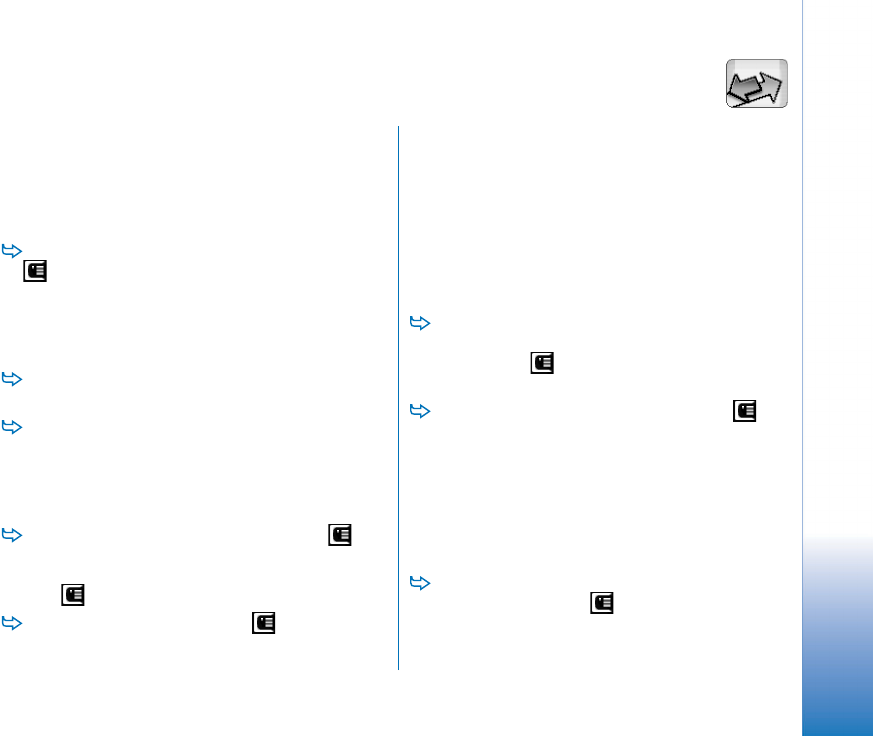
Log
118
FCC DRAFT
Log
Go to Desk > Log.
With the Log application you can monitor phone calls,
messages, and data connections registered by the media
device. You can filter the log to view just one type of event
and create contact cards based on the log information.
To select the type of events you want to view, press
and select View group > All communication / Voice
calls / Messages / GPRS connections / Data calls. Note that
certain events, such as a text message sent in more
than one part and GPRS connections, are logged as one
communication event.
To sort the event list, tap Sort and select the order in
which you want to sort the list.
To view details of an event, select the log event and
tap Details. For example, you can see the sender or
recipient name, phone number, name of the service
provider, or access point. To copy the phone number
displayed in a log event, tap Copy number.
To clear the contents of the entire log, press and
select Edit > Clear log. The recent calls list is also cleared.
To clear a single event from the log, select the event,
press and select Edit > Delete communication detail.
To specify the log duration, press and select Tools
> Log duration.... Tap the <+> and <-> to set the number
of days. The log events remain in the device memory for
a set number of days after which they are
automatically erased to free memory. Note that if you
select zero (0) for the value, logging is disabled and all
the log contents, Recent calls register, and Messaging
delivery reports are permanently deleted. Note also
that the maximum number of registered log events is
300, after which the events are deleted, starting from
the oldest events.
To call a phone number displayed in the log, select
the log event and tap Call. To send a message to the
number, press and select Options > Create text
message....
To add the phone number to contacts, press and
select Options > Add to Contacts....
Recent calls
In the Recent calls dialog you can view dialled, received
and missed calls. You can also select a phone number and
call that number or add it to Contacts.
To monitor the phone numbers of dialled, received,
and missed calls, press and select Options >
Recent calls. The media device registers missed and
received calls only if the network supports these
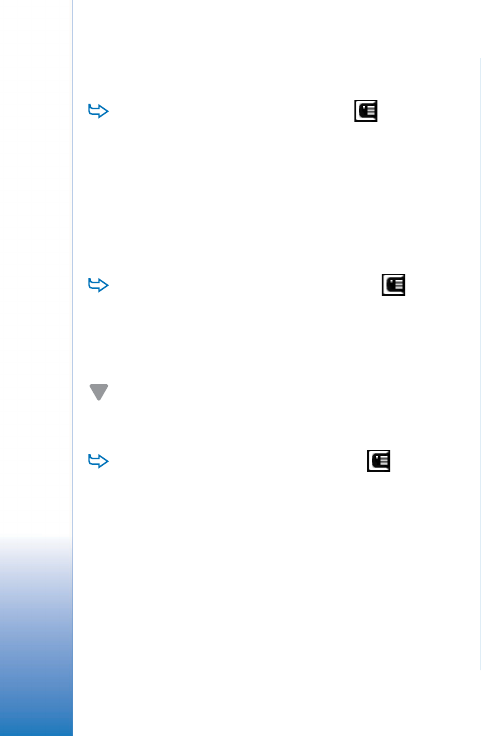
Log
119
FCC
functions, and the device is switched on and within
the network’s service area.
To erase the recent calls list, press in the main
view of Log and select Edit > Clear log. The content of
both the recent calls list and the entire event log is
cleared.
Call duration and GPRS data
counter
To monitor the duration of calls, press and
select Tools > Call duration. The list shows the
approximate duration of your incoming and outgoing
calls. To clear the call duration timers, tap Clear
timers. For this you need the lock code.
Note: The actual time invoiced for calls by your
service provider may vary, depending on network
features, rounding off for billing, and so forth.
To view the GPRS data counter, press and select
Tools > GPRS data counter. The list shows the amount of
data sent and received during packet data (GPRS)
connections. For example, you may be charged for your
GPRS connections by the amount of data sent and
received. To clear the GPRS data counters, tap Clear
counters. For this you need the lock code.
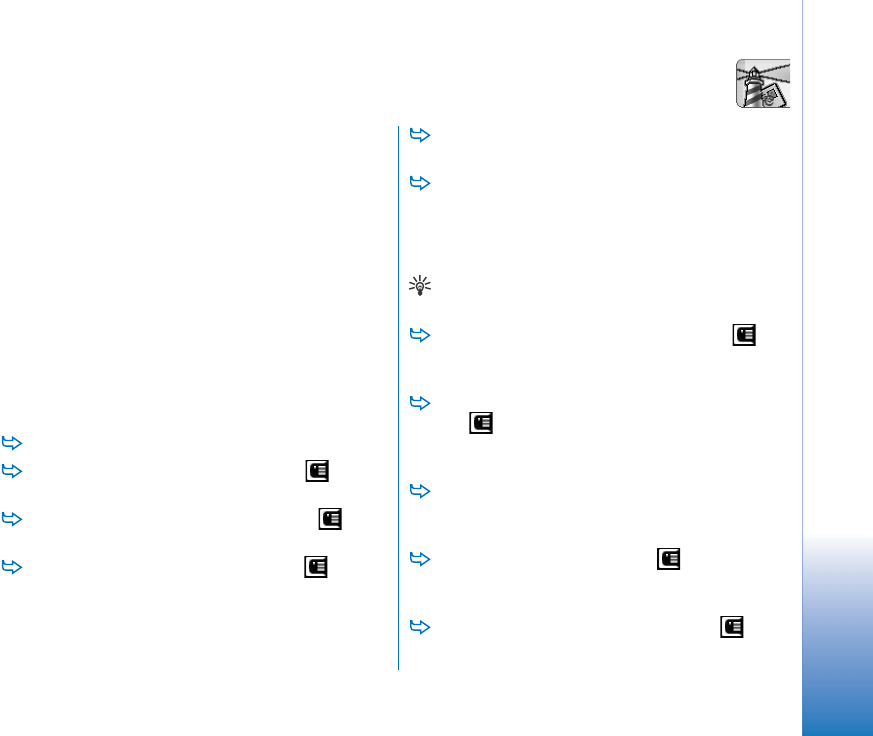
Cell broadcast
120
FCC DRAFT
Cell broadcast
Go to Desk > Cell broadcast.
In areas where Cell Broadcast Service (CBS) is available,
you can receive messages on various topics such as, for
example, weather or traffic conditions, from your service
provider. For available topics and relevant topic numbers,
contact your service provider.
Cell broadcast is a network service. Check with your service
provider to see whether CBS is available.
Note that a packet data (GPRS) connection may prevent
cell broadcast reception. Contact your network operator
for the correct GPRS settings.
Reading and managing messages
To read a message, tap Read.
To save a message you are reading, press and
select Edit > Save message.
To delete a message you are reading, press and
select Edit > Delete message.
To lock a message you are reading, press and
select Edit > Lock message. You can lock a message to
make sure that it won’t be deleted, if new messages of
the same topic are received.
To go to the next or previous message, tap Next or
Previous.
To start or stop receiving CBS messages, tap
Reception on or Reception off.
Managing topics
Tip: You can search for different topics. Enter a topic
name in the search field.
To be notified of a specific new topic, press and
select Topic > Hotmark. The hot topic is marked with an
exclamation mark “!”.
To edit or remove topics when the reception is off,
press and select Topic > More options > Edit topic...
or Delete topic(s). Note that you cannot edit topics in
the All list view.
To subscribe, scroll to a topic and press Subscribe. A
check mark is displayed in the box on the left-hand
side of the topic. To unsubscribe, tap Unsubscribe.
To create a new topic list, press and select Lists
> Manage lists.... Tap New and enter a name for the new
list.
To change the name of a topic list, press and
select Lists > Manage lists.... Select the list you want to
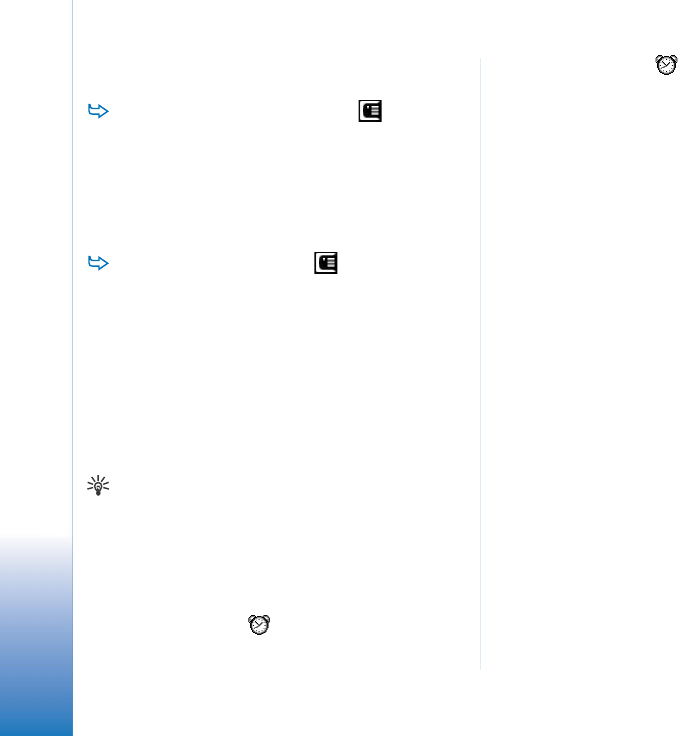
Cell broadcast
121
FCC
rename and tap Rename. Note that the reception must
be turned off.
To open a different topic list, press , select Lists
and select the topic list you want to open.
In different topic lists, you can still subscribe to and
unsubscribe from topics and set them as hot topics.
Cell broadcast settings
To modify the settings, press and select Tools >
Settings.... Define the following:
Add new topics to list: - If you select this option, all new
topics are added automatically to your current list of
topics. If you do not select this option, you will receive
only the messages concerning subscribed or hot topics
that you already have in your topic list.
Language: - Select the language of the topics you want to
receive. Select All to receive topic messages in all
languages.
Tip: Create a new empty topic list, select the Add new
topics to list: option and all languages in the setting
above to receive a complete list of topics available in
that area.
Reception on: - Select this to allow for automatic
reception.
Reception on' time: - Tap to define the time when
automatic reception starts.
Reception off' time: - Tap to define the time when
automatic reception ends.
Message deletion interval (hours): - Define how often all the
read messages are removed.

Connectivity
122
FCC DRAFT
Connectivity
Bluetooth connection
Go to Desk > Control panel > Bluetooth.
This device is compliant with Bluetooth Specification 1.1,
which supports the following profiles: Serial Port Profile,
Dial-Up Networking Profile, Object Push profile, File
Transfer Profile, and Handsfree Profile. To ensure
interoperability between other devices supporting
Bluetooth technology, use Nokia-approved enhancements
for this model. Check with the manufacturers of other
devices to determine their compatibility with this device.
Bluetooth technology enables wireless connections for
sending images, texts, business cards, calendar notes, or to
connect wirelessly to compatible devices with Bluetooth
wireless technology, for example, computers.
Since devices with Bluetooth technology communicate
using radio waves, your media device and the other device
do not need to be in direct line-of-sight. The two devices
only need to be within a maximum of 10 metres of each
other, although the connection can be subject to
interference from obstructions such as walls or from other
electronic devices.
There may be restrictions on using Bluetooth technology in
some locations. Check with your local authorities or service
provider.
Features using Bluetooth technology, or allowing such
features to run in the background while using other
features, increase the demand on battery power and
reduce the battery’s life.
Activating Bluetooth application for
the first time
1Open the Control panel application and select
Bluetooth.
2Give a Bluetooth name to your device. Write a name
(max. 82 characters) or use the default name. If you
send data via Bluetooth before you have given an
individual Bluetooth name to your device, the default
name will be used.
3Select the Switch Bluetooth on: check box to enable
Bluetooth. If you clear the check box, all active
Bluetooth connections are ended, and Bluetooth
cannot be used for sending or receiving data.
4Select the Visible to all: check box so that your media
device and the name you chose for it can be seen by
other Bluetooth device users. If you clear the check
box, your device cannot be found by other devices
during the device search.
5Tap OK to save the settings and close the dialog.
To deactivate the Bluetooth application, tap on
the status indicator area and select Switch off.

Connectivity
123
FCC
Bluetooth cannot be used for sending or receiving data
until you select the Switch Bluetooth on: check box
again. Note that a Bluetooth connection is normally
disconnected automatically after sending or receiving
data. Only with some accessories like headsets the
connection may be maintained even if it is not actively
used.
Sending data via Bluetooth
You can only send data to one device at a time.
1Open an application where the item you wish to send
is stored. For example, to send a photo to another
device, open the Images application.
2Select the item you want to send and tap Send, or
press and look for the Send > Via Bluetooth
command.
3If you have searched for Bluetooth devices earlier, a
list of the devices that were found previously is shown
first. You can see a device icon and the device’s
Bluetooth name.
4To start a new search, tap New search.
5Select the device you want to connect with and tap
Send.
6If the other device requires pairing before data can be
transmitted, you are asked to enter a passcode. Create
your own passcode (1-16 characters long, numeric)
and agree with the owner of the other Bluetooth
device to use the same code. This passcode is used only
once and you do not have to memorise it. Devices that
do not have a user interface have a factory-set
passcode. When the connection has been successfully
established, the note Sending is shown.
Data received via Bluetooth can be found in the Inbox
folder in Messaging. For more information, see “Folders”
on page 46.
Note that if sending fails, the message or data will be
deleted. The Drafts folder in Messaging does not store
messages sent via Bluetooth.
Receiving data via Bluetooth
To be able to receive data via Bluetooth, make sure you
have set Bluetooth as active and selected the Visible to all:
check box in the Bluetooth dialog.
When you receive data via Bluetooth from a device that is
not authorised, you are first asked if you want to accept
the Bluetooth message. If you accept, the item is placed in
the Inbox folder in the Messaging application.
Paired devices
Pairing means authentication. Pairing with a device makes
device searches quicker and easier.
The users of the Bluetooth-enabled devices should agree
together what the passcode is, and use the same passcode
for both devices in order to pair them.
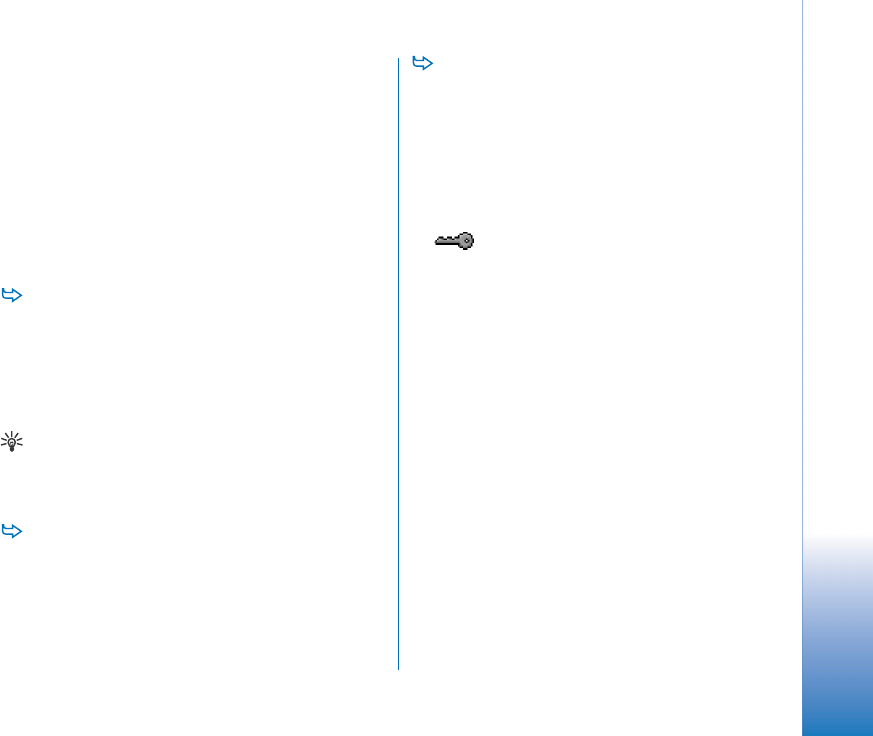
Connectivity
124
FCC
Pairing with a device
1Open the Control panel application and select
Bluetooth. You can also pair devices before transmitting
data.
2Tap Paired devices. Paired devices are shown in the list.
3Tap Search to open the Search for devices dialog. If you
have searched for Bluetooth devices earlier, a list of the
devices that were found previously is shown first.
4Tap Start to update the found devices list, if necessary,
select the device you want to pair with, and tap Pair.
5Write the passcode and tap OK.
To assign short names for paired devices, open the
Control panel application, select Bluetooth, then tap
Paired devices. Select the device whose name you
want to change and tap Edit. You can define a short
name (nickname, alias) to help you recognise a certain
device. This name is stored in the device memory and
cannot be seen by other Bluetooth device users.
Tip: Choose a name that is easy to remember and
recognise. Later when you are searching for devices or
a device is requesting a connection, the name you have
chosen will be used to identify the device.
To cancel pairing, open the Control panel application,
select Bluetooth, then tap Paired devices. Select the
device whose pairing you want to cancel and tap
Delete. If you are currently connected to a device and
delete the pairing with that device, pairing is removed
immediately and the connection will be ended.
To authorise paired devices, open the Control panel
application, select Bluetooth, then tap Paired devices.
Select the paired device you want to authorise and tap
Edit. Clear the Confirm connection requests: check box.
Connections between your device and the other device
can be made without your knowledge. No separate
acceptance or authorisation is needed. Use this status
for your own devices, for example, your own PC, or
devices that belong to someone you trust. The icon
is added next to authorised devices in the list of
devices. To set paired devices to be unauthorised,
select the Confirm connection requests: check box.
Connection requests from this device need to be
accepted separately every time.
Connecting your media device to
a compatible computer
You can connect your media device to a compatible PC
with the supplied DKU-2 connectivity cable. For further
information on how to make a connection to a compatible
computer via Bluetooth, and on how to install the Nokia
PC Suite 6, see the PC Suite guide on the CD-ROM. For
further information on how to use the Nokia PC Suite 6,
see the PC suite online help.
End phone calls, close documents, and stop all other
active processes on the media device before connecting
your device to a PC with the connectivity cable.

Connectivity
125
FCC
Using the CDROM
The sales package CDROM is compatible with Windows
2000/XP. The CDROM should launch itself after you have
inserted it into the CDROM drive of your compatible PC. If
not, proceed as follows:
1Click the Windows Start button and select Programs
> Accessories > Windows Explorer.
2On the CDROM drive, locate a file called
Nokia7710.exe and double-click it. The CDROM
interface opens.
3You can find the PC Suite 6 in the “Install Software”
section of the CDROM. Double-click “Nokia PC Suite
6”. The installation wizard will guide you through the
installation process.
Using your media device as a modem
Note that you cannot make phone calls when you are
using your media device as a modem.
For information about connecting your media device to a
compatible PC, see the documentation provided with
Nokia PC Suite 6. For information about using a data
communication application, refer to the documentation
provided with it.
Nokia PC Suite 6
The Nokia PC Suite software is supplied on the CDROM
that comes with your media device. For example, with the
PC Suite software you can synchronise phone book
contents and calendar notes between your media device
and the PC, back up data to your PC, and manage photos
captured with the device’s camera.
For more information on the applications available with
the Nokia PC Suite, see the PC Suite guide on the CDROM
and the online help for each application.
To use the PC Suite, install it on a compatible PC and
connect the media device to the PC via Bluetooth
connection or use the USB cable DKU-2.
Copying data from compatible devices
You can copy information from many different Nokia
phones or from a compatible PC to your media device by
using the PC Suite 6. For details, please see the PC Suite
Guide on the sales package CDROM. The sales package
CDROM is compatible with Windows 98/2000/Me/XP.
Remote configuration (network
service)
Go to Desk > Device manager.
The Device manager application helps you configure your
media device’s connection settings, for example, e-mail,
multimedia messaging, or Internet settings. The remote
configuration connection is usually started by the server
when device settings need to be updated.
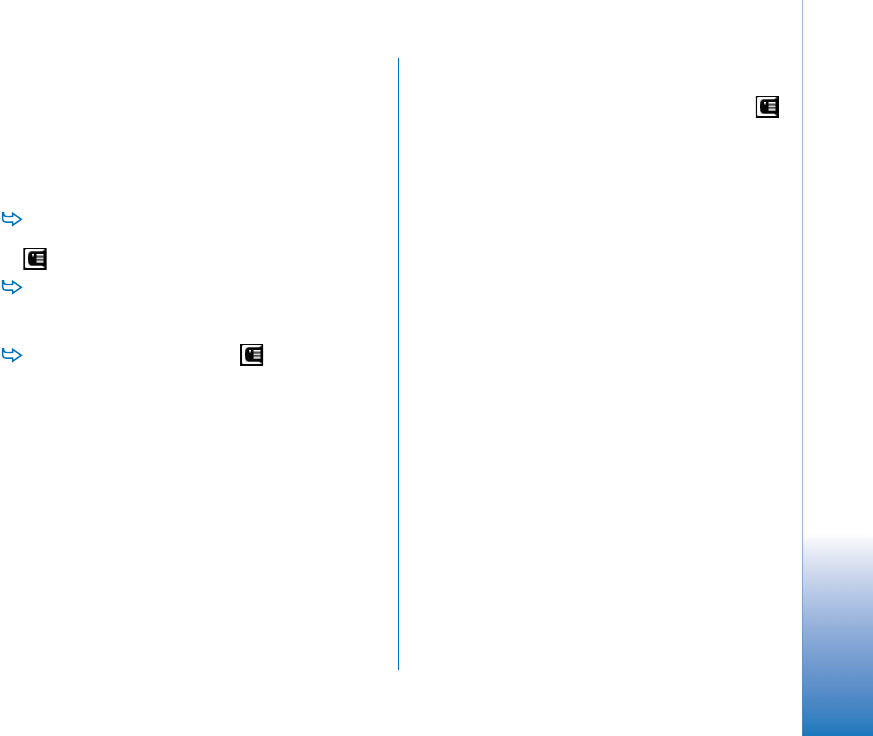
Connectivity
126
FCC
Remote configuration takes place over a GSM data call or
GPRS connection.
The Remote configuration application uses SyncML Device
Management version 1.1.1 technology. For information on
Remote Configuration compatibility, please contact the
supplier of configuration solution you want to manage
your media device settings with.
To start a configuration session, open the Device
manager application. Select a profile from the list, press
and select Configuration > Start.
To view configuration log, tap Log when the
configuration session has ended. The log file shows the
configuration status of the selected profile.
To disable configuration, press and select
Configuration > Disable all. You cannot receive
configuration settings from any of the configuration
servers for which you have a profile. Clear this
command to allow the reception of configuration
settings from those servers for which you have a profile
and have allowed configuration.
Creating a new configuration server
profile
Configuration server profile is the settings for the remote
server. You can create several profiles if you need to access
multiple servers.
You may receive the configuration server profile settings
as a special message from your service provider.
1Open the Device manager application and press .
Select Profile > New.... Choose whether you want to
copy the values from an existing profile to be used as
the basis for the new profile.
2The Profile Wizard opens. Define the following:
Server name: – Write a name for the configuration
server.
Server ID: – Write the unique ID to identify the
configuration server. Contact your service provider or
system administrator for the correct value.
Password: – Write a password to identify your device to
the server. Confirm the password.
Access point: – Select the access point you want to use
for the data connection to the server.
Host address: – Write the URL address of the server.
Contact your service provider or system administrator
for the correct value.
Port: – Write the port number of the server. Contact
your service provider or system administrator for the
correct value.
User name: – Write your user name for the server.
Password: – Write your password for the server and
then confirm it.
Allow configuration: – Select this to allow the server to
initiate a configuration session.
Auto-accept sync requests: – Select this if you do not
want the server to ask for your confirmation when it
initiates a configuration session.

Connectivity
127
FCC
3Tap OK to save the settings.
To edit configuration profile settings, select a profile
and tap Settings.
Data transfer
Go to Desk > Data transfer.
The Data transfer application enables you to synchronise
or copy your calendar or contacts data between your
device and another Bluetooth-enabled mobile phone.
To start data transfer wizard, tap New and follow the
instructions. You can define the type and direction of
transfer and select what to transfer.
Synchronisation
Go to Desk > Sync.
The Sync application enables you to synchronise your
calendar or contacts with various calendar and address
book applications on a compatible computer or on the
Internet. Remote synchronisation takes place over a GSM
data call or GPRS connection, local synchronisation takes
place via a Bluetooth and USB connection.
The Sync application uses SyncML technology (version
1.1.1) for remote synchronisation. For information on
SyncML compatibility, please contact the supplier of the
calendar or address book application you want to
synchronise with your media device.
To synchronise data, open the Sync application, select
a profile from the list and tap Synchronise. You are
notified when the synchronisation has been completed.
To view the synchronisation log, tap View when
synchronisation is complete. The log file shows the
synchronisation status of the selected profile, and how
many calendar or contact entries have been added,
updated, deleted, or discarded (not synchronised) in
the media device or on the server.
Creating a new synchronisation profile
The synchronisation profile is the settings for the remote
server. You can create several profiles if you need to
synchronise your data with multiple servers or
applications.
You may receive the synchronisation settings as a special
message from your service provider.
1Open the Sync application and press . Select Profile
> New.... Choose whether you want to copy the values
from an existing profile to be used as the basis for the
new profile.
2The Profile Wizard opens. Define the following:
Name: — Write a descriptive name for the profile.
Data bearer: — Specify whether you want to
synchronise via the Internet or by using local
connections.
Access point: — Select the access point you want to use
for the data connection.

Connectivity
128
FCC
Host address: — Contact your service provider or system
administrator for the correct value.
Port: — Contact your service provider or system
administrator for the correct value.
User name: — Your user ID for the synchronisation
server. Contact your service provider or system
administrator for your correct ID.
Password: — Write your password and then confirm it.
Contact your service provider or system administrator
for the correct value.
3Select what you want to synchronise: contacts or
calendar entries.
4If necessary, enter the correct path to local calendar or
contacts database. Enter also the correct path to the
remote calendar or address book on the server. Also
specify, the type of synchronisation you want (Normal,
To device only, To server only).
5Tap Finish to save the settings.
To edit synchronisation profile settings, select a
profile and tap Settings. In addition to the settings that
were defined during a profile creation, you can specify
the following:
Allow sync requests: — If you select this, a synchronisation
session can be started automatically by the server.
Auto-accept sync requests: — Select this if you do not want
the server to ask you for your confirmation when it
initiates a synchronisation session.
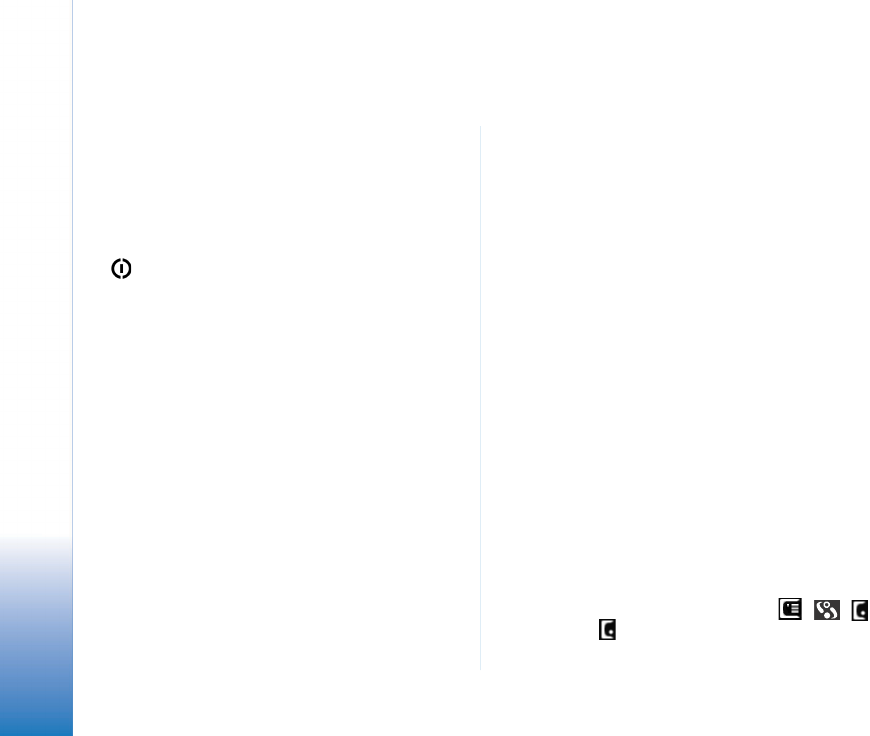
Troubleshooting
129
FCC DRAFT
Troubleshooting
Troubleshooting
•The device does not start.
- Make sure that the battery is properly installed and
charged.
- Make sure that the contacts on the battery are clean.
- Try to switch on the device by pressing the power key
for several seconds.
- Remove the battery, wait for at least ten seconds,
and replace the battery.
•The screen or phone keys flash when I try to charge
the battery.
- Make sure that the battery is properly installed.
•The battery does not recharge properly.
- Make sure that the connector is firmly in place and
the power outlet that you are using is working.
- Your battery may be at the end of its life cycle or
faulty. Contact your local Nokia dealer.
- While charging, do not use features such as Web
browser or RealOne player, which consume a lot of
power. Too many power-consuming activities may
prevent the battery from charging properly.
•Missing, discoloured, or bright dots appear on the
screen every time I turn on the device.
- This is normal characteristic of this type of screen.
•The touch screen feels inaccurate.
- Calibrate the screen. Use the scroll key to open the
Control Panel application, select Screen calibration and
follow the instructions.
•The applications and power key do not respond.
- Remove the battery, wait for at least ten seconds and
replace the battery.
- Try charging the device.
If the procedures described above do not help, as a last
resort before contacting your local dealer you can try
formatting the internal memory of the device. Note
that formatting the memory removes all items
except the standard applications that have been
factory pre-installed in ROM memory!
If you have made a back-up to a memory card, see
“Managing memory cards” on page 117.
When you format the internal memory, all the settings,
documents, and other data in the internal memory that
you have created or modified will be permanently
destroyed. To format the internal memory, proceed as
follows:
1Disconnect the charger and remove the battery.
2Wait for at least ten seconds and insert the battery
to start the device.
3When you see the Nokia Welcome screen,
immediately press and hold down the + +
keys. The key should be pressed last.
4Confirm that you want to format. Formatting starts.

Troubleshooting
130
FCC
•I cannot make or receive calls.
- Check to see if you have the Flight profile selected.
When this profile is active, you cannot make or receive
calls.
- If you can only open Telephone to make emergency
calls, your SIM card is not inserted.
- Check the status of your call barrings and diverts.
Open the Telephone application, press and select
Tools > Settings > Call barring... or Call divert....
- The device may be busy: data is being sent or
received, or the device is being used as a fax modem.
Wait for data transmission to end, or end the data call.
•The call quality is poor.
- Your location may not allow better call quality. Move
to a location where the radio signal reception is better.
Reception is usually better above ground level,
outdoors and while stationary. Sometimes even
moving the device slightly will improve reception.
•I cannot divert or bar voice or data calls.
- You may have not subscribed to the service in
question, or it may not be supported by the network.
- Make sure that the message centre number and the
number to which you want to divert your calls are not
missing or incorrect.
•I cannot send or receive messages or e-mail.
- You may have not subscribed to the service in
question, or it may not be supported by the network.
- Make sure you have configured the relevant settings.
- The device may be low on memory.
- The number format you use may be invalid.
- The device may be busy: data is being sent or
received, or the device is being used as a fax modem.
Wait for the data transmission to end, or drop the data
call.
•I cannot send multimedia messages.
.
- You may have not subscribed to the service in
question, or it may not be supported by the network.
- Make sure you have configured the relevant settings.
- The device may be low on memory.
- If you get an error message when inserting a media
clip to a message, check that the Multimedia mode
setting in Multimedia message settings, General page
is not set to Restricted mode:.
•I cannot end a Bluetooth connection.
- If another device is pairing with your media device
and leaves the connection open without sending any
data, disconnect by deactivating the Bluetooth link
altogether. Open the Control panel application and
select Bluetooth. Clear the Switch Bluetooth on: check
box.
•I cannot find another Bluetooth-enabled device.
- Check that both devices have activated Bluetooth.
- Check that the distance between the two devices is
not over 10 metres or that there are no walls or other
obstructions between the devices.
- Check that the other device is not in “hidden” mode.
•The device is running low on memory.
- Check if you have received a lot of e-mail or you have
saved large images or other items that use a lot of

Troubleshooting
131
FCC
memory. To free up device memory, remove
unnecessary data, move large items to a memory card
or, if possible, transfer them to a compatible PC. To
check the memory consumption, open the Control
panel application and select Memory.
•I have PC connectivity problems.
- Make sure that PC Suite for Nokia 7710 is installed
and running on your PC. See the PC Suite Guide for
more information.
- If you use a cable connection, check that the cable is
properly attached at both ends.
If you use a Bluetooth connection, check that the PC is
Bluetooth compatible and has installed and activated
Bluetooth drivers.
- For all other PC Suite problems, see the PC Suite
Guide and the PC Suite online help.
•I don’t know what my access codes are.
- The default lock code for your device is 12345. If you
forget or lose the lock code contact your device dealer.
- If you forget or lose the PIN or PUK code, or if you
have not received such a code, contact your network
service provider.

Battery information
132
FCC DRAFT
Battery information
Charging and Discharging
Your device is powered by a rechargeable battery. The full
performance of a new battery is achieved only after two or
three complete charge and discharge cycles. The battery can
be charged and discharged hundreds of times but it will
eventually wear out. When the talk and standby times are
noticeably shorter than normal, buy a new battery. Use only
Nokia approved batteries, and recharge your battery only with
Nokia approved chargers designated for this device.
Unplug the charger from the electrical plug and the device
when not in use. Do not leave the battery connected to a
charger. Overcharging may shorten its lifetime. If left unused,
a fully charged battery will lose its charge over time.
Temperature extremes can affect the ability of your battery to
charge.
Use the battery only for its intended purpose. Never use any
charger or battery that is damaged.
Do not short-circuit the battery. Accidental short-circuiting
can occur when a metallic object such as a coin, clip, or pen
causes direct connection of the positive (+) and negative (-)
terminals of the battery. (These look like metal strips on the
battery.) This might happen, for example, when you carry a
spare battery in your pocket or purse. Short-circuiting the
terminals may damage the battery or the connecting object.
Leaving the battery in hot or cold places, such as in a closed
car in summer or winter conditions, will reduce the capacity
and lifetime of the battery. Always try to keep the battery
between 15°C and 25°C (59°F and 77°F). A device with a hot
or cold battery may not work temporarily, even when the
battery is fully charged. Battery performance is particularly
limited in temperatures well below freezing.
Do not dispose of batteries in a fire! Dispose of batteries
according to local regulations. Please recycle when possible.
Do not dispose as household waste.

CARE AND MAINTENANCE
133
FCC DRAFT
CARE AND MAINTENANCE
Your device is a product of superior design and craftsmanship
and should be treated with care. The suggestions below will
help you protect your warranty coverage.
• Keep the device dry. Precipitation, humidity and all types
of liquids or moisture can contain minerals that will
corrode electronic circuits. If your device does get wet,
remove the battery and allow the device to dry completely
before replacing it.
• Do not use or store the device in dusty, dirty areas. Its
moving parts and electronic components can be damaged.
• Do not store the device in hot areas. High temperatures
can shorten the life of electronic devices, damage
batteries, and warp or melt certain plastics.
• Do not store the device in cold areas. When the device
returns to its normal temperature, moisture can form
inside the device and damage electronic circuit boards.
• Do not attempt to open the device other than as instructed
in this guide.
• Do not drop, knock, or shake the device. Rough handling
can break internal circuit boards and fine mechanics.
• Do not use harsh chemicals, cleaning solvents, or strong
detergents to clean the device.
• Do not paint the device. Paint can clog the moving parts
and prevent proper operation.
• Use a soft, clean, dry cloth to clean any lenses (such as
camera, proximity sensor, and light sensor lenses).
• Use only the supplied or an approved replacement
antenna. Unauthorised antennas, modifications, or
attachments could damage the device and may violate
regulations governing radio devices.
All of the above suggestions apply equally to your device,
battery, charger, or any enhancement. If any device is not
working properly, take it to the nearest authorised service
facility for service.

ADDITIONAL SAFETY INFORMATION
134
FCC DRAFT
ADDITIONAL SAFETY INFORMATION
Operating environment
Remember to follow any special regulations in force in any
area and always switch off your device when its use is
prohibited or when it may cause interference or danger. Use
the device only in its normal operating positions.
This device meets RF exposure guidelines when used either in
the normal use position against the ear or when positioned at
least 7/8 inch (2.2 cm) away from the body. When a carry
case, belt clip, or holder is used for body-worn operation, it
should not contain metal and should position the device at
least 7/8 inch (2.2 cm) away from your body.
In order to transmit data files or messages, this device
requires a quality connection to the network. In some cases,
transmission of data files or messages may be delayed until
such a connection is available. Ensure the aboveseparation
distance instructions are followed until the transmission is
completed.
Medical devices
Operation of any radio transmitting equipment, including
wireless phones, may interfere with the functionality of
inadequately protected medical devices. Consult a physician
or the manufacturer of the medical device to determine if
they are adequately shielded from external RF energy or if you
have any questions. Switch off your device in health care
facilities when any regulations posted in these areas instruct
you to do so. Hospitals or health care facilities may be using
equipment that could be sensitive to external RF energy.
Pacemakers: Pacemaker manufacturers recommend that a
minimum separation of 6 in. (15.3 cm) be maintained between
a wireless phone and a pacemaker to avoid potential
interference with the pacemaker. These recommendations are
consistent with the independent research by and
recommendations of Wireless Technology Research. Persons
with pacemakers should:
• always keep the device more than 6 in. (15.3 cm) from their
pacemaker when the device is switched on;
• not carry the device in a breast pocket; and
• hold the device to the ear opposite the pacemaker to
minimise the potential for interference.
If you have any reason to suspect that interference is taking
place, switch off your device immediately.
Hearing aids: Some digital wireless devices may interfere
with some hearing aids. If interference occurs, consult your
service provider.
Vehicles
RF signals may affect improperly installed or inadequately
shielded electronic systems in motor vehicles such as
electronic fuel injection systems, electronic antiskid (antilock)
braking systems, electronic speed control systems, air bag
systems. For more information, check with the manufacturer

ADDITIONAL SAFETY INFORMATION
135
FCC
or its representative of your vehicle or any equipment that has
been added.
Only qualified personnel should service the device, or install
the device in a vehicle. Faulty installation or service may be
dangerous and may invalidate any warranty that may apply to
the device. Check regularly that all wireless device equipment
in your vehicle is mounted and operating properly. Do not
store or carry flammable liquids, gases, or explosive materials
in the same compartment as the device, its parts, or
enhancements. For vehicles equipped with an air bag,
remember that air bags inflate with great force. Do not place
objects, including installed or portable wireless equipment in
the area over the air bag or in the air bag deployment area. If
in-vehicle wireless equipment is improperly installed and the
air bag inflates, serious injury could result.
Using your device while flying in aircraft is prohibited. Switch
off your device before boarding an aircraft. The use of wireless
teledevices in an aircraft may be dangerous to the operation
of the aircraft, disrupt the wireless telephone network, and
may be illegal.
Potentially explosive environments
Switch off your device when in any area with a potentially
explosive atmosphere and obey all signs and instructions.
Potentially explosive atmospheres include areas where you
would normally be advised to turn off your vehicle engine.
Sparks in such areas could cause an explosion or fire resulting
in bodily injury or even death. Switch off the device at
refuelling points such as near gas pumps at service stations.
Observe restrictions on the use of radio equipment in fuel
depots, storage, and distribution areas, chemical plants or
where blasting operations are in progress. Areas with a
potentially explosive atmosphere are often but not always
clearly marked. They include below deck on boats, chemical
transfer or storage facilities, vehicles using liquefied
petroleum gas (such as propane or butane), and areas where
the air contains chemicals or particles such as grain, dust or
metal powders.
Emergency calls
Important:Wireless phones, including this device,
operate using radio signals, wireless networks, landline
networks, and user-programmed functions. Because of this,
connections in all conditions cannot be guaranteed. You
should never rely solely on any wireless device for essential
communications like medical emergencies.
To make an emergency call:
1If the device is not on, switch it on. Check for adequate
signal strength.
2 Press and hold to show the phone keypad on the
screen.
3Key in the official emergency number for your present
location. Emergency numbers vary by location.
4Press the key.
WARNING: With Flight profile you cannot make (or
receive) any calls, including emergency calls, or use other
features that require network coverage. To make calls,
first activate the phone function by changing the profile.
If the device has been locked, enter the lock code.

ADDITIONAL SAFETY INFORMATION
136
FCC
If you need to make an emergency call while the device is
locked and in flight profile, you may be able to enter an
emergency number preprogrammed in your device at the lock
code field and tap Call. The device will confirm that you are
about to exit flight profile to start an emergency call.
Consult this guide or your service provider for more
information.
Some networks may require that a valid SIM card is properly
inserted in the device.
When making an emergency call, give all the necessary
information as accurately as possible. Your wireless device
may be the only means of communication at the scene of an
accident. Do not end the call until given permission to do so.
Certification information (SAR)
THIS DEVICE MEETS THE GOVERNMENT’S REQUIREMENTS
FOR EXPOSURE TO RADIO WAVES.
Your mobile device is a radio transmitter and receiver. It is
designed and manufactured not to exceed the limits for
exposure to radio frequency (RF) energy adopted by the
governments of the USA through the Federal
Communications Commission (FCC) and Canada through
Industry Canada (IC). These limits establish permitted levels
of RF energy for the general population. The guidelines are
based on standards that were developed by independent
scientific organizations through periodic and thorough
evaluation of scientific studies. The standards include a
substantial safety margin designed to assure the safety of all
persons, regardless of age and health.
The exposure guidelines for mobile devices employ a unit of
measurement known as the Specific Absorption Rate or SAR.
The SAR limit adopted by the USA and Canada is 1.6 watts/
kilogram (W/kg) averaged over one gram of tissue. The limit
incorporates a substantial margin of safety to give additional
protection for the public and to account for any variations in
measurements. Tests for SAR are conducted using standard
operating positions with the device transmitting at its highest
certified power level in all tested frequency bands. The actual
SAR level of an operating device can be well below the
maximum value because the device is designed to use only the
power required to reach the network. That amount changes
depending on a number of factors such as how close you are
to a network base station.
The highest SAR value reported to the FCC and IC for this
device type when tested for use at the ear is 0.22 W/kg,
and when properly worn on the body is 0.54 W/kg. SAR
information on file with the FCC can be found under the
Display Grant section of http://www.fcc.gov/oet/fccid
after searching on FCC ID LJPRM-12. SAR values reported
in other countries may vary depending on differences in
reporting and testing requirements and the network band.
Additional SAR information may be provided under
product information at http://www.nokia.com.

ADDITIONAL SAFETY INFORMATION
137
FCC

138
FCC DRAFT
Index
A
access codes 24, 114
access points 30
setting up 107
accessories 106
adjusting volume 25
ringing volume 44
advanced Internet settings 108
alarms 98
calendar 64
answering calls 37
appearance
personalising 115
Application manager 102
applications
groups 32
installing 27
opening 19
removing 102
viewing details of 102
attachments
e-mail 51
authenticating Bluetooth devices 123
auto-capitalisation 33
autolock period 114
B
background images 31
backing up data 117
barring
calls 39
data calls 105
barring password 24, 115
basic functions 20
battery
charging 16
information 132
installing 13
removing 14
status indicators 22
Bluetooth
synchronisation 127
Bluetooth connections 122
authenticating 123
pairing 123
receiving data 123
sending data 123
bookmarks 70
browser
See Web
browsing the web 69
C
cache 70
Calculator 100
Calendar 64
alarm 64
day view 64
entries 64
icons 66
synchronising 127
week view 65
calibrating screen 115
call barring 39, 105
call diverting 38
calling 36
callsadjusting volume 37
answering 37
barring 39
conference calls 37
data calls 30
diverting 38
duration 119
recent calls 118
rejecting 37
settings 38
speed dialling 36
voice dialling 38
voice mailbox 37
Camera 73
settings 74
taking pictures 73

139
FCC DRAFT
capitalisation 33
CBS 120
settings 121
topic lists 120
CD-ROM 125
Cell broadcast (CBS) 120
settings 121
topic lists 120
certificate manager 103
charging battery 16
charts 95
chartsheets 95
Clock 98
alarms 98
cities 99
codes 24, 114
autolock period 114
barring password 115
lock code 114
PIN codes 114
PUK code 114
column width 95
command buttons 19
common functions 21
conference calls 37
connectivity 122
Bluetooth 122
compatible computers 124
modems 125
PC Suite 125
synchronisation 127
connectors 12
contact cards 60
contact group 62
copying from SIM card 18
copying to and from SIM card 62
creating 60
editing 60
fields 61
personal ringing tones 61
sending 62
SIM contact cards 61
speed dial numbers 61
voice tags 62
Contacts 60
See also contact cards
synchronising 127
Control panel 102
controls 12
cookies 72
copying data
from other devices 125
currency format 113
D
dataaccess points 30, 107
connection indicators 23
connections 30
copying 125
counters 119
data call barring 105
data calls 29, 30
GSM 29
high-speed 29
data connections 29
Data transfer 127
dateformat 112, 113
inserting 92
settings 105
Desk 31
groups 32
key 12
returning to 19
desk calculator 100
device language 115
Device manager 125
settings 126
digital certificates 103
display
parts 18
See screen
settings 106
diverting calls 38
data and fax calls 39
Documents 92
See also text documents
drawing
tools 80
transformations 80

140
FCC DRAFT
DTMF tones 41
E
editing
images 79
e-mail
access points 107
attachments 51
formatting 51
Inbox 45
Outbox 46
replying 49
retrieving from mailbox 49
sending 50
settings 47
enhancements 106
event log 118
F
fetching e-mail 49
File Manager 116
files.JAD and .JAR files 26
.SIS files 26
managing 116
Find 21
Flight profile 43
folders
managing 116
formatting
e-mail 51
formatting worksheets 95
frames 71
freeing memory 25
functions
basic 20
common 21
G
GPRS 29, 30
data counters 119
Internet connection settings 110
pricing 29
groups
applications 32
contact cards 62
to-do notes 67
GSM data calls 29
H
handsfree 26
handwriting recognition 33
individual style 34
headset 26
settings 106
high-speed data (HSCSD) 30
high-speed data calls 29
home city 99
HSCSD 29
I
icons
battery level 22
calendar 66
data connections 23
signal strength 22
status area 22
to-do notes 67
Images
background images 31
drawing tools 80
editing 79
organising 77
settings 79
Inbox 46
symbols 45
indicators
Seeicons
input
See writing
inserting
date 92
inserting special characters 92, 94
installation log 103
installing
applications and software 26
battery 13
memory cards 15
SIM card 13
Internet
access point settings 107
access requirements 107
connection settings 110
See also Web

141
FCC DRAFT
IP addresses 109
J
Java applications 26
installing 27
K
keyboard 34
keyguard 25
keys 12
locking 25
L
language selection 115
location method 111
lock code 24, 114
entering 17
locking
touch screen and keypad 25
Log 118
call duration 119
GPRS data counter 119
recent calls 118
login scripts 109
loopset settings 106
loudspeaker 26
M
mailSee e-mail
mailbox settings 47
making calls 36
marking items 19
memory 24
available 111
cache 70
memory cards 117
backing up data 117
installing 15
removing 15
renaming 117
restoring data 117
menu 19
key 12
Messaging 45
e-mail
Inbox 46
multimedia messages 55
Outbox 46
scheduling 51
service messages 59
signatures 52
smart messages 58
text messages 52
MMS
See multimedia messages
modems 125
multimedia messages 55
adding pages 55
creating 55
receiving 57
restricted mode 58
settings 57
Music player 84
track lists 86
transferring tracks from PC 84
N
navigating 19
web 69
number format 113
O
Offline mode 43
on-screen keyboard 34
opening
applications 19
Desk 19
menu 19
organising images 77
Outbox 46
P
packet data 29
pairing Bluetooth devices 123
paragraph styles 93
partsof device 12
of display 18
passwords 24
PC Suite 125
pen input settings 35
personal ringing tones 61
personalising 115
phone 36

142
FCC DRAFT
See also calls
photographs
camera 73
PIN code 24
PIN code request 114
PIN codes
changing 114
entering 17, 114
play lists 86
playing
music 84
video clips 81
positioning settings 111
power
switching on and off 16
PPP compression 110
Presentations 97
pricing
GPRS and applications 29
privacy settings 111
Profiles 43
editing 44
Flight profile 43
proxy settings 108
PUK code 24, 114
R
RealPlayer 81
settings 112
recent calls 118
recording voice memos 90
regional settings 113
rejecting calls 37
remote configuration 125
settings 126
remote mailbox 47
remote synchronisation 127
settings 127
removing
applications 102
battery 14
memory cards 15
renaming memory cards 117
replying to e-mail 49
restoring data 117
restricted mode 58
restricting calls 39
retrieving e-mail 49
returning to Desk 19
ringing tones 44
ringing volume 44
row height 95
S
screen
calibrating 115
command buttons 19
locking 25
parts of 18
settings 106
toolbars 18, 19
screen saver 18, 106
searching 21
security
certificates 103
codes 114
selecting items 19
sending
contact cards 62
data via Bluetooth 123
e-mail 50
multimedia messages 55
text documents 92
text messages 52
service messages 59
settings
Camera 74
cell broadcast 121
currency format 113
date and time 105
date format 112, 113
display 106
e-mail 47
images 79
Internet access point 107
multimedia messages 57
number format 113
phone 38
regional 113
remote configuration 125
screen 106
themes 115

143
FCC DRAFT
time format 113
touch screen 115
voice mailbox 40
Voice recorder 91
web browser 71
Sheet 94
short messages
See text messages
shortcuts 31
signal strength indicators 22
SIM card
installing 13
slides 97
smart messages 58
SMSwriting and sending 46
software
authenticity 103
installing 27
removing 102
viewing details of 102
sound
turning off 20
sound clips 90
special characters
inserting 92, 94
speed dialling 36, 61
start-up 17
status icons 22
stickers 24
switching on and off 16
Sync 127
settings 127
T
taking pictures 73
tapping 19
tasks 67
Telephone 36
diverting data and fax calls 39
DTMF tones 41
See also calls
text documents 92
editing paragraph styles 93
inserting date 92
inserting special characters 92, 94
sending 92
text messages 52
receiving 53
sending 52
settings 54
Themes 115
till roll calculator 100
timeformat 113
settings 105
To-do 67
icons 67
toolbars 18, 19
topic lists for CBS 120
touch screen
locking 25
settings 115
track lists 86
tracks
transferring from PC 84
training
handwriting 34
transferring
contact cards 18
data from other devices 125
troubleshooting 129
formatting memory 129
U
unlocking touch screen 25
V
video player 81
viewing
images 77
presentations 97
Visual Radio content 88
Visual Radio 87
viewing content 88
visual service ID 88
visual servce ID 88
voice dialling 38, 62
voice mailbox
calling 37
settings 40
Voice recorder 90
settings 91

144
FCC DRAFT
voice tags 62
volume
adjusting while calling 37
volume control 25
volume controls 25
W
wallpaper 31
Web 68
advanced settings 108
bookmarks 70
browser settings 71
browsing 68
cache 70
cookies 72
data call settings 108
details 70
frames 71
IP addresses 109
login scripts 109
navigating 69
other settings 110
proxy settings 108
workbooks 94
worksheets 94
formatting 95
World Wide Web
See Web
writing 33
handwriting recognition 33
on-screen keyboard 34
pen input settings 35